Get started
- Project management
- CRM and Sales
- Work management
- Product development life cycle
- Comparisons
- Construction management
- monday.com updates

What is a task? and how to get more of them done
While the word “task” might bring about feelings of despair related to chores or undesirable actions, this is usually related more so to the way you have to manage your time than the task itself.
In this article, we’ll do a deep dive into tasks, show you the best ways to break down larger projects into them, while covering efficient approaches to manage and distribute tasks.
Try monday.com
What is a task in a project?
In project management, a task is a work item or activity with a specific purpose related to the larger goal. It’s a necessary step on the road towards project completion.
For example, it could be something as complex as a mobile app bug fix.
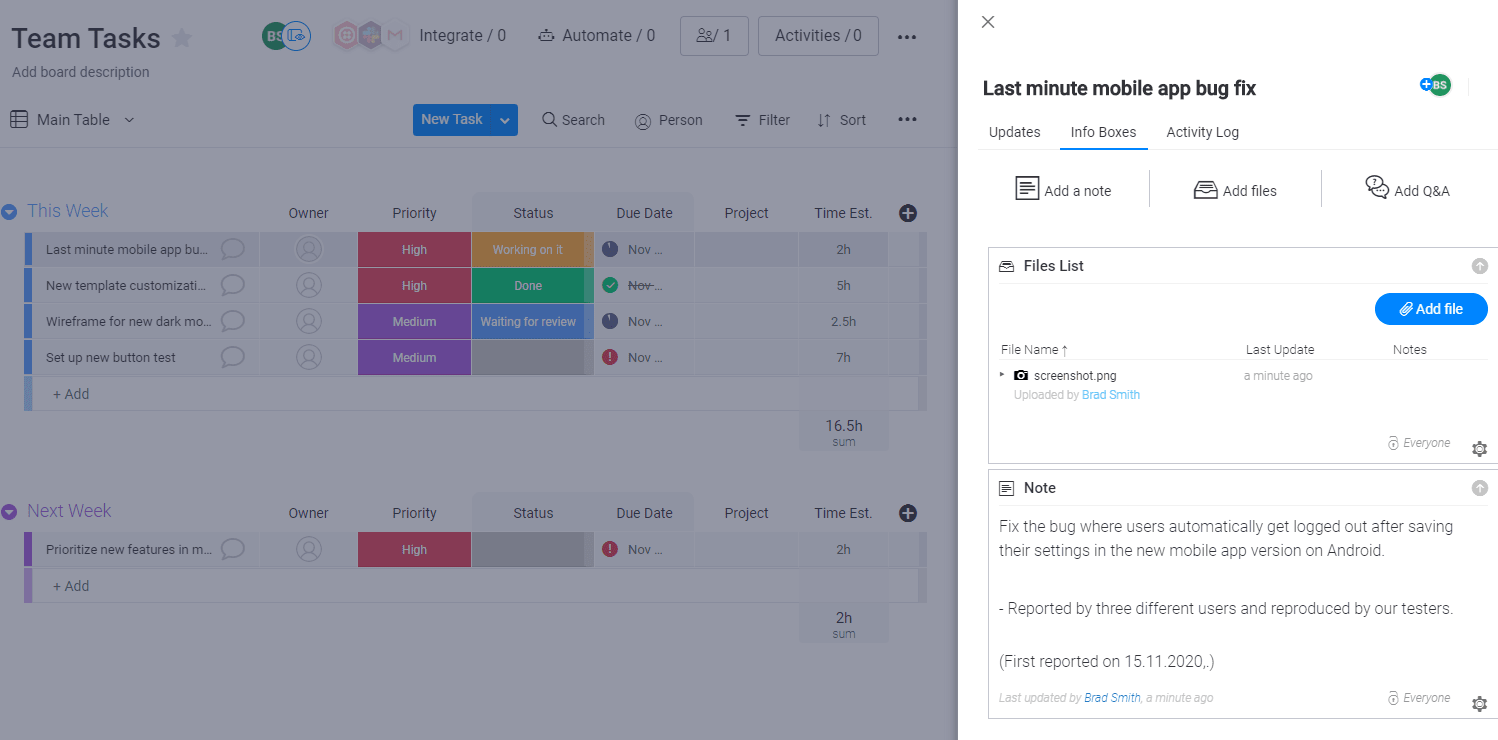
Or it could be something as simple as photocopying the latest brochure for distribution.
Single tasks are typically assigned to a single person or team, while the larger project could be a company-wide endeavor.
The task may or may not include a start and end date or a series of subtasks—this all depends on the complexity of the project at hand, which could be related to industry.
How do you break down a project into smaller tasks?
Even long term Scrum projects that last 11.6 weeks on average make use of task management to get their work done efficiently and effectively.
Part of task management includes creating manageable workloads, considering task dependencies, and of course, communicating across teams to avoid double work or roadblocks.
To avoid these issues, you need some way to break down the high-level project deliverables and goals into tangible tasks.
In the next section, we’ll show you two of the most popular methodologies, Waterfall, and Scrum.
Work Breakdown Structure
The work breakdown structure (WBS) is the official method of breaking down projects in the PMI Guidebook.
To figure out how to break the entire project into tasks, you first need to divide it into the actual deliverables required to hand over the final product or result to the client.
For example, if you’re planning to make a mountain bike, you can break that down into the frame, handlebars, pedals, wheels, chains, and so on.
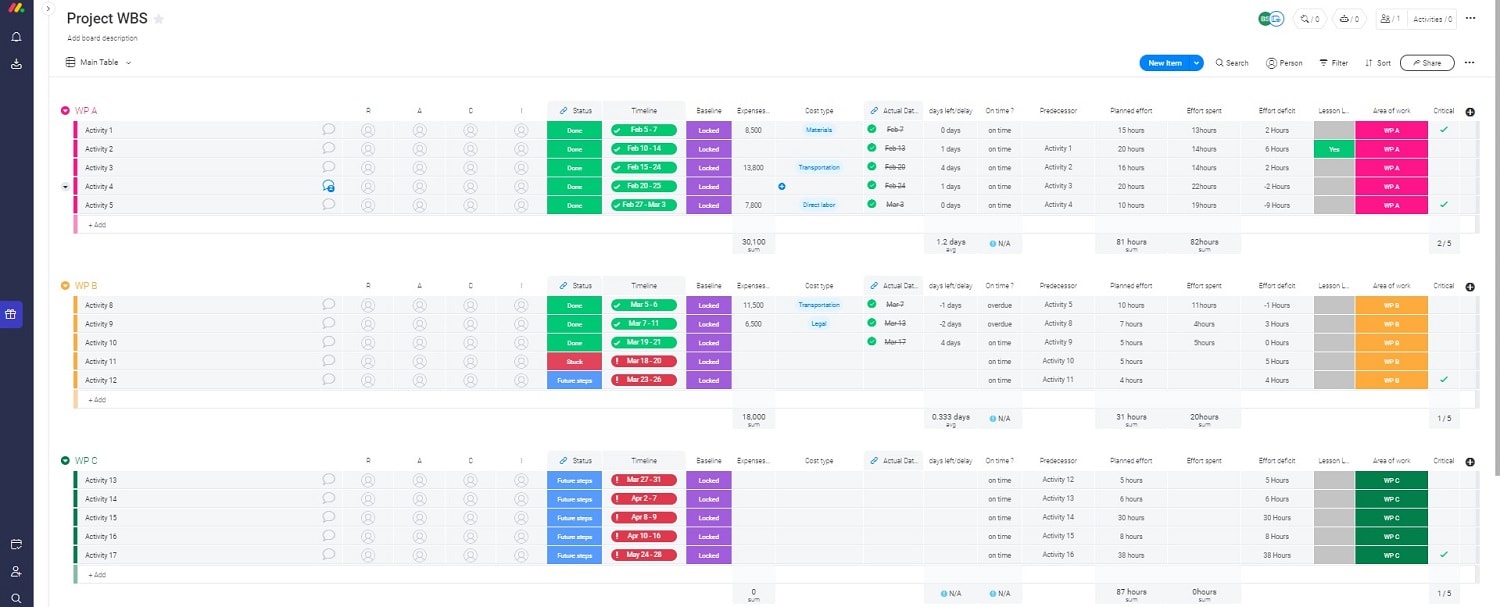
( Image Source )
You also need to work out the dependencies of the project (aka which deliverables require another one for completion).
If we were to simplify the WBS, the section on manufacturing the bike frame might look something like this.

Of course, each item contains multiple tasks such as sourcing vendors, reviewing designs, picking materials, and more.
But if you assign these tasks to teams who have the necessary skills to complete all of them, that’s what the top-level plan might look like.
If you use an Agile framework, like Scrum, you won’t bother breaking down the entire project into detailed tasks at an early stage. Avoiding this large-scale exercise in prediction is one of the primary principles of Agile.
Instead, you’ll focus on planning out a deliverable increment of your product in Scrum sprints . These are 2–4 week periods of focused work dedicated to delivering a working product version of the final deliverable.
The basis for planning out these iterations is a backlog of features or user stories (functionality from the user’s perspective). You may also have a product roadmap to outline the long-term product direction as well.
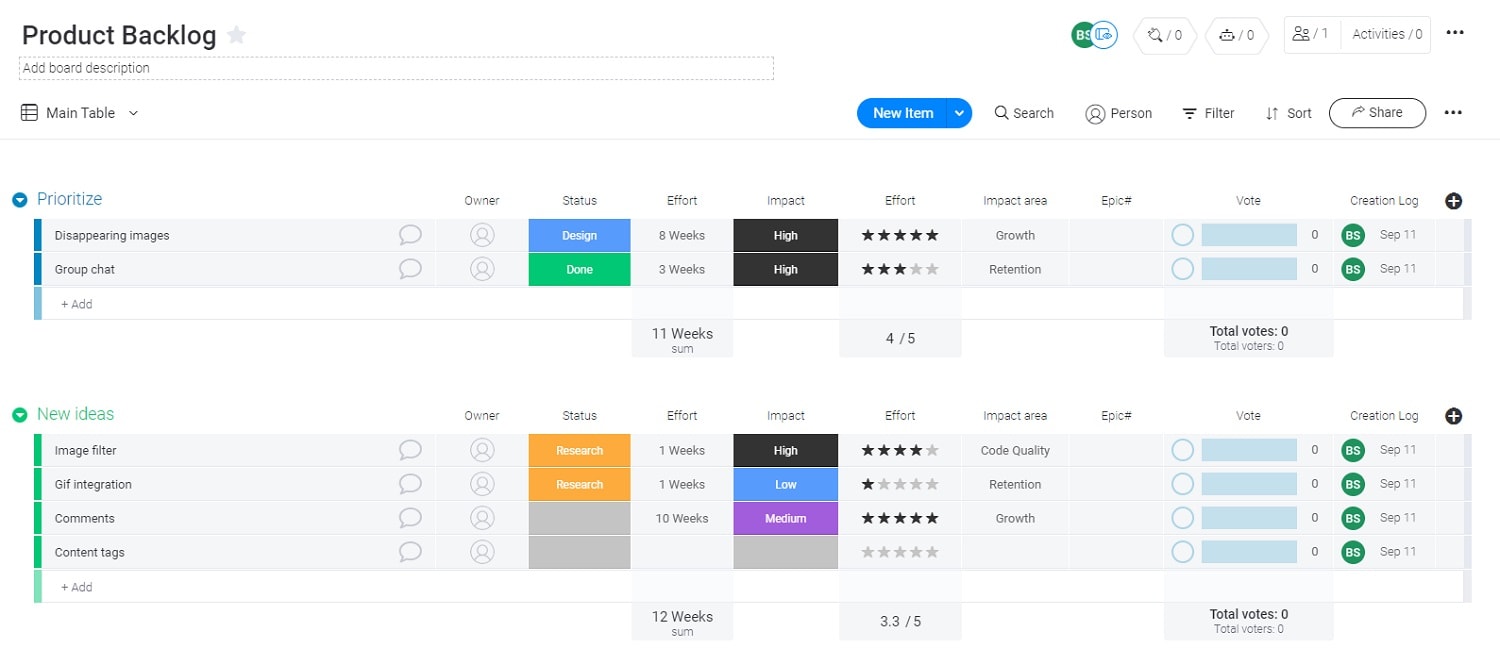
The product backlog is continually pruned and optimized before, during, and after sprints. Even if you’re not planning software projects, you can often single out elements that you can deliver in increments.
Before each Sprint, you meet with your team and stakeholders (invested parties) to discuss which user stories are the most important. You select a few items and create a dedicated sprint backlog.
Each user story is then further divided into tasks, and team members take ownership of the specific tasks they can handle.
It’s not ideal for all organizations or projects, but it’s an antidote against micromanagement in complex projects.
What size should a project task be?
So how granular should you get? What should the scope and length of the task in your project be?
It depends on the size of your project and your PM framework, but here are some rules of thumb.
The 8/80 rule for WBS
In traditional project management, a rule of thumb is that no task should be shorter than 8 hours or longer than 80 hours in the WBS.
That’s why the PMI recommends keeping tasks between 20–80 hours in the WBS.
Your individual teams can then have more granular task boards to manage their own to-do lists and/or break 2-week tasks down into daily sub-tasks.
Task length in Scrum
While user stories generally have no specified length, they’re often broken down into manageable chunks, usually one workday or less.
The official Scrum Guide doesn’t use the word tasks, but instead uses the term work unit:
“ Work planned for the first days of the Sprint by the Development Team is decomposed by the end of this meeting, often to units of one day or less. ”
On a Scrum board , you can use story points (at monday.com, we equate 1 SP to a workday) to estimate the length of the task.
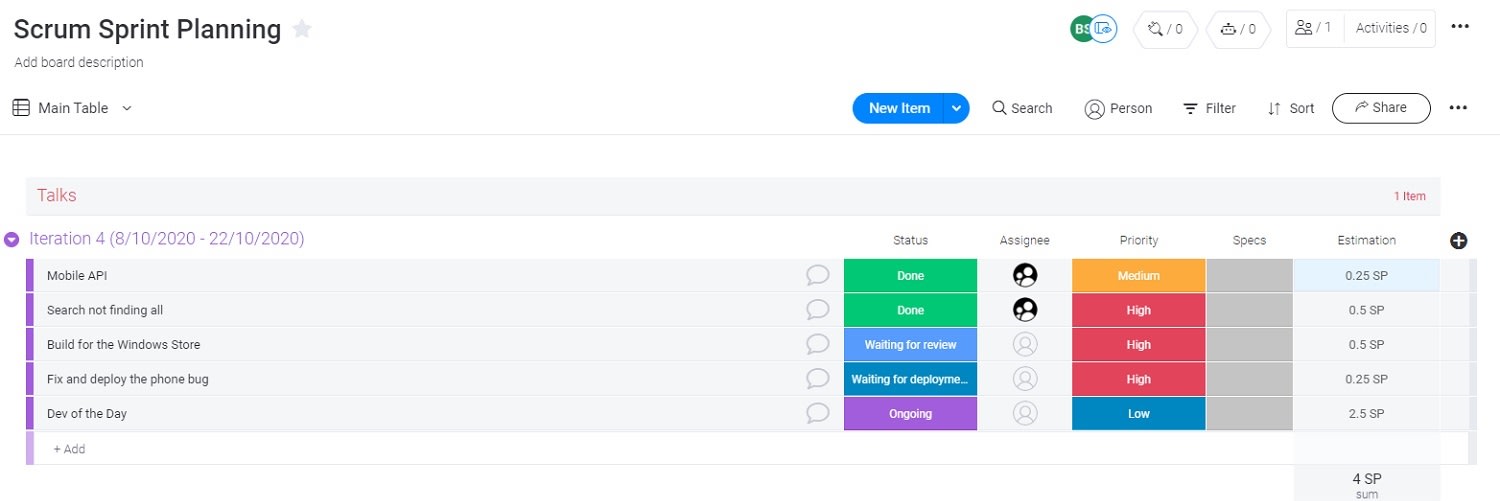
Tasks shouldn’t require more than one resource
When you break down deliverables into individual tasks, time isn’t the only consideration. The best approach is to make sure the person (or resource) who’s assigned the task can complete it from start to finish.
For example, a graphic designer could create a wireframe for an app, but wouldn’t be able to create a working prototype.
So you should split the larger deliverable of a working feature prototype into wireframe/design and development (at the very least).
For larger companies, a resource could be an entire team that includes designers, developers, and software testers. In which case, you don’t have to get as granular when planning and assigning tasks.
Accurately estimating task durations
The best way to predict the duration of tasks is to involve the actual resources who will handle the task in the planning process.
You don’t need to switch to Agile or Scrum to make this happen. You just need to involve the actual project implementers in the planning process, not just management.
Not only can they help with task durations, but they can also help with dependencies and expecting potential bottlenecks.
What is the best way to organize project tasks?
There are hundreds of different frameworks and methods for managing projects and breaking them down into tasks.
A few stand out because of their efficiency and ease of adoption and have become popular as a result.
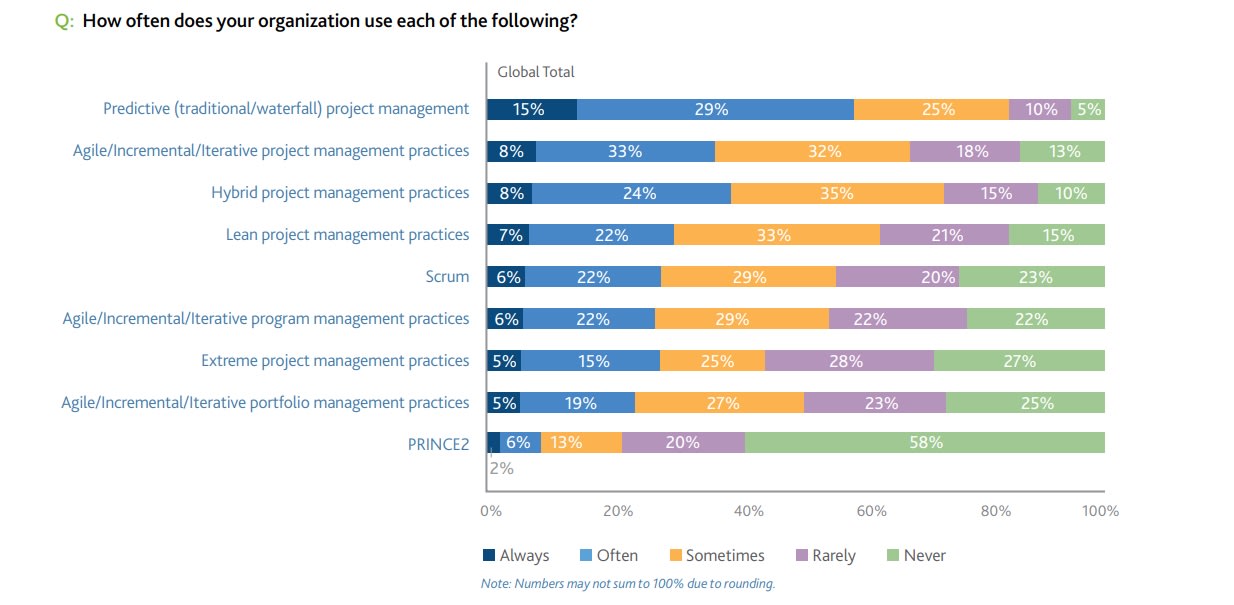
Let’s take a closer look at these industry-leading options.
Waterfall refers to the traditional “predictive” project management approach. It’s called predictive because you plan every phase of the project from start to finish before even getting started.
The reason it’s called waterfall is that the projects are planned to follow a sequential order.
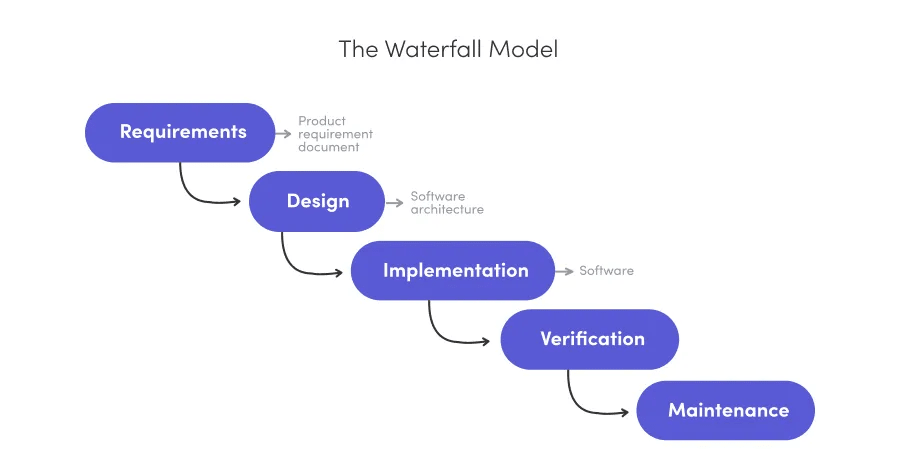
First, you start out by figuring out the requirements of the project. What deliverables do you need to deliver a finished product?
Then you move on to designing and creating (implementing) it. Finally, you verify that the product works as intended, and launch it. The last stage includes the long-term maintenance of the product.
While berating waterfall is a popular pastime among younger management professionals, it has its place.
For physical products with a lot of dependencies and high costs associated with actual production time, mapping out the entire project in detail can be the best approach.
Instead of a specific methodology, Agile outlines a core set of values and principles to apply to your projects. As a result, Agile is an umbrella term that covers many different methodologies and frameworks .
The most famous principle is to deliver working iterations of your project frequently. That’s in contrast to planning out an entire product from start to finish like with waterfall.
Lean, like Agile, is not a specific framework that details a project management approach. Instead, it refers to a management philosophy with a core set of principles.
The focus of Lean is eliminating waste in processes throughout each stage of production. The execution is what controls the outcome, after all.
Fixing bottlenecks between departments to speed up the final assembly is a good example.
Not to be confused with Agile, which is more about high-level concepts and principles, Scrum is an actual framework for project management.
It outlines clear rules, meetings (ceremonies), and deliverables (artifacts), not just values.
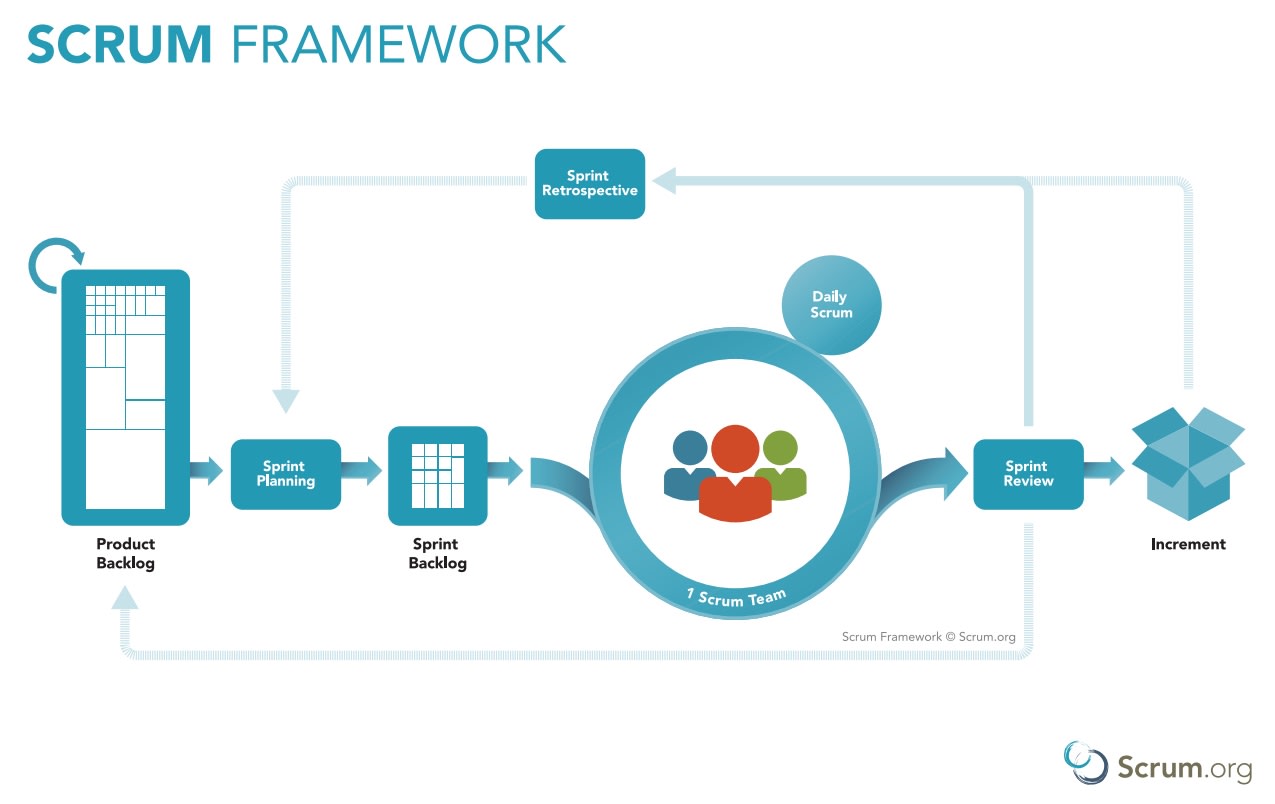
For example, Scrum teams should only include a maximum of 9 regular team members. Daily Scrum meetings should only last 15 minutes.
The entire process of designing and completing a sprint is laid out in detail. That’s what makes the Scrum framework so useful for teams that want to implement more Agile principles into practice.
How to use a project management platform for effective task management
Instead of slowing down your managers and teams with an inefficient process, take advantage of the latest task management software .
monday.com is a digital workspace with all the functionality a project manager could ever want, wrapped in a package that’s actually easy to learn and use.
Pick the framework or methodology you want to work with
If you want to reach a completely new target level of productivity, basic task management won’t cut it. You need to introduce a project management framework that goes beyond daily tasks.
Luckily, monday.com makes it easy to make the switch. We offer dedicated templates for everything from WBS to Scrum.
Develop the high-level project roadmap
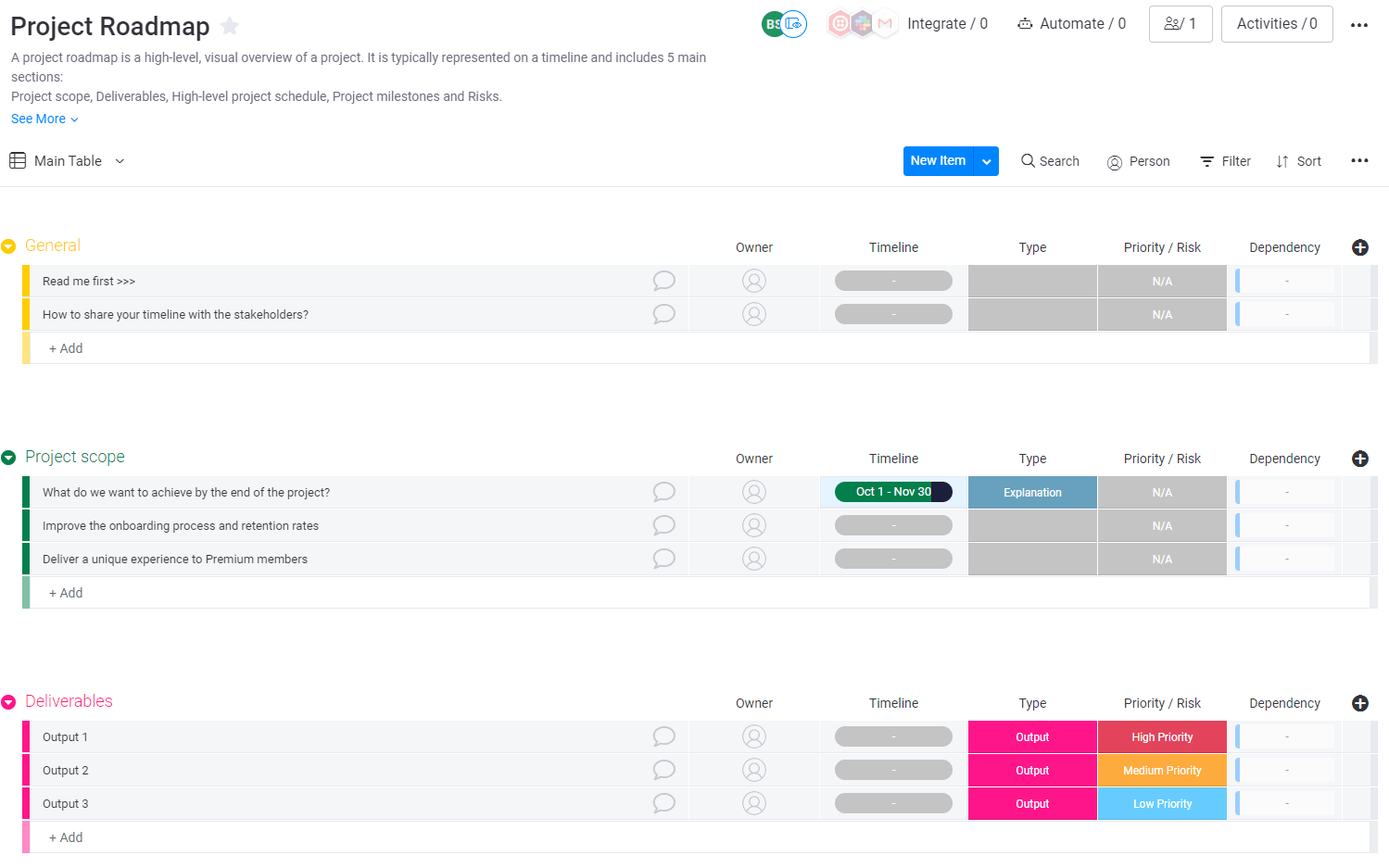
For consistent results, you should develop a high-level project roadmap. It will help guide all decisions and priorities as the project progresses.
Get more granular with a WBS and other task boards
This is where you break the larger goals into smaller deliverables and start to establish the workload for each team or department that’s involved.
It should outline the overall process but may not specify every activity or task, depending on the scale of the project.
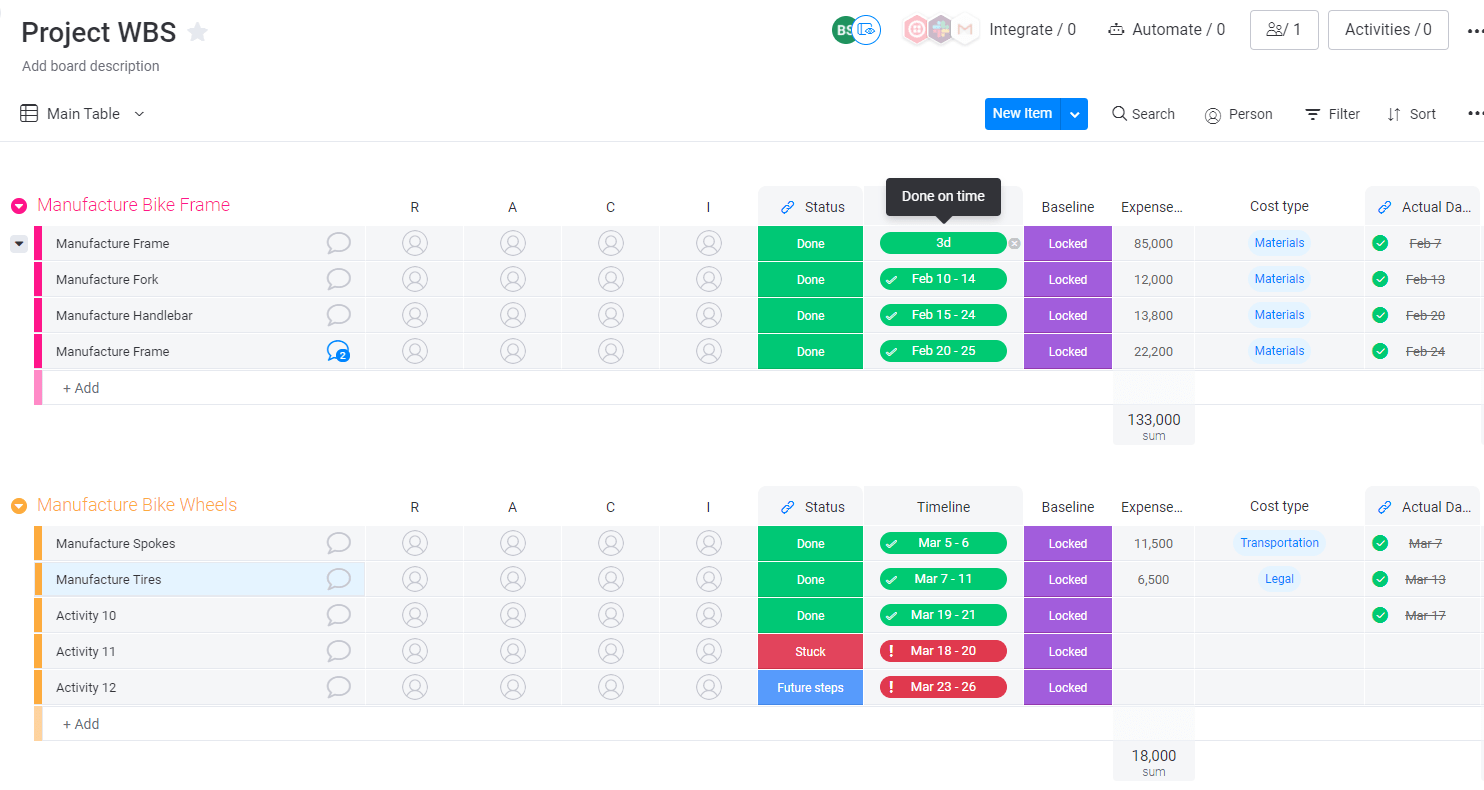
But it’s not the best for planning individual tasks within the involved teams or departments.
Which is why monday.com also offers more basic task boards that these teams can use to manage the day-to-day.
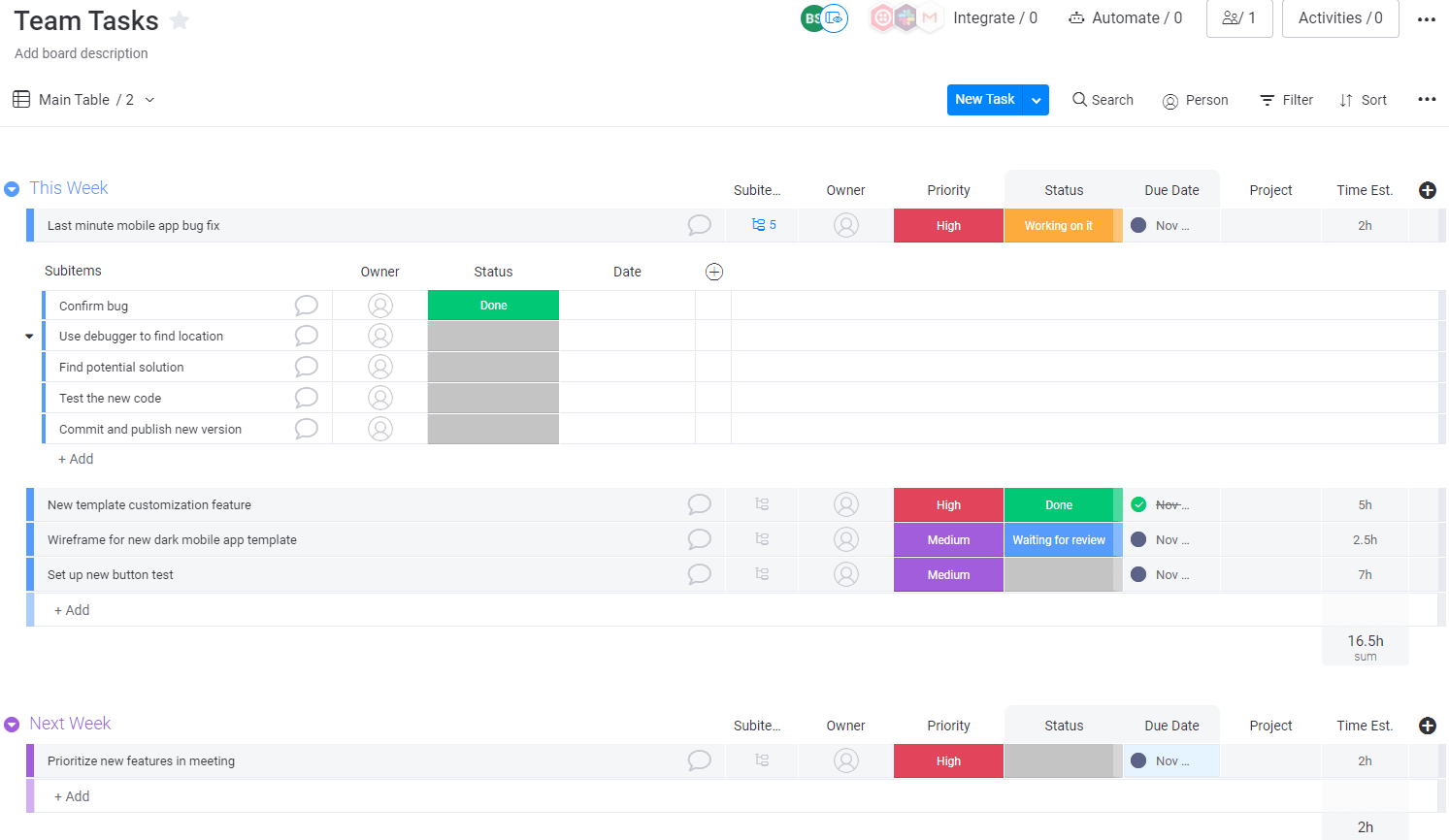
You can easily divide larger items into smaller subtasks and assign them as well.
Use integrations and automations to automate menial tasks
If you want to perfect your workflow , it’s not enough to create some new task boards. You also need to eliminate repetitive menial tasks.
For example, with our smart integrations, you can automatically update a card or create a new task when you receive an email or message.
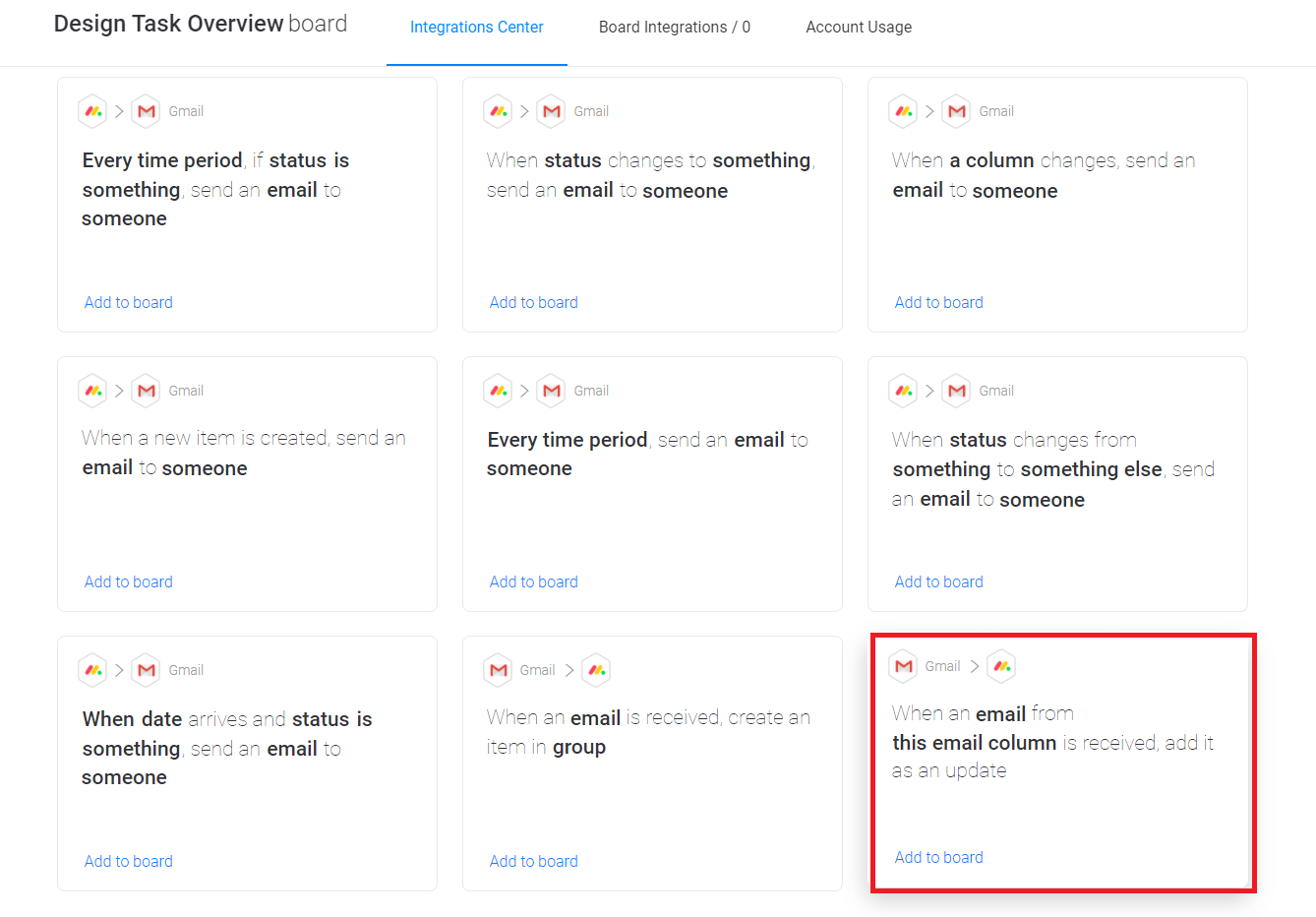
It’s a useful feature for a wide variety of teams and use-cases. For example, your software team could get a new task with every bug report.
By automating menial tasks, you give your managers and team the time and space to focus on crucial high-level decisions.
Keep managers up to speed with dashboards and reports
Want to see at a glance if tasks are being completed on schedule, or which people (or teams) are available for last-minute work?
You can easily create and customize a dashboard that will give your managers instant access to all the information they need.
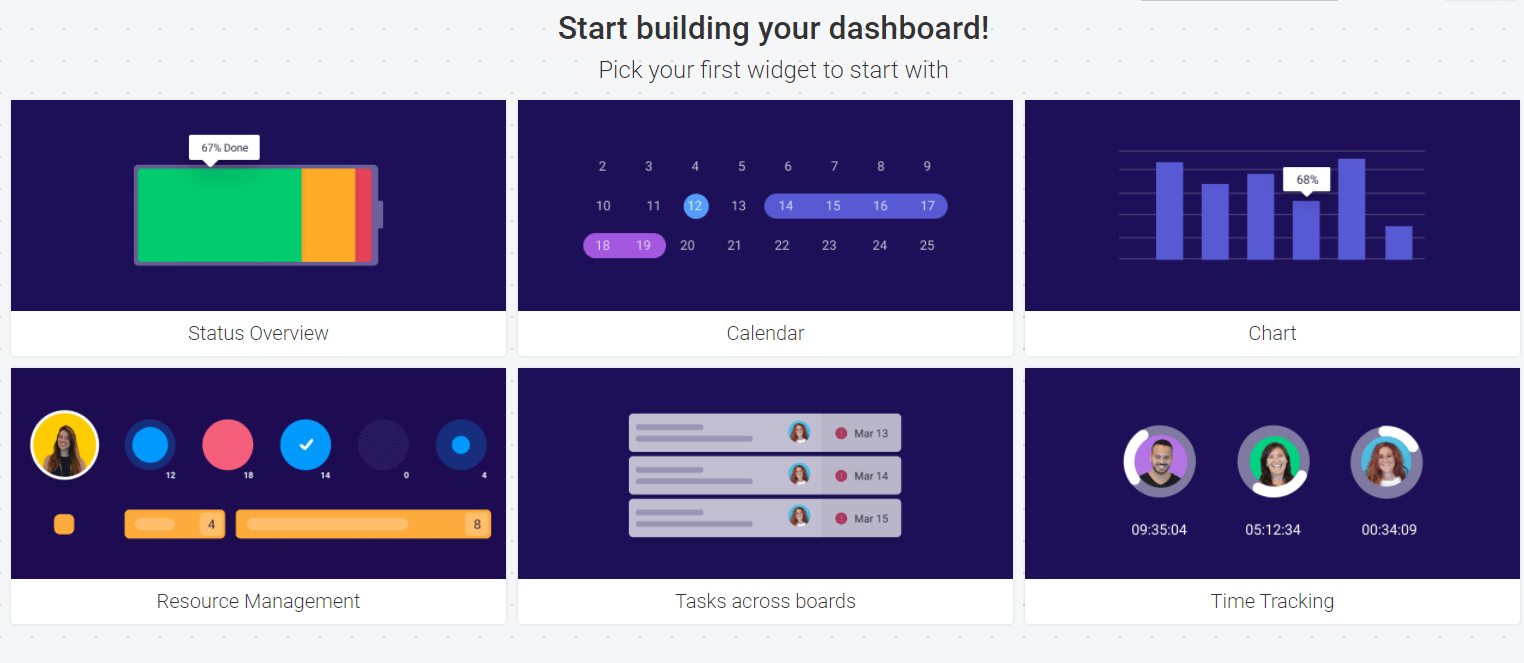
Master your tasks
Breaking down a project into tasks and assigning them effectively requires a bit of balance.
Finding the framework that works best for your industry and internal workflows and pairing them with the tips above can help you find the happy medium of management and autonomy that will allow your teams to thrive.
Whichever you choose, monday.com has the right templates and tools to help your projects succeed.
- Professional Scrum Product Owner (PSPO)
- SAFe for Government
- Professional Scrum Master (PSM)
- Certified ScrumMaster
- PMI-ACP Exam Prep
- Leading SAFe® 6.0 Certification
- SAFe Scrum Master
- Certified Scrum Product Owner (CSPO)
- SAFe for Teams
- Agile Scrum Foundation
- AgilePM Foundation and Practitioner Certification
- Agile Scrum Master (ASM)
- Kanban Training
- Scrum Fundamentals
PMP Certification
Project Management Fundamentals
CAPM Exam Prep
- Change Management Foundation and Practitioner Certification
- PRINCE2 Foundation & Practitioner Certification (7th Edition)
- PRINCE2 Agile Foundation & Practitioner Certification
- Business Analysis Foundation and Practitioner Certification
- Microsoft Project Training
- JIRA Certification Training
- Lean Project Management
- ITIL 4 Foundation
- VeriSM™ Foundation
- SIAM Foundation
- SIAM Professional
- 7 QC Tools Training
- Minitab Essentials
- Lean Six Sigma Yellow Belt
- Six Sigma Awareness
- Lean Six Sigma Green Belt
- Design for Six Sigma
- Lean Six Sigma Black Belt
- Lean Fundamentals
- Value Stream Mapping
- Quality by Design
- Quality Function Deployment
- BPM and Six Sigma
- RCA through Six Sigma
- DevOps Foundation
- DevOps Master
- DevOps Professional
- Continuous Delivery Architecture
- COBIT 5 Certification
- Corporate Group Training
- 1-to-1 Training
- Join as a Trainer

- Best Project Management Blogs
- What is Task Management in a Project?
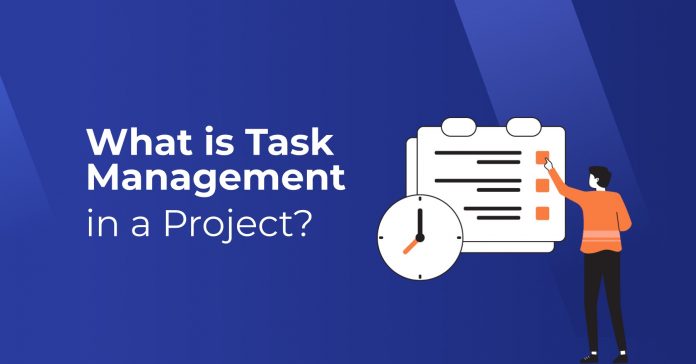
Are you a project manager or an entrepreneur struggling to keep tasks aligned?
A team leader looking to streamline your project’s workflow?
This blog is your ultimate guide to mastering the art of task management in any project setting. We delve into organizing, prioritizing, and executing tasks effectively, ensuring you, as a project manager, stay ahead in the fast-paced business environment.
We cover everything from leveraging cutting-edge tools and techniques that empower you to improve task management to skills that foster seamless team collaboration.
Table of Contents:
- Project Management vs Task Management
- Benefits of Task Management
- Who is Involved in Project Task Management?
- How to Manage Tasks?
Common Task Management Challenges
- Key Strategies to Improve Task Management
What is Task Management in a Project?
Task Management is a fundamental component of project management , involving the prioritization, and execution of tasks to achieve specific objectives within a project. It involves managing a task through its life cycle, encompassing planning, testing, tracking, and reporting. Task management helps teams and individuals to complete their work efficiently and effectively.
“Task management helps in breaking down projects into manageable tasks. Each task is a basic building block of a project, and managing these tasks effectively is crucial for the project’s overall success.“
Effective task management ensures that individual tasks are completed successfully and contributes to the project’s overall health. It enhances productivity, reduces stress, and provides a clear roadmap for project goals.
Project Management vs Task Management
Understanding the distinction between project and task management is crucial for effective organization and execution in any work environment.
Project management encompasses a project’s overall vision and direction, guiding it from inception to completion. Task management, conversely, focuses on the specific details of managing individual tasks that collectively contribute to the project’s success.
Below, we present these differences in a concise tabular format to clarify how each process functions and their respective roles in achieving organizational goals.
Understanding these differences is key to effectively managing both projects and tasks. While project management provides the strategic framework for achieving project objectives, task management offers the tactical support to execute those strategies, ensuring that each small step contributes effectively to the larger goal.
Benefits of Task Management in Project
Task management is a key for project success. Structured methodologies elevate productivity, streamline workflows, and nurture collaboration. Explore the transformative advantages it brings to enhance your projects.
Improve Productivity
Task management plays a key role in enhancing overall productivity within a project. Teams can optimize their workflow by implementing systematic approaches such as task prioritization and time allocation.
The ability to focus on high-priority tasks first ensures that critical components are addressed promptly, avoiding unnecessary delays.
Additionally, the transparent communication facilitated by task management tools ensures everyone is aligned with project objectives, reducing confusion and enhancing the collective effort toward project completion.
Increase Efficiency
Efficiency in project execution is a natural byproduct of effective task management. Streamlined workflows, facilitated by task management systems, minimize bottlenecks and unnecessary steps, allowing teams to work more effectively.
Collaboration tools integrated into task management platforms encourage real-time communication and decision-making, eliminating the need for prolonged email exchanges or meetings.
Through clear task assignments and defined responsibilities, teams can avoid duplication of efforts and make sure that each team member contributes efficiently to the overall project goals. In essence, task management maximizes output with minimal resources.
Reduce Stress
Task management contributes significantly to stress reduction among team members by providing clarity and structure. Clear expectations and well-defined roles alleviate the anxiety associated with uncertainty. The breakdown of tough projects into manageable tasks prevents team members from feeling overwhelmed.
Knowing exactly what needs to be done and when, individuals can confidently approach their work, resulting in a more positive work environment. Furthermore, task management tools that offer reminders and progress tracking serve as supportive mechanisms to prevent tasks from falling through the cracks and mitigate the stress of missed deadlines.
Ensure Customer Satisfaction
Customer satisfaction is intricately tied to project outcomes’ timely delivery and quality. Task management ensures deadlines are met through effective time management and adherence to project timelines.
By breaking projects into smaller, manageable tasks, teams can monitor and maintain a high-quality standard throughout the process.
This dedication to quality and transparent communication facilitated by task management tools fosters stakeholder trust and satisfaction. Meeting or exceeding customer expectations becomes a more achievable and consistent outcome.
Monitor Trends
Task management systems are essential for organizations, providing a seamless way to assess statistics and analyze operational trends. With these insights, teams can pinpoint effective strategies, address areas needing attention, and optimize overall productivity.
This proactive approach to decision-making empowers businesses to refine processes and stay competitive in a dynamic environment.
Armed with data from task management systems, organizations can develop targeted strategies that align with their goals. Businesses can address challenges and capitalize on strengths by refining operations, reallocating resources, and adopting innovative technologies.
Task management benefits extend beyond data analysis, offering a pathway to continuous improvement and strategic decision-making in today’s competitive landscape.
Who is Involved in Project Task Management?
In project task management, various roles come together to ensure the smooth execution and completion of tasks within a project. Each role contributes unique skills and perspectives, creating a collaborative environment essential for project success.
Here’s a look at the key roles involved in project task management:

- Project Managers: The project manager is key to project task management. They oversee the entire project, ensuring tasks align with its objectives, timeline, and budget. Their responsibilities include planning, organizing, leading, and controlling project activities.
- Team Leaders: Team leaders or supervisors are crucial in managing and motivating team members. They are responsible for delegating tasks, monitoring progress, and ensuring their team meets its deadlines and quality standards.
- Team Members: The individuals who execute the tasks. Team members are often specialists in various fields and bring their expertise to complete assigned tasks. They are responsible for understanding their tasks, collaborating, and completing their work on time.
- Stakeholders: Clients, sponsors, and senior management may not be directly involved in day-to-day task management but play a vital role. They are vested in the project and can influence its direction and priorities.
- Resource Managers: Responsible for allocating resources needed for task completion, such as workforce, tools, and materials. They ensure that teams have what they need to work efficiently.
- Quality Assurance Professionals: They ensure that the tasks and final deliverables meet the required standards and are defects-free. Their role is critical in maintaining the quality of the project’s output.
- IT Support and Technical Experts: IT and technical experts provide the necessary support and expertise for projects involving technical components. They ensure that the technological aspects of tasks are handled efficiently.
Each role contributes to effectively managing project tasks, ensuring the project progresses smoothly towards its goals. Collaboration, communication, and a clear understanding of each role’s responsibilities are vital for successful project task management.
How to Manage Tasks?
Managing tasks effectively is crucial for the success of any project. The PMI’s Global Project Management survey highlights the importance of clearly defined objectives and disciplined strategy implementation.
Here’s how you as a project manager, can excel in task management, keeping these insights in mind:

- Prioritization: Begin by prioritizing your project tasks. Use a to-do list or a comprehensive project task management tool to identify the most critical tasks. This step ensures you focus on what’s essential, preventing resource wastage and time mismanagement. Ask yourself, “Which tasks have the highest impact on project success?”
- Milestone Tracking: Set and track milestones. This doesn’t just provide a roadmap but also keeps the team motivated and focused. Milestones act as checkpoints to measure progress and realign efforts as needed. Regularly review these milestones: Are you on track, or do adjustments need to be made?
- Schedule Management: Assign realistic timeframes to each task based on the estimated effort required. Efficient schedule management is key to ensuring tasks are completed on time, contributing to the project’s overall health. Use tools like Gantt charts for visual scheduling and tracking.
- Resource Allocation: Allocate resources optimally. Match tasks with the right talent and resources, considering your budget and schedule constraints. Efficient resource allocation maximizes productivity and minimizes waste.
- Collaboration: Foster a collaborative environment. Use task management software to keep team members connected and in sync. Regular team meetings and updates are crucial. Encourage open communication: Are team members facing any hurdles? How can these be overcome collaboratively?
- Deadline or Priority Matrix: Implement a deadline or priority matrix, categorizing tasks based on urgency and importance. This visual approach helps quickly identify tasks that need immediate attention versus those that can be scheduled for later.
Effective task management is more than just completing tasks; it’s about doing the right tasks at the right time with optimal resources. Following these steps can enhance your project’s performance, leading to successful outcomes.
Effective task management is pivotal for the success of any project, but it often comes with challenges. By understanding these challenges and implementing strategic solutions, project teams can navigate difficulties and ensure project success.
Let’s explore some common project task management challenges and how to overcome them, using examples for better understanding.
1. Unclear Task Requirements
- Challenge: A common issue is the need for clear task requirements, leading to confusion and delays. For instance, a software development team might struggle if the client’s requirements are vague or constantly changing.
- Solution: Establish a clear communication channel with stakeholders. Regularly review and update task requirements and ensure everyone involved understands the changes. Implementing an iterative approach, like Agile methodology, can be beneficial in such scenarios.
2. Overlapping Deadlines and Resource Constraints
- Challenge: Managing tasks with overlapping deadlines, especially with limited resources, is a significant hurdle. Imagine a marketing team facing multiple campaign deadlines simultaneously but with limited personnel.
- Solution: Prioritize tasks based on urgency and impact. Use tools like Gantt charts to visualize overlapping deadlines and adjust resources accordingly. Consider outsourcing or reallocating resources from less critical tasks.
3. Ineffective Team Collaboration
- Challenge: Teams that need help with collaboration often need more time to communicate effectively. An example is a remote team failing to synchronize due to time zone differences.
- Solution: Implement collaboration tools that accommodate different time zones. Schedule regular check-ins and encourage open communication. Establish clear roles and responsibilities to streamline collaboration.
4. Adapting to Unforeseen Circumstances
- Challenge: Unexpected events, like a key team member falling ill, can derail task progress. For example, an event planning team might face a crisis if a major supplier backs out at the last minute.
- Solution: Have contingency plans in place. Cross-train team members so they can cover for each other. Build relationships with multiple suppliers to mitigate risks.
5. Difficulty in Tracking Progress
- Challenge: Proper tracking mechanisms make it easier to maintain task progress. Consider a scenario where a construction project needs to catch up due to inadequate progress tracking.
- Solution: Use project management software to track task progress in real-time. Regularly review progress with the team and adjust plans as necessary.
You can significantly improve project task management by acknowledging and addressing these challenges head-on. Each challenge presents an opportunity for growth and learning, paving the way for more successful project outcomes.
Key Strategies for Effective Task Management
Effective task management is the cornerstone of successful project execution. It involves more than just listing and assigning tasks; it requires a strategic approach combining technology, communication, and flexibility.
Here are key strategies to elevate your task management in the project process:
Technology Utilization
Embrace the power of task management software. The right tool can streamline task delegation, progress tracking, and team collaboration. Choose software that offers flexibility and customization to meet your specific project needs. This not only saves time but also enhances overall efficiency and productivity.
Agile Methodologies
Agile frameworks like Scrum can be adapted for various projects, not just software development. These methodologies enhance flexibility and responsiveness, allowing teams to adapt to changes and new requirements quickly.
Team Autonomy
Empower team members by giving them ownership of their tasks. This fosters a sense of responsibility and encourages innovative problem-solving. Autonomy increases job satisfaction and motivates team members to perform at their best.
Balanced Workloads
Regularly monitor and balance team workloads to prevent burnout and ensure optimal productivity. Balanced workloads also create a more positive work environment and better team morale.
Training and Development
Invest in regular training and development sessions for your team. Enhancing skills and knowledge not only improves task execution but also keeps the team updated with the latest trends and technologies. We at Invensis Learning provide various training and development courses that help your teams upskill in the present trends.
Incorporating these strategies into your task management approach can foster a more efficient, collaborative, and adaptive project environment. This not only leads to the successful completion of individual tasks but also contributes significantly to the overall success of your projects.
Task management is an indispensable part of project management, intertwining strategy, clarity, and effective execution. This blog has highlighted the significance of clear communication, adept use of technology, and the pivotal role of teamwork and adaptability.
Effective task management goes beyond just completing tasks; it’s about aligning them with the project, ensuring every action contributes meaningfully to the final objective.
For those eager to delve deeper and master the art of task management, our Project Management courses offer a wealth of knowledge and practical skills.
These courses are tailored to equip you with a comprehensive understanding of task and project management, enhancing your ability to lead and succeed in any project environment. Enroll now to elevate your skills and navigate the complexities of project management with confidence and proficiency.
Change Management Foundation and Practiitioner Certification Training
PRINCE2 Foundation and Practitioner Certification Training
EXIN Business Analysis Foundation and Practitioner Training
RELATED ARTICLES MORE FROM AUTHOR

Project Management Officer: Roles, Types, Skills and Salary

What is Feasibility Study in Project Management?

8 Best Project Selection Methods for Project Managers in 2024
Leave a reply.
Save my name, email, and website in this browser for the next time I comment.
- 14,525 Likes
- 444 Followers
- 94,500 Subscribers
- 2,170 Followers
Related Articles

7 Ways Lean Six Sigma can benefit your Organization

Common Challenges Faced by Scrum Master and Ways to Overcome Them

Introduction to User Stories in Agile Development

Benefits of PRINCE2, MSP, P30 Certification for Successful Project Management Career

ITIL Service Transition – FAQs
Popular posts.

The Project Management Life Cycle Explained

Roles and Responsibilities of a Quality Control Inspector

7 Cs of Effective Communication with Example

Top 5 Factors for Project Success

Quality Analyst Job Role and Responsibilities- Explained!
Suggested posts.
- 7 Cs of Effective Communication with Examples
- Project Management Lifecycle
- Project Success Factors
- Quality Control Inspector Job Description
- Risk Management Examples
- QA Manager Job Description
- Quality Management Team Roles and Responsibilities
- Risk Management Tools & Techniques
- Quality Analyst Job Description
- What is Business Value
- Who are Project Stakeholders
- Importance of Project Management
- What is Project Management
- Project Management Skills
- Project Manager Job Description
- Agile Project Manager Interview Questions
- Risk and Compliance Manager Job Description
- Risk Management Process
- Project Scope Management
- Healthcare Project Manager Job Description
- Six Sigma Project Examples
- Risk Analysis Methods
- ITIL Service Lifecycle
- Risk Manager Job Description
POPULAR CATEGORIES
- Best Project Management Blogs 249
- Top Agile Blog Posts 158
- Top Blogs on Quality Management 126
- Latest IT Service Management Blogs 108
- Trending Articles on DevOps 65
- Popular Blogs on IT Security and Governance 55
- Top Blogs on Professional Development 33
- Top Infographics Collection 8
Download E-book Blog
Thank You for submitting your enquiry. One of our training consultants will get in touch with you shortly.
50+ Training and Certification Programs - Upskill Today Learn more about our training programs.
Filter by Keywords
Project Management
Project management vs task management – what’s the difference.
Erica Chappell
Managing Editor
December 31, 2021
Project management and task management .
Those terms get tossed around quite a bit. But are there any real differences between project management and task management?
Consider this example.
At my house, I want to put in a new stone walkway that leads to my front door. To do that, I’ll need to clear the ground, make it level, add the stones and also do a lot of other things I’m not thinking about.

The project is creating the walkway. The tasks are what I need to do to make it happen.
But other tasks involve gathering resources : buying stones, finding my shovel, and oh yeah, asking friends to help me out. Those are all tasks, too.
Scoping out and considering the needed resources are vital to a great project.
- The project is the overarching goal which has many tasks: create a stone walkway.
- The tasks are everything that needs to get done to accomplish the goal.
- Project management usually encompasses tasks.
Each project usually has several tasks, due at different intervals. Often, they’re dependent on one another and sometimes one task can’t be finished until the next one begins.
Task Management vs Project Management in simple terms
Rather than referring to project management and task management interchangeably, let’s try to define the differences.
The main difference between project management and task management is that task management refers to managing individual work and personal activities, while project management refers to managing work with entire teams and stakeholders. Task management is therefore a subset of project management.
Projects vs Tasks
Let’s get more specific with tasks vs projects. Projects are chunks of work with specific start and end dates. They have milestones and a clear outcome, generally with a deliverable in the end. Tasks are single units of work, and multiple tasks can make up a project or can be independent of projects.
Sometimes tasks independent of a project aren’t necessarily that big.
For instance, if you’re a salesperson, you probably have to reply to a lot of emails and make several calls. Your task is to call the next person on your list.
Your project would be to follow up with 100 contacts that you met at your latest conference.
For some you’ll call (tasks), others you’ll email (more tasks) and you’ll want to gather your sales enablement material that specifically relates to the conference topics (more tasks).
Projects often involve more than one person, with a project manager and team. Each team member performs individual tasks related to the projects. The sum of everyone’s task management will be a finished project . For example, feature releases count as multiple projects.
As you can see, task management is clearly part of project management.
Are You Confusing Projects with Tasks?
This will cause you a lot of frustration. For example, if you’re writing the words “Build New Product” on your to-do list …well, that’s a little much. You won’t get that done in a day. Instead, you’ll need to break that up into smaller chunks or tasks, and then take action on those smaller steps.
One method that’s really great at separating projects and tasks is the Get Things Done Methodology. It really helps you separate out what takes a long time versus what’s easier to do in a few steps.
We have created additional resources to help you with the basics of project management:
- Top project management methodologies
- Project management principles
- Project management skills needed for project managers
Check out our project management glossary for more project management terms!
Do You Need Project Management Software or Task Management Software?
No matter the size of your project, you probably still have a few reminders stuck on post-it notes. It’s time to upgrade your tech stack to include either a task management tool or a project management tool.
What does task management software solve?
Task management software helps you keep to-do lists and other notes in one place. Software such as this will help you do tasks quicker when you start a new project.
Using this software you can create task lists, group tasks and schedule their completion. They help you move one task along before starting another. Most of the time there are no specific task dependencies that relate to each other.
Popular task management apps include Todoist or Any.do . These are simple apps that are task-driven. Often they’re ranked by urgency and the reminders can be set often.
What does project management software solve?
Project management software, on the other hand, is meant to coordinate projects , and usually provide all the features that a task management software offers.
These project management tools are all about collaboration , coordination, and project planning. Project management software have subtasks, comments, attachments, and task descriptions that give detail on when a project should be done.
It often takes a robust time view or Gantt chart to see how all of the projects stack up against one another.
Project management software helps project managers create time estimates , track team member’s work, and project reports. Most task management software programs just don’t have that. Tasks aren’t usually that urgent or that involved to include time estimates within them.
Bonus: Taskade alternatives !
The Best Project Management Software is Also Task Management Software
There aren’t necessarily clean breaks between your work and personal life.
Yes, there’s balance, but making your children’s dance recital could overlap with your next client call. Or you may need to fit in that Amazon order while writing your next project proposal .
See what I mean?
The best software combines both task management and project management. You have the tools to do both with the simplicity not to overwhelm one with the other. You should find software that’s a joy to use–whether it’s tasks or projects, personal or professional.
FYI, That’s Why We Created ClickUp
Yep, ClickUp is truly a productivity platform that you could use for personal tasks as well as professional projects. It’s a question that has driven our CEO Zeb Evans from the beginning. He asks this:
- “Why can’t my work life and my life outside of work be in the same place, but partitioned enough so they don’t mix?
- Why can’t I just have everything in one simple and beautiful platform?
- These are the questions I asked myself. And this is the core of ClickUp’s mission.
- We aren’t here just to solve the project management problem. We came together to solve bigger problems.”
It’s an ambitious goal to solve a huge problem of separating tasks and projects. But that’s why we’ve made ClickUp free and easy to use.
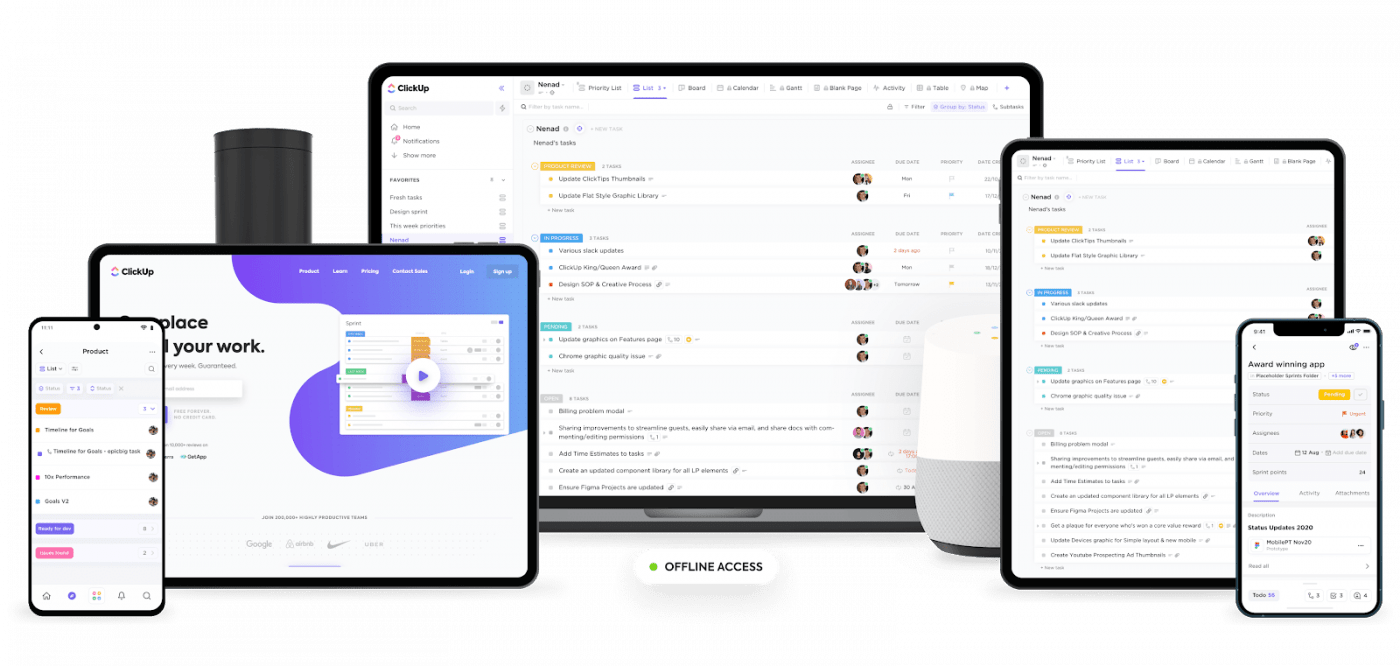
ClickUp has all the task management capabilities to help you finish your tasks, such as:
- To-do lists
- Simple statuses
- …and a notepad to jot down ideas.
But it also has the powerful project management features you need to get things done at work, like:
- Multiple Assignees – Collaborate together on a single task – if your Space allows it.
- Assigned Comments – Instantly create and assign action items for yourself or others.
- Priorities – Create custom priority levels, and organize tasks based on their importance to a project.
- Favorites – Create your own customized sidebar to include sorting, filtering, and even your favorite view.
- Chrome Extension – Provides fully comprehensive features to increase productivity, including time tracking, image markup, and task creation.
- Multiple Views – List View , Board View , and Box View and Gantt charts, Calendar and more offer the perfect view for developers, managers, and everyone in between.
- Dependencies – Link tasks together based on their requirements to ensure the right tasks are completed in the right order.
- Time View / Calendar – Easily drag and drop tasks to make scheduling a breeze. You’ll also see tasks that aren’t scheduled yet.
- Integrations – Connect to Google Drive, Dropbox, Harvest, Toggl and tons other integrations to simplify your workflow.
At ClickUp, we’ve built the right project management software to solve the personal and professional. Will you join us in making it happen? The easiest way to do that is give it a try. Sign up today!
Questions? Comments? Visit our Help Center for support.
Receive the latest WriteClick Newsletter updates.
Thanks for subscribing to our blog!
Please enter a valid email
- Free training & 24-hour support
- Serious about security & privacy
- 99.99% uptime the last 12 months
Popular Insights:
Best Project Management Software
Mind Mapping Software
What is Project Management? Definition, Types & Examples
Share this Article:
Our content and product recommendations are editorially independent. We may make money when you click links to our partners. Learn more in our Editorial & Advertising Policy .
Project Management is the application of specific knowledge, skills, methodologies, and techniques aimed at achieving specific and measurable project goals, including, ultimately, successful project completion. It differs from general “management” because project management relates directly to the goals and time-bound objectives achieved within the scope of a project itself, on a limited timeline, rather than an ongoing one.
Featured Partners
{{ POSITION }}. {{ TITLE }}
What is a Project?
A project is a temporary, time-bound sequence of tasks that aim to achieve a particular goal. Projects bring together the talents of multiple team members in order to deliver a tangible result or outcome over a predetermined span of time. Often, projects involve the work of multiple individuals, across numerous areas of expertise, requiring an upfront investment in time and resources.
What is a Project Manager?
Project managers take ownership over the entirety of the project lifecycle from start to finish, from directing team efforts to navigating day-to-day challenges, implementing project management strategies, and more. Ultimately, they are responsible for the successful competition of the project and the distribution of key deliverables and project outcomes.
Responsibilities of a Project Manager
Project managers are responsible for a wide range of project-related duties, including but not limited to:
- Establishing and managing the project timeline
- Assigning project tasks and delegating responsibilities to team members
- Communicating with key stakeholders
- Executing each phase of the project
- Facilitating team adaptation of project management aids and tools (such as project management software, and Gantt charts)
- Monitoring the project budget and project scope, preventing cost or scope overruns
- Troubleshoot and mitigate potential roadblocks and issues
- Establishing set meeting schedules and facilitating team discussions
- Monitoring ongoing project progress
- Concluding the project lifecycle with relevant end-of-project responsibilities, including facilitating project reviews, and turning over deliverables
Essential Skills of a Project Manager
Project managers handle a wide variety of project-related responsibilities and duties, and understandably, need to wield a broad and flexible skillset. Some of the essential skills a project manager should possess include the following:
Examples of Project Management
In order to better conceptualize what project management is, it’s helpful to understand how project management plays out in real-life applications. Here are a few examples of how project management is used across various industries every day:
Example One: Project Management in Construction
In 2005, BAA Airports Ltd. was presented with an enormous task: remodeling Terminal 1 within Heathrow Airport, the busiest international airport in the world while keeping the terminal open to the 20 million annual travelers that pass through the airport. The project was extremely complex, and made even more challenging by a strict deadline and significant public health concerns, given the construction project was taking place within an active terminal.
Throughout the project lifecycle, David Buisson, PMP, and the project manager in charge of the Heathrow renovation project, encountered many unexpected obstacles, including asbestos in the ceiling and inconsistencies with the floor level. Buisson and his team were able to properly navigate project challenges, operational risk, and communication management with key stakeholders. They successfully delivered the project on time and on budget—without any major mishaps—utilizing the PMBOK Guide from the Project Management Institute, the standard guide for project management professionals.
The 2005 renovation of Heathrow Airport Terminal 1 is widely considered one of the most successful case studies in construction project management to date.
Example Two: Project Management in Healthcare
During the Covid-19 pandemic, pharmaceutical and biotechnology company, AstraZeneca partnered with the University of Oxford to address the international need for a vaccine. The research partners at Oxford University had begun showing promising research around an early vaccine option. Paired with AstraZeneca’s manufacturing capabilities and global supply chain experience, it was a no-brainer for the two entities to pair up to address the pandemic.
However, the partnership would face numerous challenges throughout the project lifecycle, including, most notably, a highly unpredictable and rapidly evolving public health crisis. Adaptability had to be the name of the game, and the structured guidelines of project management provided a baseline for the team to work from. Ultimately, the project was an overwhelming success, with over 1 billion doses of the vaccine delivered to over 170 countries.
Example Three: Project Management in Aerospace Technology
The Mars Pathfinder Mission began in 1996 as a result of budget cuts within NASA, shifting the organization’s focus to projects that could be completed “faster, better, and cheaper.” The goal was to spend less than $150 million dollars on the project in total and implement it within 36 months. Based on the initial goals established by NASA, just getting the spacecraft to Mars and landing it in one piece would have been a success.
Instead, by the time the project reached completion in September 1997, the Mars Pathfinder returned 2.3 billion bits of information, including more than 16,500 images from the lander and 550 images from the rover, as well as more than 15 chemical analyses of rocks and soil and extensive data on winds and other weather taking place on Mars. Ultimately, the project was such an exemplary example of project management at work that it won the Project Management Institute’s coveted ‘‘Project of the Year Award’’ for 1998.
Phases of Project Management
Check out the video below for an in-depth walkthrough of the five phases of the project management lifecycle.
- Project Initiation
The project initiation phase focuses on establishing a high-level vision for the project while securing approvals from sanctioning stakeholders. This phase is not meant to dive into excessive detail, but rather to get the ball rolling and get the team thinking about what is to come.
- Project Planning
During the project planning phase, teams build upon the vision established in the initiation phase in much more detail. First, teams must answer a few essential questions surrounding what the project will aim to accomplish, how the project will be carried out, when it will begin, on what timeline, and how project success will be measured. Once those initial questions have been answered, teams can dive into building out project infrastructure, covering essential topics such as:
- Project scope
- Deliverables
- Key stakeholders
- Goals and milestones
- Resources needed (internally and externally)
- Project timeline
- Potential risks or roadblocks
- Dependencies
- End of project outcomes
- Project Execution
The project execution phase is the starring act of the project, and where most of the deliverables come from. During this phase, the project manager(s) coach and guide the team to present essential project deliverables while keeping stakeholders in the loop and monitoring progress against key milestones and KPIs. Throughout the project execution phase, project management systems, such as project management software, can make life easier by keeping track of deadlines and deliverables, serving as a platform for team member collaboration, and more.
- Project Monitoring
During the monitoring phase, the project manager(s) keep tabs on the progress of the project overall and the status of the team. Whether teams are on track and delivering stellar results or struggling with roadblocks and challenges, the project manager can help eliminate stressors, solve problems, and communicate updates with key stakeholders.
- Project Closure
The closing phase of the project lifecycle is a time for wrapping up project activities, delivering project deliverables and outcomes, and reflecting on the wins and losses of the project overall. Communication is key within this final phase, where team members have an opportunity to reflect and celebrate.
Download Our FREE Project Lifecycle Guide
Read more: 5 phases of project management life cycle you need to know, project management methodologies & frameworks.
Project management methodologies establish a guiding set of rules and principles that teams can implement in order to achieve greater efficiency while maximizing positive project outcomes. Each methodology approaches project management through a slightly different lens, providing teams with a specific set of repeatable steps to follow throughout the project lifecycle. Methodologies are rigid and cannot be used in combination with other methodologies.
Project management frameworks can exist within methodologies, providing a more focused view of how a methodologies guidelines can be applied and implemented. While the structure and rules follow the teachings of the methodology, frameworks can color in detail how and when those rules are applied in a project setting.
Project Management Methodologies Agile
Agile project management focuses on an iterative and highly flexible approach to project management that focuses on delivering the project in pieces throughout the project lifecycle, rather than all at once at the project’s conclusion. In Agile project management, teams have more flexibility to adapt to challenges and redirections than in more structured methodologies, such as Waterfall.
Best for:
- Software development teams
- Teams dealing with high levels of uncertainty
- Teams who are creating prototypes that need multiple levels of edits and changes
- Teams working closely with external parties and stakeholders
Waterfall project management is a traditional approach to project management that involves rigid, sequential project phases. In the waterfall model, each phase of the project must be fully completed before the next phase can begin, and project deliverables are turned over only at the conclusion of the project.
- Projects with a well-defined goal
- Projects with concrete timelines
- Teams who need to define rigid project requirements early on
Project Management Frameworks
Scrum project management, as the name suggests, is inspired by the camaraderie and teamwork of a Rugby team within the Agile methodology. Led by a Scrum master, Scrum teams are encouraged to learn through their experiences, self-organize as they problem-solve, and progress throughout the project lifecycle.
- Smaller teams tackling numerous unknowns and ever-changing variables
The Kanban framework is a subset of the Agile methodology that emphasizes continuous improvement and flexible task management. In the Kanban framework, teams utilize Kanban boards, vertical boards that separate individual task cards into categories based on their status in the project lifecycle (for example: “not started,” “in progress,” and “completed”).
- Teams who are new to project management and looking for a simple, organized framework
- Projects with numerous individual tasks and assignments
- Teams who need quick access to a high-level view of task overviews and completion status
Critical Path Method (CPM)
Critical Path Method is a project management framework within the Waterfall methodology that identifies critical and non-critical tasks, prioritizing them based on their importance—eliminating bottlenecks and roadblocks. The CPM method emphasizes the importance of calling out relationships between tasks and task dependencies.
- Teams managing large, complex projects
- Projects that require a large number of tasks with subtasks and dependencies
- Teams who want to maximize efficiency and prevent roadblocks from the start of the project (especially for projects that have a high likelihood of complication)
PRojects IN Controlled Environments, or PRINCE2, is a framework within the Waterfall project management methodology that emphasizes organization and control. Frequently used in the UK and internationally, The PRINCE2 model breaks down projects into smaller, more manageable chunks in order to manage risk and resources while clearly defining team roles and responsibilities.
- Teams who have less experience in project management (PRINCE2 follows clearly defined, easy-to-understand steps)
- Teams who need more clarity around specific role-based responsibilities
- Compartmentalizing project steps and actions
Project Management Tools
Project management software.
Project Management Software helps teams organize all project essentials in one place, while streamlining and simplifying the project management process overall. At every phase of the project lifecycle, project management software supports teams’ ability to assign tasks, manage deadlines, view task dependencies, track team progress against goals, access data insights, and much more.

Example of a list-style project view in project management software. Source: monday.com, accessed September 2023.
Read more: 10 Best Project Management Software for 2023
Project management charts , gantt charts.
Gantt charts are one of the most common planning tools in project management. In a timeline-inspired format, Gantt charts highlight tasks against the project timeline, task dependencies, and designated assignees. Gantt charts are useful for teams who want to visualize projects at a high-level view while avoiding resource overload.
Best for: Visualizing project timelines and task dependencies
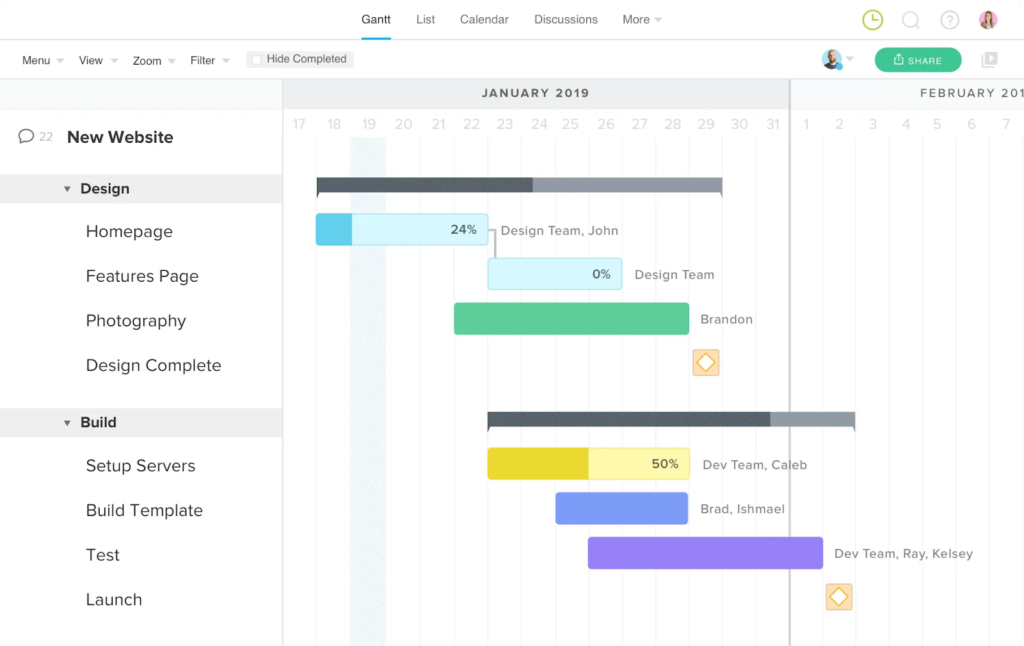
Example of a simple Gantt chart. Source: TeamGantt, accessed September 2023.
Burn-Up/Burn-Down Charts
Burn-up and burn-down charts visually represent how project tasks have been completed across a predetermined timeframe. This type of chart is popular with Scrum teams for tracking work across sprints, as it can easily reveal the total scope of work against items that have been completed or left unfinished.
Best for: Tracking project progress
Example of a burn down chart. Source: Teamwork, accessed September 2023.
Read more: Best Project Planning Software & Tools
Collaboration tools.
Slack is a communication-focused collaboration software that enables teams to communicate asynchronously through messaging, audio calling, and video conferencing. While many project management software offerings include collaboration features, Slack is a faster solution for teams who need to communicate efficiently as project updates come up.
Example of Slack’s chat functionality, complete with a mobile app option. Source: Slack, accessed September 2023.
Miro is a collaborative mind-mapping software that can help teams brainstorm throughout the project lifecycle in real-time. The application functions as a virtual whiteboard for teams to map ideas, add digital sticky notes, and plan out timelines.
Example of Miro’s team brainstorming features. Source: Miro, accessed September 2023.
Read more: Best Collaboration Software & Tools in 2023
Featured partners: project management software, {{ title }}.
Project management provides structure and accountability to the project process while providing ongoing support to your team by way of a project manager. Here are just a few of the top benefits of project management:
Project Management Keeps Projects on Track
According to data from Wellingtone, only 43% of projects are finished on time and within budget, and only 29% are on time. Project management structures a plan for teams to stay on time and budget ahead of time, so projects are more likely to go as planned.
Eliminate Scope Creep
Scope creep occurs when project requirements and frame of work expand over time—and it’s one of the most significant threats to project success, with the Project Management Institute reporting that half of all projects experience scope creep. Projects that adhere to best practices in project management are more likely to stay focused on the initial objectives of the project and, ultimately, experience success.
Enhanced Resource Management
Project management involves planning and accountability—and that can make resource management much easier. During the initial phases of project planning, teams clearly outline team roles and responsibilities while monitoring individual workloads as work progresses, ensuring that resources are allocated appropriately.
Team Coaching and Coordination
Project management efforts are traditionally led by a project manager, or at the very least, a dedicated team member who oversees team efforts while providing support throughout the project lifecycle. Having a dedicated individual who can monitor project progress, troubleshoot problems, and promote team accountability can help the project process move much more smoothly.
While every organization’s approach to project management is different, taking stock of your goals can help guide your next move. Take time to reflect on the projects your team has completed previously. What went well? What could have been improved?
If you don’t have the budget to hire a dedicated project manager, implementing smaller steps, such as taking advantage of a project management software solution, can help your team make big strides toward a strong project management strategy.
Most teams will require a toolbox of project management aids, rather than a single solution by itself. In order to determine which tools are the best fit for your team, testing is key. A majority of project management software solutions offer free trials and plans, making it easy to test out a variety of options. Other tools, such as charts, planning aids, and mind maps, are free tools that can easily be tested and explored.
Interested in learning more? Check out our FREE guide on how to choose project management software.
Sign up for our emails and be the first to see helpful how-tos, insider tips & tricks, and a collection of templates & tools. Subscribe Now
You should also read

How to Take Meeting Minutes Effectively (+ Example and Templates)

How to Manage Time Constraints: Top 7 Expert Tips
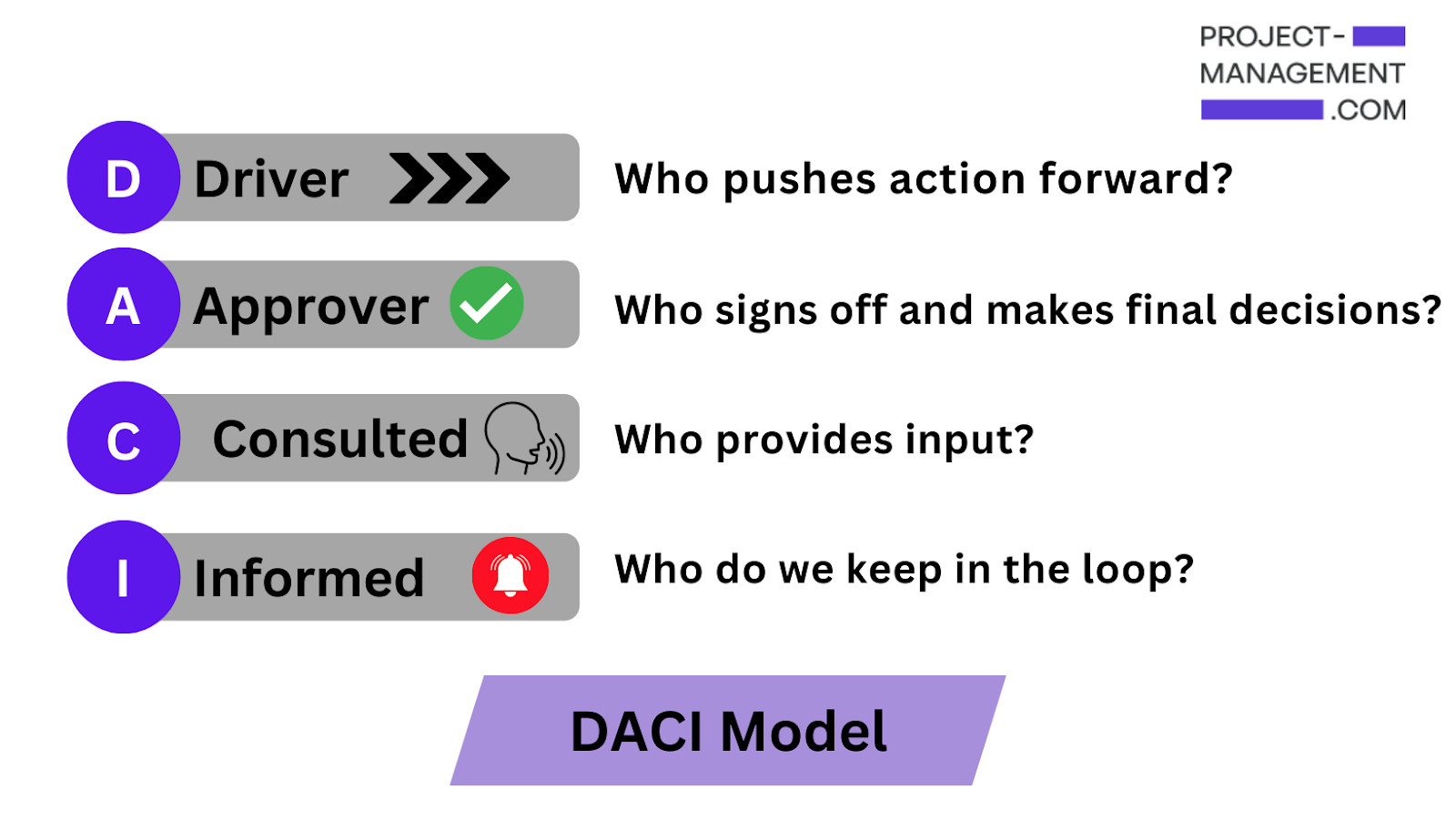
6 RACI Matrix Alternatives to Help Define Project Roles
Join our newsletter.
Subscribe to Project Management Insider for best practices, reviews and resources.
By clicking the button you agree of the privacy policy

Get the Newsletter
You might also like.
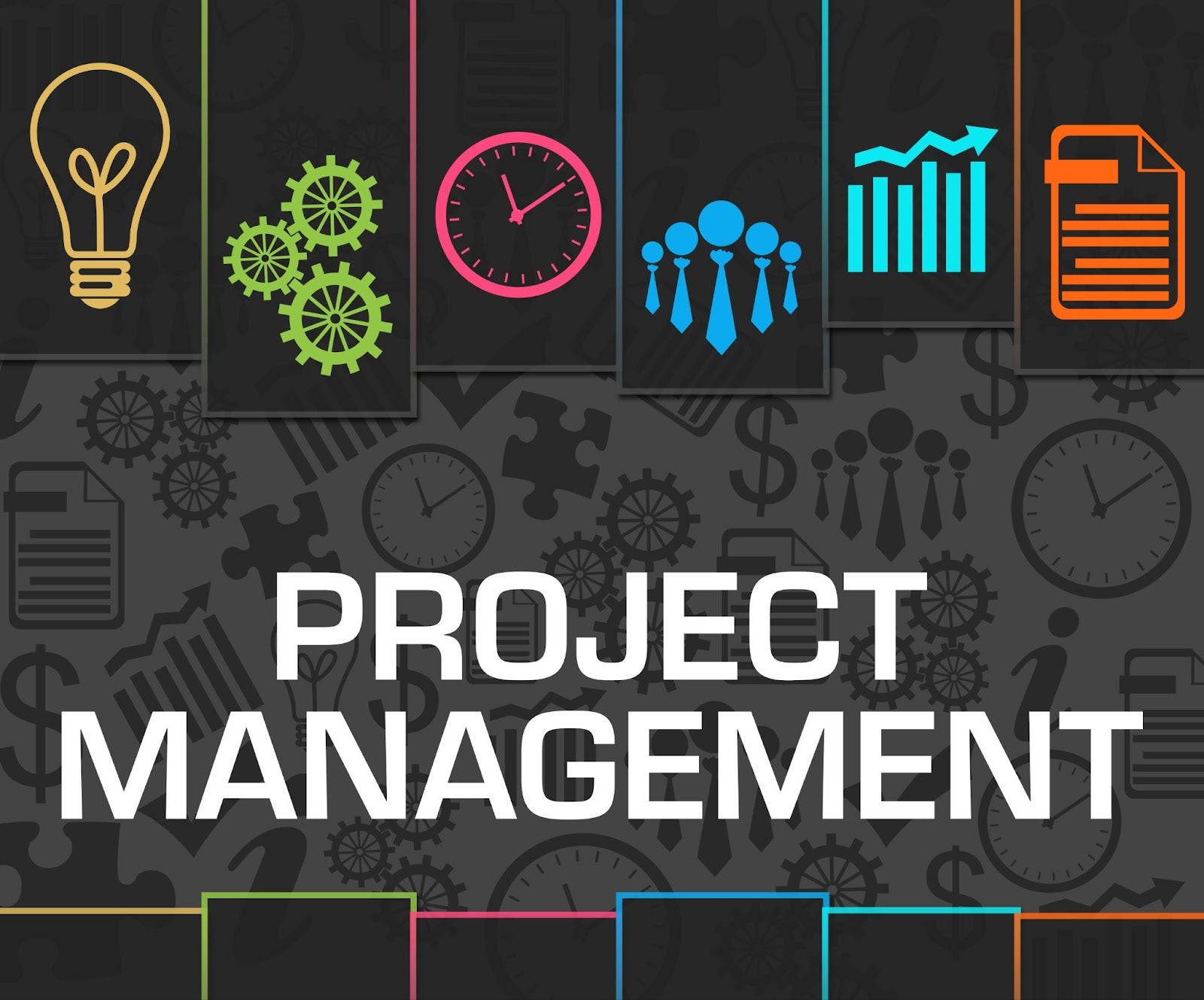
10 Benefits of Project Management Software for Business

Risk Identification Techniques and Methods for Projects
How to Measure the Success of a Project: 5 Steps (+ Examples)
Defining Tasks and Activities in Project Management: The Art and Science of Effective Project Planning

Project management is a fascinating and rewarding field that involves organizing, planning, and executing projects with precision and efficiency. The success of a project is largely dependent on the ability to define tasks and activities clearly and effectively. Whether you are working on a complex construction project, launching a new product, or organizing a large event, defining tasks and activities is the first step towards achieving your goals and realizing your vision. In this article, we will dive into the world of project management and explore the importance of defining tasks and activities, the benefits of creative project management, the size and organization of project tasks, and the different project management methodologies available to you. So buckle up and get ready to learn about the art and science of project management!
What is a Task in a Project Management?

A task in project management is a specific piece of work that contributes to the overall success of the project . It is a unit of work that has a well-defined purpose, a specific outcome, and a deadline for completion. A task can range in size and complexity, and it can take anywhere from a few minutes to several months to complete.
For example, if you're managing a construction project, a task might involve pouring concrete for the foundation. Another task might be installing electrical wiring, while yet another task might be painting the interior walls. Each task has its own unique set of requirements, resources, and timelines, and they must be carefully managed to ensure that the project is completed on time and within budget.
Tasks are the building blocks of a project, and they are the key to achieving project success. A well-defined task has a clear objective, is measurable, and can be completed by a specific person or team. Effective project management involves breaking down the project into smaller, manageable tasks and then organizing and executing those tasks in a structured and efficient manner. Whether you are a seasoned project manager or just starting, understanding the importance of tasks in project management is the first step toward success.
Task Sequencing

Task sequencing is figuring out the best order to do things . It's like when you're trying to get things done, you want to make sure you're doing them in the most efficient way possible. This can apply to a lot of different situations, like when you're managing a project, scheduling work, or even when you're putting together a to-do list for the day.
The goal of task sequencing is to make sure that you're using your time and resources most effectively. This means finding the order of tasks that will take the least amount of time or cost the least amount of money, while also making sure that all of the constraints and dependencies between tasks are taken into consideration. For example, if you're planning a big event, you might need to make sure that the decorations are set up before the guests arrive.
Task sequencing can be a complex process, and it's not always easy to determine the best order for tasks. But by using tools and techniques from fields like operations research, project management, and scheduling, you can come up with a plan that helps you get things done as quickly and efficiently as possible. Whether you're running a business, managing a team, or just trying to get through your own to-do list, task sequencing can be a valuable tool to have in your arsenal.
What are the Benefits of Creative Project Management?
Creative project management is an approach to project management that emphasizes creativity, innovation, and flexible thinking. This approach values new ideas and unconventional solutions and recognizes that creativity and innovation are critical components of project success. The benefits of creative project management are numerous and can help to drive the success of your project in different ways.
One of the primary benefits of creative project management is that it fosters innovation and allows you to develop unique and effective solutions to project challenges. By encouraging creative thinking and embracing new ideas, you can find innovative ways to tackle project problems and overcome obstacles. This can result in a more efficient, effective, and successful project outcome.
Another benefit of creative project management is that it promotes collaboration and teamwork. When team members are encouraged to be creative and share their ideas, it fosters a sense of ownership and engagement in the project and can lead to increased motivation and productivity .
What is an Activity in Project Management?
An activity in project management is a task that needs to be accomplished to complete a project. It is a specific action that must be taken to achieve a particular result. In simple terms, an activity is a step that needs to be taken to complete a project successfully. For example, if the project is to build a house, an activity could be to lay the foundation.
Importance of Activities in Project Management
Activities are essential in project management as they provide a clear understanding of the work that needs to be done to achieve the project's objectives. They help to identify the resources required for each task and estimate the time and cost required to complete the project. Activities also help to track progress and identify any issues that may arise during the project's execution.
How Activities Work in Project Management
Activities are usually defined in a project schedule or a work breakdown structure. The project schedule outlines the sequence of activities that need to be completed to achieve the project's objectives. The work breakdown structure breaks down the project into smaller, more manageable tasks, making it easier to estimate the time and cost required for each activity.
During the execution of the project, activities are monitored and tracked to ensure they are completed on time and within budget. The project manager is responsible for overseeing the activities and ensuring that the project is progressing according to plan. If any issues arise, the project manager must take corrective action to keep the project on track.
How to Define, Plan, and Schedule Activities?
To define, plan, and schedule activities, project managers must follow a series of steps. Firstly, they need to define the project's scope and objectives. This includes identifying the deliverables that need to be produced, the timeline for the project, and the budget. Once the scope is defined, the project manager needs to break down the project into smaller, more manageable tasks. This is where the work breakdown structure comes in.
The work breakdown structure breaks down the project into smaller tasks or activities, making it easier to estimate the time and cost required for each activity. The project manager needs to ensure that each activity is defined clearly, with a specific objective, and has a clear deliverable.
After defining the activities, the project manager needs to plan and schedule them. This involves determining the order in which the activities need to be completed, estimating the duration of each activity, and identifying any dependencies between activities. This information is then used to create a project schedule that outlines the sequence of activities and their expected duration.
To ensure that the project stays on track, the project manager needs to monitor and track the progress of the activities. They should regularly review the project schedule to ensure that the project is progressing according to plan. If any issues arise, the project manager needs to take corrective action to keep the project on track.
Examples of Activities in Project Management
Activities in project management can vary depending on the nature and scope of the project. However, some common examples of activities that are typically used in project management include:
This activity involves defining the project's scope, objectives, and goals. It also involves creating a project plan, outlining the tasks that need to be completed, and the resources required.
This activity involves creating the project design or blueprint. It involves identifying the materials and resources required, creating a detailed plan for the work, and designing the final product or service.
This activity involves implementing the project plan. It includes assigning tasks to team members, overseeing the work, and managing any issues that arise.
Monitoring and Controlling
This activity involves monitoring the project's progress, comparing it against the project plan, and making adjustments as needed. It also involves identifying any potential issues or risks and implementing corrective action to keep the project on track.
This activity involves closing out the project, including finalizing any remaining tasks, evaluating the project's success, and documenting any lessons learned.
In addition to the above activities, other examples of activities in project management include procurement, quality assurance, risk management, stakeholder management, and communication management.
By defining and scheduling activities effectively, project managers can better manage their resources, ensure that the project stays on track, and deliver successful outcomes.
Navigating the intricate world of project management can feel like walking through a maze, but fear not! We're here to guide you through the process, helping you transform your abstract concepts into tangible results. Let's embark on this journey together, breaking down the six essential steps to move your project from concept to completion.
Step 1 - Identify Project Requirements
Before diving headfirst into the project, let's take a moment to pause and reflect. What are the goals you want to achieve? Who are your stakeholders? By identifying your project requirements, you create a solid foundation for success. To get started, we recommend:
- Conducting a thorough stakeholder analysis
- Creating a project charter to outline your objectives, scope, and stakeholders
- Developing a requirements document to specify your project's needs and expectations
Step 2 - Break Down the Project into Tasks
Now that you've got a clear vision, it's time to break the project down into manageable tasks. Just as a sculptor chisels away at a block of marble, you'll break your project into smaller pieces, gradually revealing its true form. To do this effectively, try using the Work Breakdown Structure (WBS) technique, which allows you to:
- Organize tasks hierarchically
- Estimate the effort required for each task
- Identify dependencies and potential bottlenecks
Step 3 - Assign Resources
You've got your tasks lined up; now it's time to find the right people for the job. Think of your resources as the tools in your toolbox: you wouldn't use a hammer to screw in a nail, would you? To optimize your resource allocation, consider:
- Assessing the skills and availability of your team members
- Estimating the time and effort required for each task
- Matching tasks to the most suitable resources
Step 4 - Set Timelines
Time waits for no one, so let's make sure your project doesn't fall behind schedule. By setting realistic timelines, you'll keep your project on track and maintain momentum. To help you with this process, create a Gantt chart to:
- Visualize your project's timeline
- Monitor progress and deadlines
- Adjust your schedule as needed
Step 5 - Monitor Progress
Projects are living, breathing entities, constantly evolving as they progress. To ensure your project stays on course, it's crucial to monitor its progress, adapting and adjusting as necessary. Regularly:
- Review task completion and deadlines
- Communicate with team members to identify any issues
- Update your project plan to reflect current progress
Step 6 - Complete the Project
Congratulations! You've navigated the winding path of project management and reached the finish line. But before you pop the champagne, take a moment to tie up any loose ends and ensure a smooth transition. As you wrap up, don't forget to:
- Conduct a final review of deliverables
- Obtain stakeholder approval and sign-off
- Hold a project debrief to discuss lessons learned and celebrate your team's success
What Size Should a Project Task Be?
The size of a project task depends on several factors, including the complexity of the task, the available resources , and the skills of the team members. Project tasks can be divided into smaller, more manageable tasks, or they can be combined into larger tasks to maximize efficiency and minimize redundancies. There are three options for task sizing:
Option 1: Microtasks

Microtasks are small, simple tasks that can be completed quickly. They are ideal for repetitive or straightforward tasks, and they help to break down large projects into manageable units of work.
For example, if you are managing a software development project, a microtask might involve fixing a bug in the code, or updating a user interface element. These tasks are small, well-defined, and can be completed quickly and efficiently.
Option 2: Mid-Size Tasks

Mid-size tasks are larger than microtasks but smaller than full-scale projects. They are ideal for projects that require a moderate level of complexity and effort.
For example, imagine you are managing a renovation project for a home. A mid-size task could involve installing new flooring or painting a room. These tasks are big enough to require some planning and coordination, but not so big that they take weeks or months to complete.
Option 3: Full-Scale Projects

Full-scale projects are complex, multi-faceted tasks that require significant resources and effort. They are ideal for projects that require specialized skills or that have a long duration.
For example, let’s say you are managing the construction of a new building. A full-scale project could involve overseeing the entire construction process from start to finish, including tasks such as site preparation, foundation work, and finishing work. These tasks are big, and complex, and require a lot of planning and coordination to ensure that they are completed on time and within budget.
How to organize project tasks
Organizing project tasks is a crucial part of project management. It involves breaking down the project into smaller, manageable tasks and then putting them into a logical order that makes sense for the project. There are several methods for organizing project tasks, including Agile, Lean, Waterfall, and Scrum.
Let's take a closer look at each of these methods:
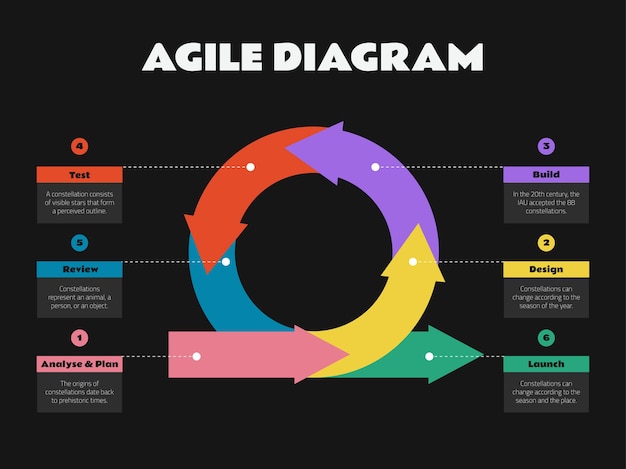
Agile is all about being flexible and adaptable. You break your project down into smaller, manageable chunks called "sprints," and then prioritize tasks based on what's important and feasible. The idea is to work closely with your team and make changes as needed, so you can keep improving and delivering value along the way. For example, if you're developing a new app, you might start with a basic version, get feedback from users, and then keep adding new features in each sprint.
Lean is all about getting rid of waste and maximizing efficiency. You visualize your workflow using tools like Kanban boards and then look for ways to streamline the process and eliminate bottlenecks. For example, if you're launching a new product, you might use Lean to figure out the most efficient way to get it from the factory to the customer, without any unnecessary steps in between.
Waterfall is a step-by-step approach to project management. You divide your project into distinct phases, each with a specific outcome and deliverable. You complete one phase before moving on to the next, and you don't usually go back and make changes once a phase is done. For example, if you're building a new house, you might use Waterfall to make sure you've finished the foundation and framing before you start on the electrical work.

Scrum is a type of Agile framework, but it has its own set of rules and practices. Like Agile, you work in sprints , but with Scrum, you have daily stand-up meetings and regular reviews to make sure you're on track. The goal is to stay nimble, keep the team informed, and make progress quickly. For example, if you're developing a new website, you might use Scrum to make sure everyone is on the same page, get feedback from stakeholders, and keep making improvements along the way.
In conclusion, defining tasks and activities in project management is a crucial step in ensuring the success of a project. By breaking down a project into smaller, manageable tasks, project managers can allocate resources effectively and monitor progress in a more organized manner. With the right tools and techniques, project managers can streamline the process of defining tasks and activities, ultimately leading to a more efficient and effective project outcome. So, the next time you embark on a project, don't forget to take the time to properly define your tasks and activities - it just might make all the difference!
If you need an efficient collaboration platform to keep your team organized and connected, Edworking is the answer. It offers powerful features, and the best part is that it's free to use for an unlimited time. Try it out and see how Edworking can help your team become more productive and simplify their work processes.
Why is it important to define tasks and activities in project management?
Defining tasks and activities is essential in project management as it fosters clarity and focus, ensuring everyone involved comprehends the project's scope and objectives. It also facilitates efficient resource allocation by pinpointing the necessary tools and support each team member needs to accomplish their tasks. This process helps to construct a realistic project timeline, establish deadlines, and prioritize work, thus keeping the project on schedule. Additionally, it supports progress tracking by simplifying the process of monitoring the project's status and identifying potential bottlenecks. Lastly, it aids in risk management, enabling the early identification of potential risks and the implementation of mitigation strategies.
How do you break down a project into tasks?
To break down a project into tasks, you first need to understand the project's scope, meaning its objectives and expected outcomes. Next, identify the major milestones, which are key stages or significant achievements in the project. Each milestone can then be further divided into specific tasks and activities. It's important to remember that tasks can vary in complexity. After identifying tasks, sequence them based on their order of completion, considering dependencies between tasks. Finally, assign resources such as team members and equipment to each task based on their skills and availability.
What tools can help with defining tasks and activities in project management?
Various tools can assist in defining tasks and activities in project management. These include Work Breakdown Structure (WBS), a tool that deconstructs a project into tasks, subtasks, and deliverables, and Gantt Charts, which visually represent tasks and their timelines. Mind Mapping is a brainstorming technique that visually organizes information to aid task breakdown and stimulate creative problem-solving. Lastly, Project Management Software like Trello, Asana, and Basecamp offer features to help define tasks, track progress, and foster team collaboration.
How can I ensure that tasks and activities are well-defined and clear?
To ensure tasks and activities are well-defined and clear, make each task description concise and specific, outlining what needs to be accomplished. Also, define the expected deliverables for each task so that team members understand what constitutes success. Assign responsibility for each task to ensure accountability. Provide realistic estimates for the time and resources needed for each task, which will help build an accurate project timeline. Finally, identify and include dependencies between tasks in your task descriptions to avoid confusion and delays.
How can I improve my task definition skills in project management?
Improving task definition skills in project management involves learning from past projects to identify areas for improvement and applying those insights to future projects. It's also beneficial to seek feedback from team members on task clarity and effectiveness, using their insights to refine your approach. Staying updated with best practices in project management through workshops, conferences, or online courses can also be immensely helpful. Collaborating with experienced project managers can provide valuable insights and refine your skills. Finally, don't hesitate to experiment with new techniques or tools for defining tasks and activities, as this can lead to continuous improvement.

Sandeep Kashyap
13 Key Project Manager Roles and Responsibilities

“ Being a Project Manager is like being an artist, you have the different colored process streams combining into a work of art. ” – Greg Cimmarrusti
At the heart of successful project management is a project manager, who like the ‘captain of a cruise ship’, ensures a smooth ride. When it comes to the roles and responsibilities of the project manager, it starts with creating strategies, delegating tasks , monitoring progress, ensuring coordination among team members, and collaboration.
However, if you think you could master these skills, and become a successful project manager , slow down, my friend! There is still a lot to come. Intriguing tasks like team building, acting as a bridge between your team and the client, and ensuring timely completion are all part of the p roject manager’s tasks .
Ready to become a leader who gets things done? Say goodbye to email chaos and switch to ProofHub for effective work management!
Project manager roles and responsibilities
Roles define what you need to do for the project. These roles define how you relate yourself to your team members and customers. Responsibilities are further dependent on your role.
Responsibilities are day-to-day activities and tasks that you do every day in the office. These activities and tasks together contribute to accomplishing your role as the project manager. These responsibilities may vary depending on the stage of the project and several other reasons.
So without further ado, let’s discuss the roles & responsibilities in detail along with actionable tips and examples.
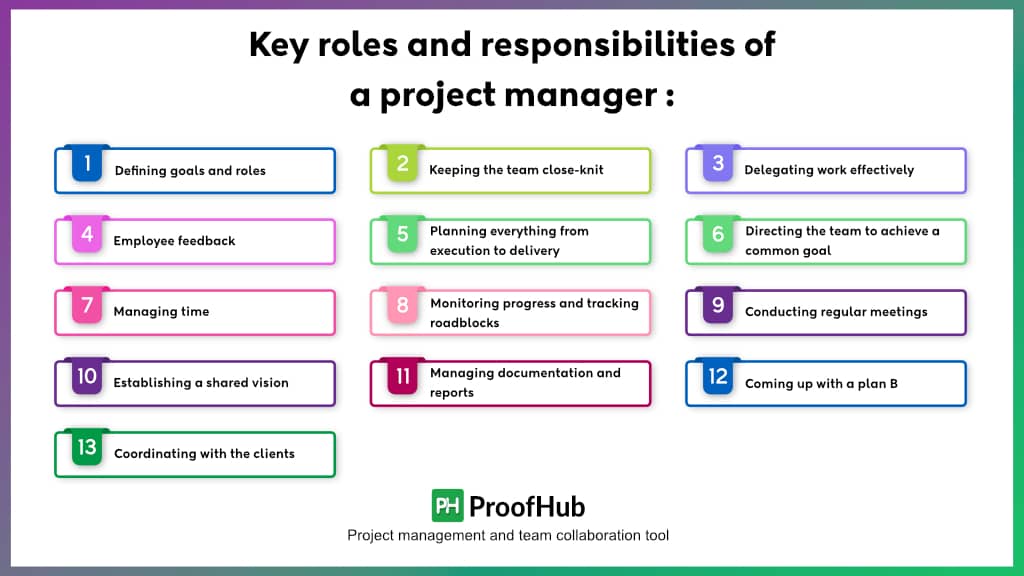
1. Defining goals and roles
Let’s take an example of a website-building company. You will first start by making a bigger picture of the major attributes to which your company contributes. This primarily depends on your customers or the niche in which your business serves.
Defining the role of HR would be limited to hiring and other practices related to administration. Similarly, developers would focus on coding and developing websites.
However, as a project manager, your role would be the center to hold the entire project together. Ensuring enough manpower and resources, and conveying task details to individual team members are all roles of a project manager.
2. Keeping the team close-knit
Focus on building a team that ‘works together’. Start by defining primary roles for the departments. To simplify this process, define goals! When you know what your goals are, you will be able to define roles for each department with ease.
With clearly defined roles, maintaining harmony in the team and fostering trust within its people is the next process so that everyone can achieve more and achieve fast.
For this, you need to ensure that:
- Every member of your team gets regular feedback.
- Everyone understands their individual tasks.
- Everyone communicates well.
- The team has enough resources and tools for effective collaboration .
3. Delegating work effectively
As a project manager, it becomes critical to delegate tasks to your team members effectively. It is a leadership style that every project manager has to learn and adapt. You should not misuse this responsibility by blaming or degrading your team members.
You should understand the strength and weaknesses of your team members and delegate the tasks to them accordingly. Your team members must be able to prioritize tasks .
This is where you need to think smart!
Think out-of-the-box!
How about getting help from a project management tool?
This will simplify not only the delegation process but also help in effectively managing the schedule of the project.
ProofHub is an all-in-one project management and team collaboration tool . You can use this tool for delegating tasks, monitoring progress, communicating with your team members, and also for real-time collaboration .
Take control of your projects with ProofHub: Track, manage, and prioritize tasks effortlessly in one centralized platform!
4. Employee feedback
Of all the roles you are involved in as a project manager, gathering employee feedback plays the most crucial role. As the project progresses, it is essential to review the performance of your team members.
It is obvious that over the course of the project, the roles of different individuals may change. Therefore, such reviews will help in providing feedback to your team members about updates.
It is important to note here, that the objectives of the company might not have changed, but the way to reach there would have. This is the reason why you need to be in close proximity to your team at all times.
5. Planning everything from execution to delivery
Ideally, you should have a strategy to achieve more in less. By more I mean, more outcomes, more quality, and more client satisfaction, while less refers to less resources and less time. In simple words, you must chalk out a pathway that will help you to complete the project successfully and efficiently. You could use any approach like Agile, Waterfall, etc. However, remember that your team should also be comfortable working in this environment.
All in all, for strategies and planning your project manager skills should involve
- Breaking the project into tasks and sub-tasks.
- Steady progression by taking up tasks in small chunks.
- Setting an appropriate schedule for the development of certain deliverables.
- Defining milestones.
- Highlighting the project dependencies.
Effortlessly plan tasks, collaborate seamlessly with your team, organize files efficiently, and deliver projects on time – all within a single platform!
6. Directing the team to achieve a common goal
You should ensure that your team is on the right track toward success.
Have you ever seen what a good shepherd does?
He guides all his sheep and goats on the track toward greenery.
Similarly, keep your team members motivated, so they continue moving on the right track. It is your responsibility to ensure that your team showcases their full potential. In some instances, you will have to own up tasks of other domains.
For wisely directing your team your project manager attributes must be similar to that of human resources like
- Negotiating current employees’ job responsibilities,
- Managing their time, and achieving their commitment to the project,
- Bids may be required, and
- Contracts will need to be reviewed and keeping everyone in check to make sure that the team moves along in accordance with the plan.
Moreover, implement Agile practices in your teams. This is how you can improve the accountability of the team members. This would help the team become cross-functional which would mean that you will be making the team:
- More adept to taking on challenges and dealing with changes in client requirements.
- More capable of coordinating with clients and juggling responsibilities,
- More comfortable with changing roles and working in more niches than just one.
7. Managing time
Time is the most crucial resource in project management . This decides the base on which the entire project revolves. You should be able to negotiate deadlines on behalf of your team members.
Effective time management is possible through strategic planning and scheduling. Delegate tasks to your team members and set a deadline.
Identifying bottlenecks early also plays an important role in the timely completion of a project. When you forecast your available resources effectively, you will be able to face sudden challenges related to resources and solve them with ease.
Pro Tip: I always encourage my team members to use the Pomodoro Technique. This basically means they work with full focus for 25 minutes, and then take a break for 5 minutes. This technique prevents burnout and improves the overall productivity of my team.
Stop wasting time manually scheduling your team’s resources. Find the best resource scheduling software for your needs with just one click!
Streamline productivity, save time, and discover clarity with ProofHub!
8. Monitoring progress and tracking roadblocks
This is the most time-consuming part of your daily work routine. There are a lot of technicalities related to this phrase. Excessive monitoring may cause resentment among your team members. And at the same time if you do not have real-time updates on the project progression, then you will not be able to forecast timely completion.
Project management software come in as a savior at this point. With ProofHub you have complete control over your team. You can view task progression and workload on your team members. These details will help you to forecast resources and identify bottlenecks, and areas for improvement of your team.
Further, you need not overburden yourself with responsibilities. Automation (in the form of automation of repetitive tasks) comes in handy and ensures that project progression is not hindered.
9. Conducting regular meetings
The first thing before conducting meetings is that you should prepare an agenda. This will ensure that your team is aware of the purpose of the meeting.
“ Growth is never by mere chance; it is the result of forces working together” . – James Cash Penney
Regular team meetings depend on the project methodology you are working on. In Scrum methodology, there is a 15-minute meeting every day. This is the time for you to establish a status quo with your new team members.
If you are using a project management tool, then it is not important to have daily meetings or long meetings. As long as your team members are on the same page, you can let them work independently. Modern workplaces have very short meetings that are mostly focused on the agenda that is shared well before the meeting starts.
On a project management tool , your team can collaborate, discuss and share files in real time on the centralized platform, thereby eliminating the need for physical meetings.
10. Establishing a shared vision
Your vision should match the vision of the business. This is how you will be able to focus your efforts in the right direction.
Then comes the part where you convey this to your team members. Having all your team members on the same page is necessary for motivating and inspiring the team.
In order to establish a shared vision, you need to bring enthusiasm and positive vibes into your team. This helps your team to understand the workload and make all possible efforts to convert goals into missions.
You are responsible for setting the appropriate tone for smoother sailing down the road.
A vision fosters team cohesion, boosts creativity and motivation, and imbibes a purpose that helps in the successful and timely completion of the project .
11. Managing documentation and reports
As the project progresses, there will be hurdles, milestones, and other issues that may creep up. It is essential for you to maintain a record of time and budget.
These documents and reports will come in handy for identifying areas where there is a need for improvement in future development programs. Also, these documents will help you to prepare reports for submission to clients.
Further, these documents play two additional functions, in the overall project progression –
- To maintain a record of what has been done in the project and who has been involved in it.
- To ensure that the project satisfies all the project requirements.
Pro Tip: Not a biased one, but how can I not say this? ProofHub is your best friend for managing documents and reports!
Depending on the size of the project, you will have to manage various documents and reports. ProofHub offers you visualizations, reports, and data dashboards to simplify this complex task.
Further, ProofHub acts as a centralized platform for storing all information related to the project such as – who is responsible for what, who reviewed them, the completion date of various tasks, etc.
No communication gaps, no more disorganized work, no more failed project in 2024!
12. Coming up with a plan B
A major responsibility comes with the fact that as a project manager, ‘you should always be on your toes’. Not literally! You will hurt yourself in the process.
Preparedness for unforeseen events and circumstances is essential for ensuring that the project is risk-proof.
In order to keep a cycle moving, you pedal continuously, even if the roads are bumpy.
Similarly, for a project to have a steady progression, you need to keep putting in effort. As a project manager, you should be familiar with the basics of risk as well as change management.
You must know how to:
- Arrange for extra resources.
- Manage time in difficult circumstances.
- Have an alternate plan to justify the expectations of the clients.
13. Coordinating with the clients
Your responsibilities also include coordinating with the clients! Not as easy as this sounds, this can in some instances become challenging.
You are primarily responsible for negotiating the requirements of the project with the clients and the stakeholders. It is necessary for you to bring clarity to the clients about how they should go about the project and everything that the team can do for them.
As a PM, you become the bridge between your team and the clients. Any changes or feedback from the client should be conveyed to the individual team member in the most effective manner.
Bear in mind, the following points for smooth coordination
- Share feedback often for continuous improvement of your team, as well as the performance of the whole project.
- Appreciate positive feedback and celebrate accomplishments.
- Avoid the blame game, especially in case of negative reviews.
What does a project manager do?
A project manager plays a crucial role in planning, executing, and closing projects. The role involves a wide range of responsibilities to ensure that a project is completed successfully, on time, and within budget.
It becomes the project manager’s responsibility to complete the company’s most important projects, and for this, you will have to polish your leadership skills , coordination abilities, and motivational skills continuously.
The importance of a project manager
89% of organizations have a project management office. This shows the growing necessity of PMO in almost every business.
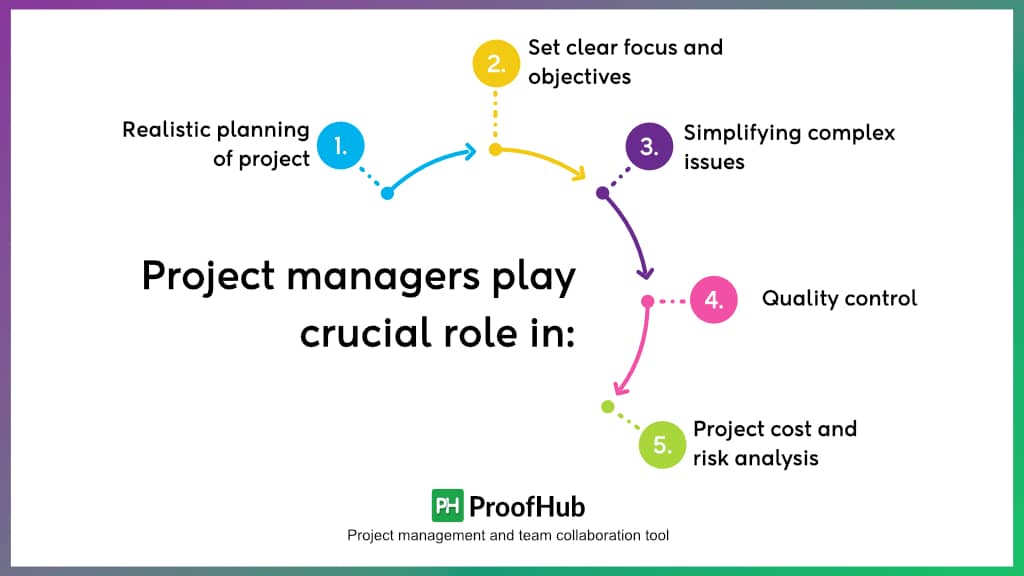
Let’s briefly discuss the importance of a project manager –
1. Realistic planning
A successful project depends hugely on planning and creating a strategy. Never underestimate the planning phase. Random estimates and approximate delivery dates are recipes for project failures .
This is where you lay the foundation for the project. The smooth project progression and the timely completion of the project depend completely on effective and realistic planning.
2. Set clear focus and objectives
Try letting your team members work on a project without proper objectives and focus . You will see them create a muddle out of the project!
As a project manager, it is your responsibility to set guidelines for the steady flow of the project. Right from start to end, you need to ensure that your team members stay on track in order to ensure timely completion of the project. This is like herding a sheepfold safely from the barn to the pasture.
3. Simplifying complex issues
Your expertise as a project manager shows when you break down tasks into manageable chunks for your team. This helps them in setting priorities as well as milestones.
This will contribute towards the timely completion of the project. You will be able to handle complex issues with better agility when working on small tasks.
“I would like to take you back to 2017, the controversy around Google’s diversity memo. Sundar Pichai, the CEO of Google, and Alphabet Inc. handled this incident with transparency, inclusivity, and grace.
His skills as a seasoned manager were on display when he organized town hall meetings to address this issue. He did not focus on trying to silence the employee and ignore the issue but rather chose to openly discuss this issue portraying diversity and inclusion. He also reaffirmed the company’s commitment to a supportive and inclusive work environment.“
Although the example is of a CEO, while we are talking about project managers, my aim here was to portray how to act quickly and respond to critical issues effectively. These are the skills that define a successful project manager and sets them apart.
4. Quality control
A team can complete projects on time, but the essential component is ensuring quality. Completed projects may become useless if they do not fulfill quality requirements.
A project manager ensures the quality of the project by defining standards. This lets the team members know what they are aiming for.
5. Cost factor
As per a study , 9.9% of every dollar is squandered due to poor project performance. A project manager helps in saving a lot of money for the organization.
As a skilled project manager, you should be able to improve efficiency, mitigate risks and optimize resource utilization. All these factors help in combating the waste of resources and help in the growth of the organization.
What qualifications do you need to be a project manager?
Let’s now talk about the point of qualifying to become a project manager.
If you believe you have the capabilities of being a project manager, you need to authenticate them in the form of certificates or experience.
Getting a (PMP)® certification is one of the key requirements for becoming a project manager. Project managers having this certificate have an elite identity. They showcase leadership and expertise in working.

Project Management Professional (PMP)®
This certification is valid across the globe. However, to get this certificate you need commitment and perseverance. Along with real-world project management experience, the basic requirement to qualify for this certification includes
👉A four-year degree
👉36 months of experience leading projects in the past eight years
👉35 hours of project management education/training or CAPM® certification
Or in case you have a High school diploma, then you will require
👉60 months of experience leading projects in the past eight years
Project Management Institute (PMI) is the apex body that has the ultimate control over issuing the (PMP)® certification.
So, fellow project managers, we’ve journeyed through the 13 key roles and responsibilities that define our craft. From captains of the ship to expert jugglers, we’ve explored the diverse landscape of project management.
Now, you might wonder, “ Can I embody all these roles? Can I excel in each responsibility?” Absolutely! No project manager starts as a master of all trades. It’s a continuous learning process, filled with triumphs, setbacks, and “aha” moments.
Embracing these roles isn’t about rigid checklists. It’s about adapting and evolving as each project unfolds. It’s about harnessing collaboration, communication, and innovation to guide our teams to success.
Cheers to the adventurous road ahead!
What are the two types of project managers?
The two types of project managers are traditional project managers, who use pre-existing structured methodologies, and agile project managers, who use adaptive and iterative approaches.
What skills are required to be an effective project manager?
Effective project managers require skills such as leadership, organization, communication, problem-solving, adaptability, and client management skills to successfully plan, execute, and complete projects within the set time and budget.
What are the main challenges faced by project managers?
The main challenges faced by project managers include managing scope creep, understanding priorities, communication issues, resource utilization, and meeting project deadlines.
How does a project manager plan and organize projects?
A project manager plans and organizes projects by defining project objectives, setting timelines, allocating resources, identifying priorities, setting milestones, and developing an efficient management plan.
What is the difference between a project manager and a project team member?
A project manager is responsible for the execution and the overall project, while a project team member is an individual contributing to specific tasks or activities within the project.
What tools and software are commonly used by project managers?
Project managers commonly use project management software or tools for simplifying the overall project progression. The most preferred tools include ProofHub, Asana, Microsoft Project, and so on.
How does a project manager track and measure project progress?
A project manager tracks and measures project progress by using key performance indicators (KPIs), milestones, regular updates, progress or analysis reports, and by using project management software.
What are the qualities of a successful project manager?
Effective communication, strong leadership, organizational skills, adaptability, problem-solving abilities, risk analysis, client management, and the ability to motivate and empower team members.

- Share on LinkedIn
- Email this Page
- Share on Facebook
- Share on WhatsApp
Try ProofHub, our powerful project management and team collaboration software, for free !
No per user fee. No credit card required. Cancel anytime.
Jira Software
Project and issue tracking
Content collaboration
Jira Service Management
High-velocity ITSM
Visual project management
- View all products
Marketplace
Connect thousands of apps and integrations for all your Atlassian products
Developer Experience Platform
Jira Product Discovery
Prioritization and roadmapping
You might find helpful
Cloud Product Roadmap
Atlassian Migration Program
Work Management
Manage projects and align goals across all teams to achieve deliverables
IT Service Management
Enable dev, IT ops, and business teams to deliver great service at high velocity
Agile & DevOps
Run a world-class agile software organization from discovery to delivery and operations
BY TEAM SIZE
Small Business
BY TEAM FUNCTION
Software Development
BY INDUSTRY
Telecommunications
Professional Services
What's new
Atlassian together.
Get Atlassian work management products in one convenient package for enterprise teams.
Atlassian Trust & Security
Customer Case Studies
Atlassian University
Atlassian Playbook
Product Documentation
Developer Resources
Atlassian Community
Atlassian Support
Enterprise Services
Partner Support
Purchasing & Licensing
Work Life Blog
Support for Server products ends February 15, 2024
With end of support for our Server products fast approaching, create a winning plan for your Cloud migration with the Atlassian Migration Program.
Assess my options
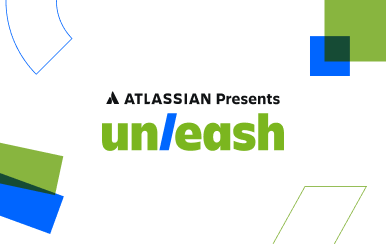
Atlassian Presents: Unleash
Product updates, hands-on training, and technical demos – catch all that and more at our biggest agile & DevOps event.
- Atlassian.com
Transform teamwork with Confluence. See why Confluence is the content collaboration hub for all teams. Get it free
- The Workstream
- Project management
- Project manager
What is a project manager? Responsibilities and best practices explained
Browse topics.
A project manager, or PM, coordinates the elements of a project, aiming for timely completion within budget and with high standards. They're the central figure connecting project goals with the collective efforts of their team and help navigate obstacles to guide projects to their goals.
This guide explores the role of PMs, highlighting their critical responsibilities, key skills, and best strategies. It also examines how platforms like Confluence can help PMs enhance team collaboration and communication across the project life cycle .
What is a project manager?
A PM is a leader who guides projects from the drawing board to the finish line. They make sure everything runs smoothly and stays on schedule. They gather necessary resources, unite team members, and work on continuous improvement .
PMs connect the day-to-day work with the bigger picture. They support the broader objectives of the company and satisfy stakeholder needs.
Project manager responsibilities
PMs juggle a variety of core responsibilities to lead a project through hurdles and changes. Mastery in each of these areas contributes to a smoother experience from the perspective of both team members and stakeholders:
- Project planning : PMs initiate the planning process, clearly defining the project's scope, goals, and objectives. They develop detailed plans outlining tasks, resources, timelines, and deliverables, creating a solid foundation for project execution.
- Team coordination : Project managers assemble and direct project teams, assigning tasks based on members' skills and experience. PMs focus and unify team efforts by promoting collaboration, resolving conflicts, and leading effective team meetings .
- Risk management : PMs identify potential risks early, analyze their possible impact, and develop mitigation strategies. This proactive approach minimizes disruptions to the project’s schedule, quality, and budget.
- Budget oversight : PMs estimate costs, establish budgets, track spending, and adjust as necessary to keep the project within financial boundaries while achieving fiscal efficiency.
- Client communication : They maintain open and transparent communication with clients and stakeholders. PMs provide updates, respond to inquiries, and use feedback to adapt project scope to meet or exceed client expectations.
- Maintaining quality standards : PMs implement quality control processes to ensure deliverables meet agreed-upon standards and satisfy client requirements. This helps maintain project integrity.
Project manager skills
The success of any project depends heavily on the unique blend of soft and hard skills possessed by the PM. Here are some of the critical soft skills that PMs need to excel in their role:
- Communication : PMs must master verbal and written communication to convey project objectives, updates, and feedback to all stakeholders. This fosters alignment and collaboration throughout the project life cycle.
- Adaptability : PMs need to respond to project shifts and unforeseen challenges with flexibility. They must be able to adjust strategies and plans to keep projects moving forward.
- Problem-solving : PMs must approach issues decisively. They use critical thinking to analyze problems, devise solutions, and apply them effectively. This minimizes the impact on project progress and outcomes.
- Leadership : PMs provide team leadership to inspire and motivate. They guide team members, support their development, and cultivate a collaborative environment.
- Organizational skills : Exceptional organizational abilities allow PMs to balance multiple tasks and priorities. They skillfully map out schedules, allocate resources, and monitor project timelines to guide their team toward success.
Best practices for project managers
Great PMs commit to applying best practices consistently across projects. They understand that good project management comes from a blend of skill, strategy, and continuous refinement. Here are some key best practices:
Prioritize clear communication
Clear communication keeps everyone moving in the same direction and places transparency and efficiency at the heart of the team's workflow . Encouraging open exchanges of ideas, progress updates, and concerns helps the team tackle obstacles head-on and propels the project forward.
Create effective project plans
Well-structured project plans contain the following key elements:
- Scope : Define the project scope clearly. This helps prevent scope creep and ensures everyone understands the project boundaries.
- Goals and objectives : Establish what the project aims to achieve. Objectives should be specific, measurable, achievable, relevant, and time-bound.
- Milestones and timeline : Identify crucial milestones and create a timeline that outlines when each project phase should be completed.
- Resources : Detail necessary resources (people, budget, technology) and allocate them effectively. This includes identifying roles and responsibilities.
- Risk management : Anticipate potential risks and strategize how to address them. This fosters a proactive approach to uncertainty management.
- Communication plan: Outline how you will handle communication within the project team and with stakeholders. This includes frequency, methods, and key points.
Use project management tools
Using specialized project management software empowers PMs to excel in their roles.
Project manager software is a centralized hub for everything project-related, including plans, tasks, and resources. This simplifies outlining projects, distributing tasks, and tracking deadlines. Everyone stays in the loop, reducing mix-ups and enhancing teamwork .
Project management software also improves how teams communicate. Tools facilitate smoother updates, collaborative problem-solving, and efficient coordination. This includes commenting, file sharing, and simultaneous editing.
Confluence is the premier project management solution for PMs seeking to overcome the common PgM challenge of fragmented communication and scattered data and documents. The platform serves as a central repository for all project-related documents and knowledge. Information is readily accessible to anyone who needs it, allowing PMs more time to focus on strategic tasks.
Empower your team
An inspired and empowered team not only boosts productivity but also becomes a driving force behind project success. Effective PMs cultivate a positive work environment through various team management strategies , such as:
- Ensure each team member knows their role, expectations, and how their work contributes to the project's success.
- Give team members the freedom to make decisions about their work. This builds trust and encourages innovation.
- Provide opportunities for team members to develop their skills and grow professionally. This can include training, workshops, or taking on new challenges within the project.
- Regularly acknowledge and celebrate achievements, both individually and as a team.
- Create an environment where team members feel comfortable sharing their ideas, concerns, and feedback.
Effective project management with Confluence
Confluence transforms project management through centralized collaboration and efficiency. It serves as a dynamic platform where teams unite. They can share and update project plans in real-time, keeping everyone aligned and informed. Confluence offers many features for effective project management, including:
- Simultaneous editing : Say goodbye to endless email chains. Edit documents together.
- Ready-made templates : Jumpstart your projects with templates for everything from meeting notes to project plans .
- Task management : Assign and track tasks right in your documents, keeping everyone accountable.
- Effortless organization : With powerful search and sorting capabilities, finding what you need is a breeze.
- Seamless integration : Jira works with other third-party apps, putting all your tools in one place.
Confluence is more than a tool—it's a game-changer for teams dedicated to improving how they manage projects and collaborate. It also supports versatile content types – think pages for detailed documentation, whiteboards for brainstorming, Loom videos for walkthroughs, and databases for structured information. AI capabilities further expand Confluence’s feature set by summarizing text, highlighting action items, and even adjusting the tone of specific communication.
Try Confluence today and experience a unified workspace that propels projects forward.
Project manager: Frequently asked questions
What does a project manager do on a daily basis.
PMs juggle various tasks daily, including monitoring project progress, talking things through with stakeholders, tackling issues that arise, and tweaking plans to keep everything on track with the project's goals.
What are project management methodologies?
Project management methodologies act as blueprints for navigating a project's life cycle. Agile and Scrum are great for fast-paced, iterative projects. Waterfall and Lean work better for projects with a defined sequence or a focus on minimizing waste.
Why is a project manager important?
A project manager is vital because they act as the bridge between a project's plan and its execution. A PM's core role is to ensure that projects meet deadlines, stay within budget, and adhere to quality standards. Their expertise in managing timelines and resources prevents miscommunication and scope creep.
What is the difference between a program manager and a project manager?
A program manager oversees a group of related projects, focusing on long-term objectives and the overall impact on the company's goals. A project manager is responsible for the daily operations of a single project. They concentrate on meeting specific deadlines, budgets, and scope.
You may also like
Project poster template.
A collaborative one-pager that keeps your project team and stakeholders aligned.
Project Plan Template
Define, scope, and plan milestones for your next project.
Enable faster content collaboration for every team with Confluence
Copyright © 2024 Atlassian

How to Manage Team Tasks: The Complete Guide
Last updated on 28th March 2024
In this article we’re going to take a look at how to manage team tasks. We’ll cover everything from the benefits to things to avoid, and everything in between.
In other words, people want an easier way to manage tasks but they don’t know how to implement that. Hopefully this complete guide to team task management will help!
Article Contents
What is team task management?
Team task management is the process of organising, tracking, and delegating the tasks of your team to ensure your project runs smoothly and efficiently.
Tracking the task progress of multiple team members can be made easier through the use of task management software tools.
Task management software can help you assign tasks, improve communication between your team, monitor task progress, and give you the visibility you need to see if you’re on track to meet deadlines.
The difference between task management & project management
It can be easy to mistake task management for project management, and vice versa. However, there are some distinct differences that separate the two.
Project management is more about the bigger picture. When you’re managing a project (or multiple projects), there are lots of moving parts to consider, such as stakeholder inputs, budgets, the scope of the project, and so on.
Whereas, task management is more nuanced. Task management focuses specifically on the tasks that need to be completed in order to move the project forward.
An easy way to remember the difference is that task management focuses on the here and now, completing the work in front of you. Project management requires more forward thinking and planning.
5 benefits of task management for teams
1. increased productivity .

When you manage your team’s tasks effectively you benefit from increased productivity. This is because tasks are allocated to the right people, giving everyone a clear understanding of their own responsibilities.
You can also make deadlines clear so that people are able to prioritise the right tasks in order to ensure complete projects efficiently and on time.
And this isn’t just great for managers, team members also benefit from transparent task management. According to our Project Management Statistics , 94% of people feel that having a good view of what their teammates are working on improves productivity and efficiency in a business .
2. Less chance of re-work

When tasks are managed properly, everyone on your team will know exactly what their roles and responsibilities are. This is great for reducing the amount of re-work that people have to do.
Re-work occurs whenever something is done incorrectly and has to be corrected. It can be caused by multiple people mistakenly working on the same task or someone misunderstanding the expectations of completing the task.
Either way, solid team task management can resolve this issue and reduce the amount of time wasted on re-work.
3. More team collaboration
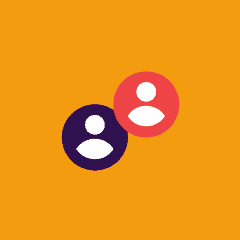
Did you know that an astonishing 92% of people say they believe collaboration with their teammates could be improved ?
One way you can solve this issue is – you guessed it! – team task management. When you manage your team’s tasks effectively you can foster a sense of team collaboration by helping everyone understand that the individual tasks they’re all working on will come together to achieve a common goal.
When teams are motivated to work together more closely you benefit from improved communication, more shared information, and a better feedback exchange between everyone.
4. Increased visibility

Managing team tasks correctly gives you more clarity into what each team member is working on at any given time. This is important as it can help you monitor project progress and resource allocation, so you can ensure everything runs as smoothly as possible.
When you use team task management software to manage tasks, you can benefit from even better visibility by being able to view everyone’s tasks visually on one screen. This can give you an understanding of potential bottlenecks and ensure you’re agile enough to make quick changes to people’s workload in order to keep your project on track.
5. More data

Effective team task management generates valuable data that you can use to document your project’s progress and inform future projects.
You can gather data on things like your team’s productivity, task completion times, and resource allocation. So that you know how long certain tasks take, how much resource is required, and who is better suited to certain tasks. All of these insights can optimise your workflows and make for better planning on your future projects.
Manage team tasks: 7 tips
1. use a task management tool.
Using a task management tool will make managing team tasks a whole lot easier for you. After all, it’s what they’re built to do!
A task management app can make sure you have all of the tools you need for managing tasks at your fingertips. This includes things like: the ability to assign tasks to different team members, the power to track progress in a visual way, organise tasks, and generally everything you need to manage tasks effectively.
The best task management tools will also offer additional features to assist with project management, like time tracking, and the ability to set recurring tasks and task dependencies.
2. Be clear about expectations
It’s important to be clear with your team from the outset on everything that you expect from them. This includes defining tasks and goals, demonstrating how to use your task management software, and explaining what constitutes success in terms of their tasks.
This clarity will minimise confusion, promote efficiency, and hopefully empower your team when it comes to their own personal task management.
3. Set clear deadlines
Along with setting clear expectations, it’s also important to be explicit about task deadlines. Deadlines will help your team to better manage their workload, and they can also create a sense of urgency to help keep your team’s productivity high.
Of course, it’s also important for deadlines to be realistic. If staff members feel as though deadlines are impossibly difficult to stick to then this could lead to burnout and project failure .
4. Manage accountability
When everyone on your team understands their own personal tasks and has a sense of ownership over them you can foster a sense of accountability within the team.
This is important because when people feel responsible for their tasks they are more likely to conduct them with a sense of pride and professionalism. Holding team members accountable for their contributions in this way can help you keep projects on track.
5. Communicate regularly
While you don’t want to micromanage your team, it’s also important that you don’t put too much distance between them and yourself as this could lead to them feeling a little adrift, isolated, and possibly confused over next steps when it comes to their tasks.
Regular communication is key to any successful project and for effective task management. Ensure everyone on your team knows exactly how to reach you if they need clarification, and also let them know how they can communicate with each other so that they can share important updates and improve team collaboration.
6. Assign attributes to your tasks
Assigning attributes to your tasks is a good way of giving your team more specific details on what they’re required to do. Things like task dependencies and assigning tags or priority levels will help your team members understand what to do next and give them a better understanding of their workflows.
7. Track your progress
Tracking the progress of project tasks will give you much needed insights into team performance, and allow you to identify bottlenecks so you can adjust timelines if needed.
Tracking progress also allows you to celebrate milestones with your team. This is great for keeping morale and productivity high and ensuring your stay on track to meet your deadlines.
Things to avoid with team task management
1. do not change the scope.
When you set a task, and you also set expectations of your team for what constitutes that task being completed, the last thing you want to do is change the scope.
Changing the project scope without discussing first with your team can lead to delays, confusion, and conflict. It may also result in people having to re-do some of their work which can lead to a decrease in productivity and morale.
So, where possible, try to avoid changing your requirements when work has already started on a particular task. And, if you do need to make changes, be sure to have a thorough discussion with team members as early as possible.
2. Don’t scrimp on explanations
Task requirements and instructions need to be communicated in a clear and comprehensive way. It’s important to take the time to give your team members the context they need to complete their tasks to an acceptable level.
Explanations that are rushed, vague, or incomplete will likely lead to misunderstandings and errors that could cause delays to your project.
3. Be careful not to overload people
It’s important to make sure that tasks are distributed fairly and that not one member of the team feels burdened by an excessive workload. Of course, it’s important to challenge your team and keep your project running in a quick and lean way so that you can benefit from the most success, but it’s a fine line to tread.
Giving people too much work can lead to burnout and also compromise the quality of work produced. So remember to check in on your team’s tasks regularly and ensure everyone is managing well.
4. Don’t micromanage
If you’ve thoroughly explained the scope of the project and all of the tasks your team needs to complete, then you should be able to step back and give them room to work independently.
It can be tempting to pay close attention to what your team’s working on, almost to the point of micromanaging, but this can be really demotivating and stifle the creativity of your team.
Instead, be clear and confident in your requests, provide guidance, and let your team know where to find you if they need additional support.
How to manage team tasks with Project.co
Managing team tasks is SO much easier when you have a software tool you can rely on. Project.co is a great way to keep all of your project-specific information in one centralised place, including team members, discussions, files, and of course, tasks.
So, let’s create a project and walk you through exactly how to manage your team’s progress with Project.co.
Starting from the top, it’s easy to create a new project from your dashboard. Just click ‘+Create New’ in the top right-hand corner and then select ‘Project’:

From there, customise your project. Add a name, description, cover image if you want to, and more. Then click ‘Create Project’:
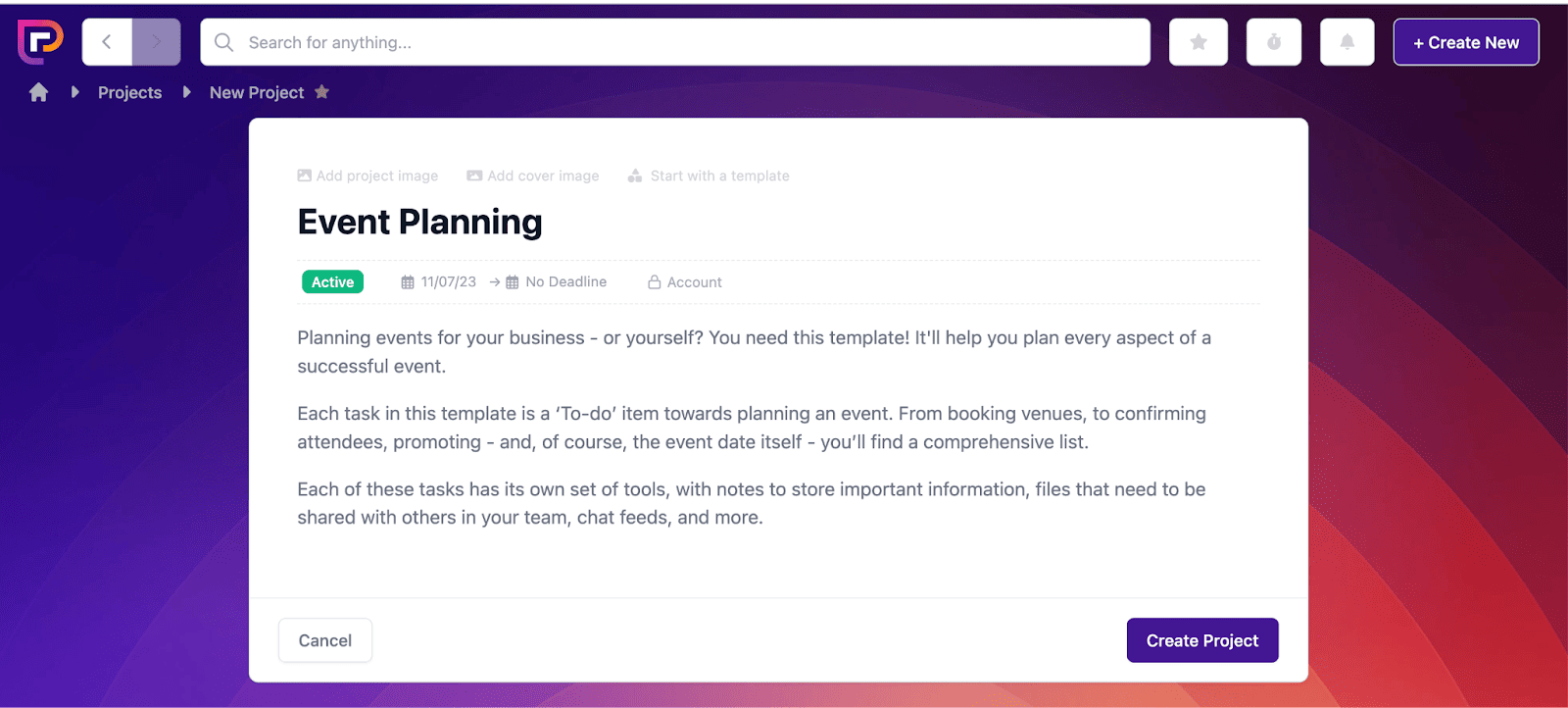
Now you can add your team. Again, this is super easy. Just click ‘Add people’ and invite your team to join via email:
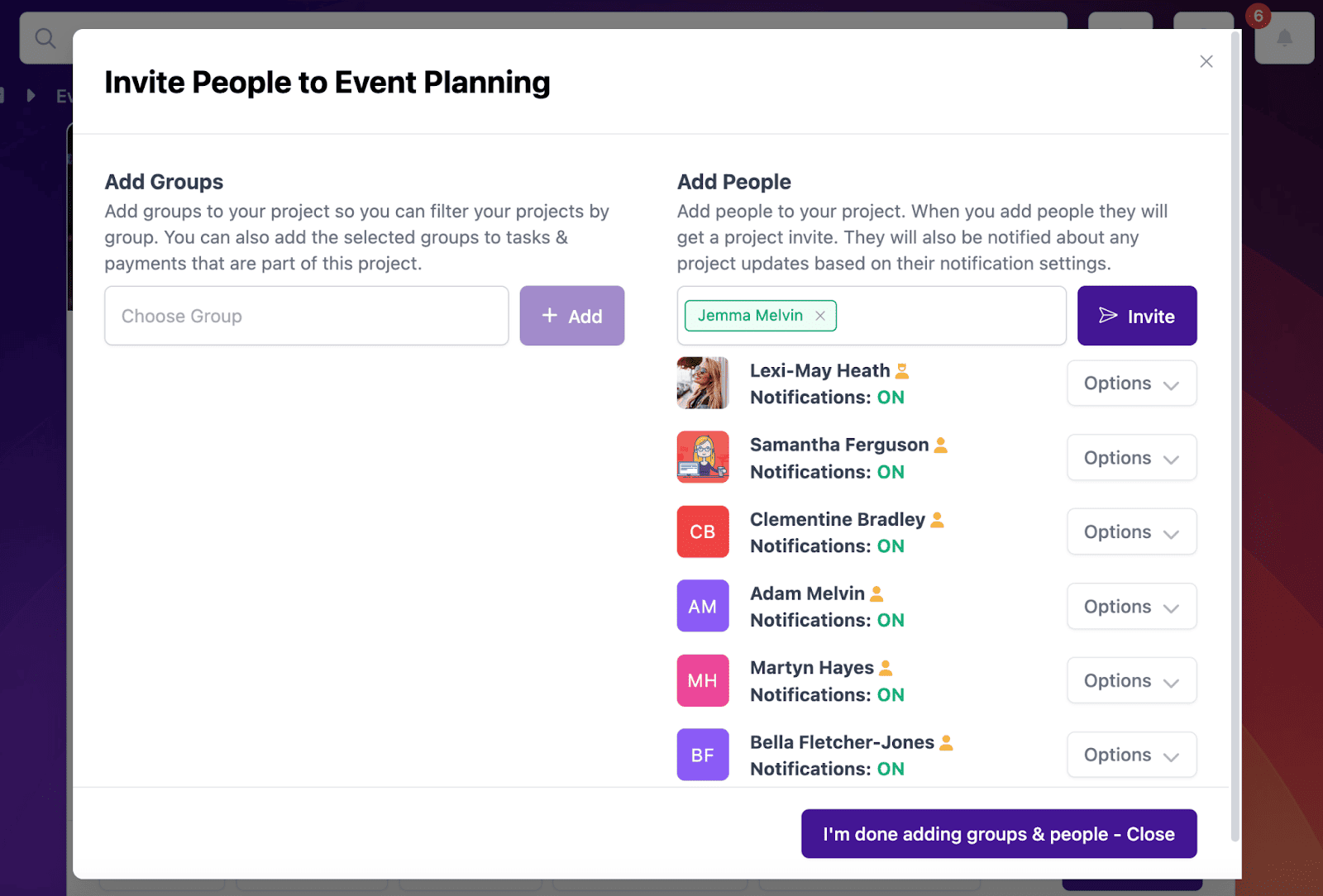
You’ll also want to add tools to your dashboard here. For managing a team, the most important tools are probably going to be Tasks, Time, and Discussion.

Now, let’s actually start adding your team tasks! From the Tasks tab, all you need to do is hit ‘New Task’ and then customise your task. Give it a name, add notes and files if you need to, assign a team member, and a deadline.
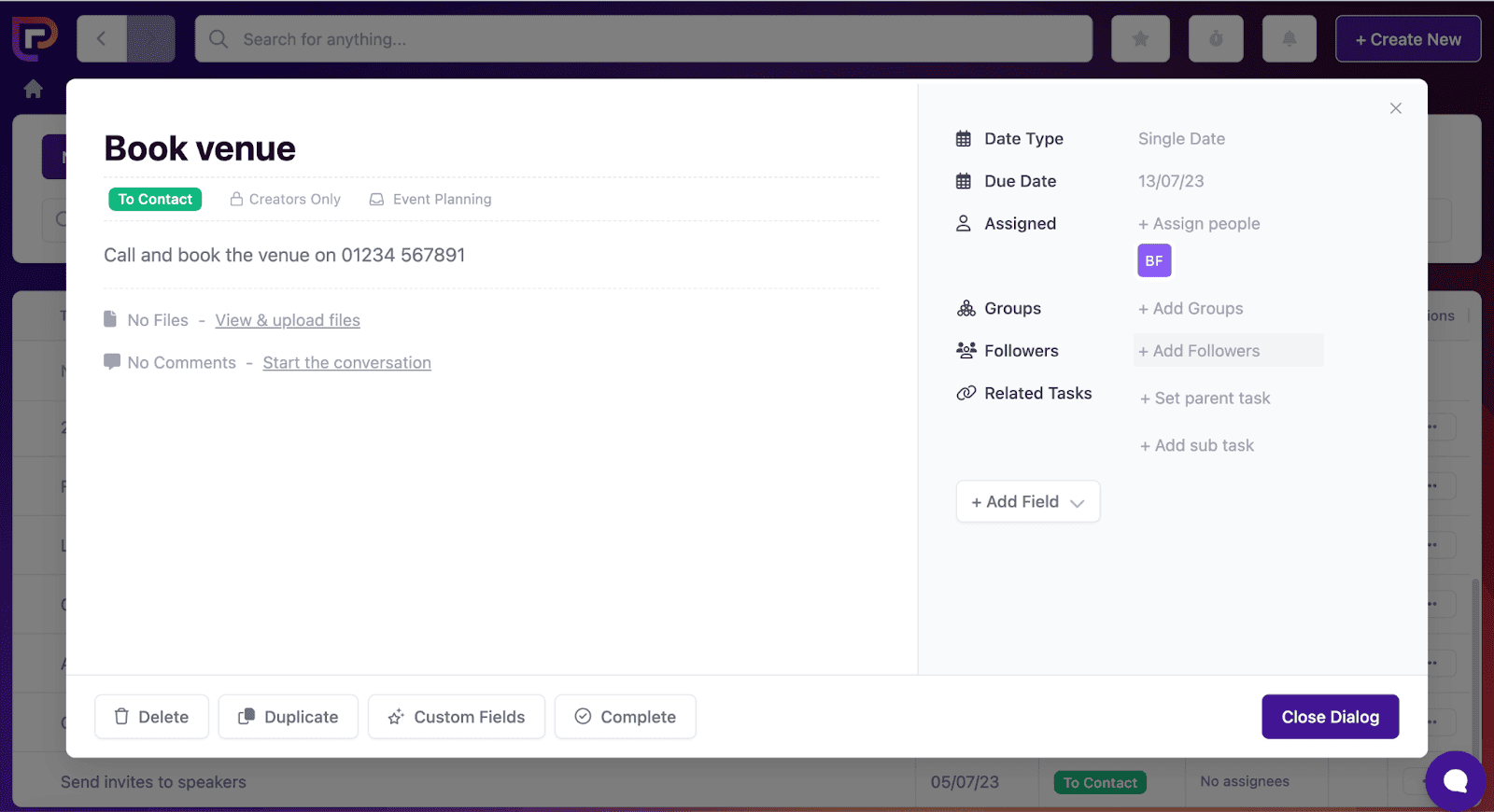
As the manager, you can add yourself to the task as a follower to keep up to date with the progress. You can also view all of your team tasks visually in a number of different ways, such as the calendar view:

And Kanban:

It’s easy to track and manage your tasks from here. You can simply drag and drop tasks onto new dates or different team members, depending on how your project is progressing.
Final thoughts
To manage team tasks successfully requires a lot of organisational skill, a lot of forward-thinking, and the ability to think on your feet and make quick decisions.
There’s no reason to do all of that alone when there are plenty of amazing task management apps and tools out there that can help.
Open your first project today and see just how easy it is to manage team tasks with Project.co .
Create your FREE account

- Start For Free

Project Management Guide
– what is project management, – what is a project, – why is project management important, project life cycle phases, – project initiation, – project planning, – project execution, – project monitoring, – project closure, project management methodologies, – waterfall project management, – critical path method, – critical chain project management, – agile project management, – scrum project management, – kanban project management, – lean project management, – six sigma project management, – prince2, – prism, – pmbok method, project management faq, what is project management, what is a project, why is project management important, - project initiation, - project planning, - project execution, - project monitoring, - project closure, - waterfall project management, - critical path method, - critical chain project management, - agile project management, - scrum project management, - kanban project management, - lean project management, - six sigma project management, - pmbok method, what is a task in project management.
In Greek mythology, the god Apollo asked the hero Hercules to perform 12 difficult tasks. These were not linked to one another but had the overall goal of letting Hercules rest without regret.
For today’s project managers, tasks are equally important when applied to the successful completion of a project. The first thing to understand is: what is a task in this context?
Very simply, a task is a unit of activity that must be completed in order to execute a project. All such defined tasks have to be finished for the project to be completed.
Tasks can be big or small. They could be done by one person or by a team. They can be complex, containing sub-tasks, or they could be individual actions.
You can conveniently view a task as a unit of work within a project that has to be completed within a certain time.
To make it easier for you to understand the role of tasks in project management, let’s take it up in three stages:
- How to Define Project Tasks
How to Break Down a Project into Tasks
Task scheduling and dependencies.
By the end of this blog, you should have a comprehensive idea of how to view your project as a series of tasks, how to manage and distribute those tasks, and how to correctly create a time-driven agenda to complete them.
How to Define Tasks in Project Management?
One can look at tasks in project management as a building block of a project. Tasks are also sometimes referred to as project activities, but the intent is the same. It’s by completing these in order, one by one, that the overall project is completed.
Here’s one way to make the nature of a task even more clear. Your project scope will mention a set of deliverables. Ask yourself what steps need to be taken in order to complete those deliverables. Each step can be seen as a task.
Importantly, such a breakdown should enable you to assign resources as well as a timeline to tasks.
Some people make an interesting comparison between deliverables and tasks. Deliverables can be described as nouns: that is, things and places, for example. And tasks can be defined as verbs: action words such as prepare, build, create, and so on.
Let’s take an example. A project deliverable could be the successful construction of a new road between two points. When you break this down into tasks, you could come up with: organizing the raw material, getting municipal permissions, subcontracting sections of the road to construction companies, and so on.
Seen in this way, tasks are a series of necessary actions that have to be taken for a project to reach completion.
There is no single guaranteed way to break down a project into tasks. It’s a skill that comes with experience.
However, there are several steps that you can take which will definitely aid you in the process. Among them are:
- Go through your project plan of deliverables and timelines and note what needs to be done to implement the plan.
- Conduct workshops with the team during which you can jointly understand the inputs needed for the project. Process mapping, as well as flow charts, can be an important part of this.
- Carry out risk assessments relevant to the project to understand safeguards and back-up options. This will make the importance of specific tasks clearer.
- Assigning timelines to project milestones will also help you in allocating task deadlines.
If tasks are well-defined and comprehensive, everyone on the team knows their jobs and understands how these fit into the larger picture.
You, too, have a valuable way of keeping a check on the progress of the project and any course corrections that may be needed.
Almost as soon as you begin breaking down a project into tasks, you’ll realize that many tasks are dependent on others. Further, unless some tasks are first completed, other tasks cannot be started.
This is where the concepts of scheduling and dependencies come in. Scheduling is simply the best order for the tasks to be carried out, and dependencies are the ways in which tasks are reliant on one another.
For example, in the road construction case mentioned above, you can’t surface the road unless the foundation has already been laid. And you can’t lay the foundation unless the surface has been dug to a certain depth.
In this way, you need to map the task dependencies before you can schedule them, and then assign timelines.
With many projects, dependencies can be classified into four types:
- Finish-to-start: A simple linear progression in which one task finishes and the next one starts.
- Finish-to-finish: Here, the second task cannot finish unless the first one finishes. This is common in software development.
- Start-to-start: In this case, the second task can’t start until the first task also starts.
- Start-to-finish: The first task must start before the second task can finish.
There are various methods for you to correctly ascertain dependencies. Here are some examples.
- A kanban board : this is an agile project management tool to visualize overall work, work-in-progress, and the right flow. It can help both agile and DevOps teams establish order. They use cards, columns, and continuous improvement to help technology and service teams identify the right amount of work.
- Caption: A kanban board template.
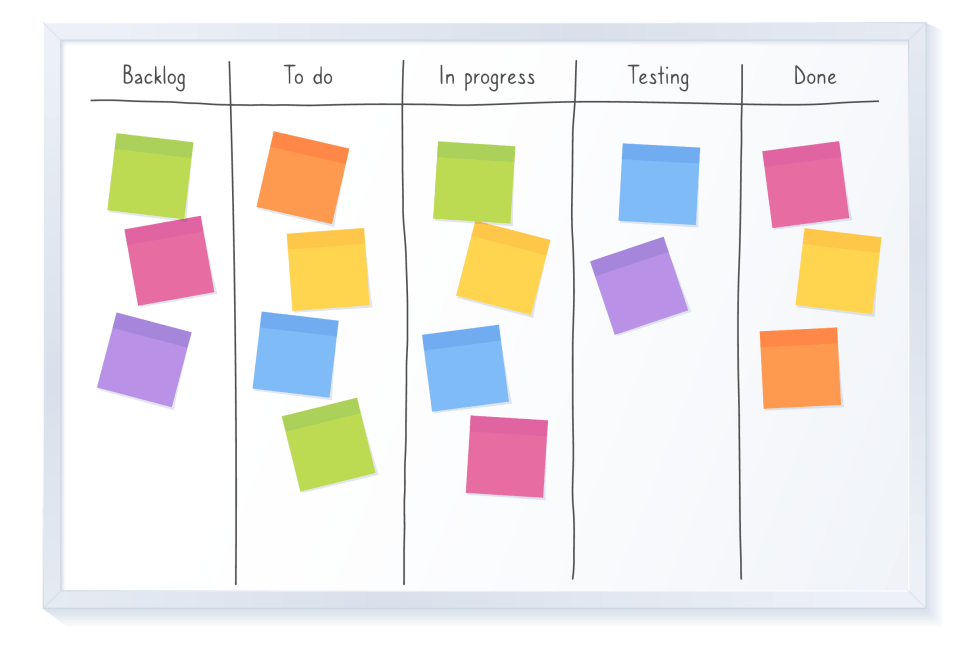
- The waterfall method: this is commonly associated with the Project Management Institute . In this work breakdown structure method, you take the deliverables and then divide them into a sequential and linear array of tasks. Proper planning is critical. Requirements must be clear, and team members should understand what roles and responsibilities.
- Gantt charts : this is a commonly used and useful tool. It helps you to visualize the timelines and dependencies of a project. It is in the form of bars, so it’s easy to take in at a glance.
Now that you’re clear about the nature of tasks and how to understand the relationships between them, we’ll leave you with a bonus tip. And that is: sometimes, it helps to work backward.
This simply means taking the end goal and then working through the steps needed in reverse order. This can be of great help in drawing up realistic plans and schedules.
With all of the tasks clearly outlined, you can plan your work and then work your plan.
For enquiries call:
+1-469-442-0620

- Project Management
What is a Task in Project Management? An Ultimate Guide
Home Blog Project Management What is a Task in Project Management? An Ultimate Guide
It is an activity that we do every day to complete a specific kind of work. It could be an activity that you are required to complete in your school/college; it is a task that Apollo asked Hercules to perform according to Greek mythology. However, a task in project management is different than the usual tasks. Project managers handle hundreds of tasks which helps them stay proactive and organized and take their respective projects to the pinnacle of success. You must also note that project task management is different from project management.
Task management is about the right person doing the right thing at the right time. Tasks can be core tasks or subtasks, simple or complex, big or small, and team or individual tasks. So, let us delve in and understand what a task in project management is and how to create an agenda to complete it effectively.
What is a Project Task?
A task in project management is its building block, something that needs to be processed in order so that the overall project is completed. Each project is bifurcated into several deliverables, and each deliverable can be achieved by following certain tasks.
If you are looking for a definition, then project tasks are a series of actions that are required to successfully complete a project. Project tasks comprise individual activities like creating content, reducing costs, maintaining quality, etc. which can be further categorized into sub-tasks which are small yet manageable actions.
You can also create a task in project management list which is more like a checklist, which is created at the beginning of the project, and specifies each task clearly. Just by checking off each activity as it is completed, project managers can keep productivity as effective as possible. There are several online Project Management courses that revolve around understanding project tasks.
What is the Purpose of Tasks in Project Management?
Imagine you are the project manager, who is responsible for carrying out a project like social media marketing , which has no structure or outline. Looking for ways to start, process, and culminate the project could be burdensome or stressful. Thus, there are various types of tasks in project management that serve the purpose of dividing work and categorizing it according to expertise, experience, and knowledge. The core purposes of establishing project management tasks and activities are:
- Task identification in project management helps to differentiate various components of a project.
- Helps to identify the work that is required to be completed by a deadline.
- Implements a best-practice workflow.
- Creates a series of interactive steps.
- Uses a project task tracker to track progress on a day-to-day basis.
How to Break Down a Project into Tasks?
Breaking down a project into tasks has no specific formula to follow, but it can be done by someone who has the skill, experience, education, and expertise as a project manager. PMP training can help you with the relevant information about breaking down a project into tasks. You can follow these tips that will help you categorize your project deliverables into tasks:
- Go visual, create a process flow chart, mapping, and other graphics, and have a brainstorming session with your team where you can understand how each one can contribute to specific tasks.
- Bifurcate a project into tasks based on the timeline or deadline assigned for completion
- Understand the relevance of each task by conducting a thorough risk assessment and planning back-ups
- Align tasks according to project milestones
- Ensure that all tasks are comprehensive, transparent, and well-defined so that every person understands his job well
What are Tasks in Different Project Management Stages?
Let us look at different kinds of task management methods in different stages of project management:
1. Project Initiation Tasks
Some of the setup tasks include getting necessary approvals from stakeholders and validating the project outline. Every project should have a scope, budget, and timeline, and your tasks will revolve around supporting objectives. This includes:
- Setting up your project management tool and file folders.
- Creating an updated project brief and getting it approved.
- Securing the team and communicating with them.
- Define a timeline and budget for the project outline.
- And finally, officially giving a starting point to the project.
2. Ongoing Project Management Tasks
Once your project is on the go, you would need to create and assign tasks to align the execution of the project. It is important to create a balance between daily tasks, periodic tasks, and long-term tasks. This stage is all about proactive, predictive, and protective, rather than reactive, especially in case of obstacles
3. Daily Project Management Tasks
As the name suggests, these are tasks that need to be managed every day. Some project management tasks examples are:
- Monitoring your team and communicating with them.
- Checking In with The Project Team.
- Maintaining transparency and accountability.
- Holding meetings with team members.
- Checking on various tools related to a task in project management.
- Monitoring progress which can include reviewing the Gantt chart or sprint illustrations to see if you are going the right path.
- Communicating with the stakeholders/consumers and updating them about the progress.
- Creating task briefs in a Kanban-style workflow and addressing issues.
- Documenting decisions and sharing them with the teams.
4. Weekly Project Management Tasks
These are tasks that are required to be completed every week. These include:
- Automating workflows and creating reports and documentation.
- Assessing budget and timeline progress.
- Re-planning if required.
- Analyzing and approving timesheets from the previous week.
- Using the task in project management software to check for areas of error or inefficiency and taking corrective measures accordingly.
- Planning resources for the following weeks.
5. Long-term Project Management Tasks
Long-term tasks include:
- Communicating with stakeholders, consumers, security teams, compliance teams, and regulatory bodies.
- Ensuring compliance through collaborative conversations with the project team.
- Organizing the financial administration, which includes budgeting and invoicing.
6. Project Closure Tasks
When it comes to closing a project, you must look into tasks like creating reports on how well your project performed. It is required to create a final reconciliation of the timeline and budget. This is also the stage when you must get relevant feedback and learn lessons to leverage insights. Finally, it is critical to celebrate with your team, as completing a project successfully is pure hard work!
Tips to Manage Your Project Management Tasks
The list can be long; however, for now, you must focus on these key tips to manage your project management tasks:
- Organize your day based on desired outcomes.
- Set the right expectations with your team so they know when you’re most available to support.
- Prioritize based on necessity and compliance.
- Invest time in learning.
- Try proven productivity hacks.
Common Task Management Tools
Task in project management software or tools help project management teams to manage, prioritize, and complete their tasks. Get your Prince2 Foundation and Practitioner course online to be adept at using such tools. These tools can revolve around
- Task scheduling, customization, and assignment.
- Some tools remind teams about upcoming task list in project management and deadlines.
- Tools help standardize task dependencies in project management, and repetitive steps help with sub-tasks, track time, report progress, and create to-do lists for easy task visualization.
Some of the examples of common task management in project management tools are
- Using a simple linear progression which signifies the end of a task and the start of a new one.
- Using a Kanban board, which is an agile project management tool to visualize overall work.
- Using the waterfall method, which divides the project into a sequential array of tasks.
- Using Gantt charts to visualize the timelines and dependencies of a project.
Some of the common task management tools are Asana, Trello, Microsoft Planner, Todoist, Smartsheet, ClickUp among many others.
Task Management vs Project Management
Both task management and project management are different terms. Let us look at the key differences:
Conclusion
So; this was all about what tasks are! By now, you must understand how successfully completing each task is imperative to meet the final project objective. Projects are divided into various tasks, and a checklist is prepared based on daily/weekly/long-term activities, which helps you assess the completed range and verify what’s left to achieve.
As a project manager, you should have the expertise and knowledge to balance tasks besides aiming to meet deliverables. It is highly recommended to get KnowledgeHut best Project Management certification online to gain expertise and knowledge about the concept. The key is constant communication, stringent monitoring, meeting timelines, and running a risk check. To process all big and small tasks related to a project, it is substantial that you follow industry trends, conduct thorough research, and study what your competitors are and aren’t doing.
Frequently Asked Questions (FAQs)
An example of a task could be to create a budget for the project. Or if the project revolves around social media marketing, then bifurcating it among tasks like advertising, content writing, video-making, etc., are all tasks associated with the project.
A task is a single unit of work completed for the successful culmination of a project. The project comprises a series of tasks that eventually help to meet the final goal.
Different phases of a task are task initiation, task planning, task execution (based on daily/weekly/long-term tasks), and task closing.

Kevin D.Davis
Kevin D. Davis is a seasoned and results-driven Program/Project Management Professional with a Master's Certificate in Advanced Project Management. With expertise in leading multi-million dollar projects, strategic planning, and sales operations, Kevin excels in maximizing solutions and building business cases. He possesses a deep understanding of methodologies such as PMBOK, Lean Six Sigma, and TQM to achieve business/technology alignment. With over 100 instructional training sessions and extensive experience as a PMP Exam Prep Instructor at KnowledgeHut, Kevin has a proven track record in project management training and consulting. His expertise has helped in driving successful project outcomes and fostering organizational growth.
Avail your free 1:1 mentorship session.
Something went wrong
Upcoming Project Management Batches & Dates
.css-s5s6ko{margin-right:42px;color:#F5F4F3;}@media (max-width: 1120px){.css-s5s6ko{margin-right:12px;}} Join us: Learn how to build a trusted AI strategy to support your company's intelligent transformation, featuring Forrester .css-1ixh9fn{display:inline-block;}@media (max-width: 480px){.css-1ixh9fn{display:block;margin-top:12px;}} .css-1uaoevr-heading-6{font-size:14px;line-height:24px;font-weight:500;-webkit-text-decoration:underline;text-decoration:underline;color:#F5F4F3;}.css-1uaoevr-heading-6:hover{color:#F5F4F3;} .css-ora5nu-heading-6{display:-webkit-box;display:-webkit-flex;display:-ms-flexbox;display:flex;-webkit-align-items:center;-webkit-box-align:center;-ms-flex-align:center;align-items:center;-webkit-box-pack:start;-ms-flex-pack:start;-webkit-justify-content:flex-start;justify-content:flex-start;color:#0D0E10;-webkit-transition:all 0.3s;transition:all 0.3s;position:relative;font-size:16px;line-height:28px;padding:0;font-size:14px;line-height:24px;font-weight:500;-webkit-text-decoration:underline;text-decoration:underline;color:#F5F4F3;}.css-ora5nu-heading-6:hover{border-bottom:0;color:#CD4848;}.css-ora5nu-heading-6:hover path{fill:#CD4848;}.css-ora5nu-heading-6:hover div{border-color:#CD4848;}.css-ora5nu-heading-6:hover div:before{border-left-color:#CD4848;}.css-ora5nu-heading-6:active{border-bottom:0;background-color:#EBE8E8;color:#0D0E10;}.css-ora5nu-heading-6:active path{fill:#0D0E10;}.css-ora5nu-heading-6:active div{border-color:#0D0E10;}.css-ora5nu-heading-6:active div:before{border-left-color:#0D0E10;}.css-ora5nu-heading-6:hover{color:#F5F4F3;} Register now .css-1k6cidy{width:11px;height:11px;margin-left:8px;}.css-1k6cidy path{fill:currentColor;}
- Project management |
- Project tracking 101: A guide to tracki ...
Project tracking 101: A guide to tracking projects effectively

When team members struggle to understand their individual responsibilities and deadlines, it can lead to confusion and delays. And without a clear view of a team’s project progress, it's difficult for managers to identify which tasks are lagging behind or need immediate attention. Project tracking addresses these issues by providing a transparent and real-time overview of all tasks, responsibilities, and due dates, ensuring everyone is aligned and on schedule.
But you don’t need to do it all on your own. Project tracking tools like Asana give you—and more importantly, your team—a clear sense of the status of a project and an easy way to get real-time updates, you can spend more time on high-impact work. Here’s how to get started with project tracking so everyone on your team knows exactly who’s doing what by when.
What is project tracking?
Project tracking is a set of tools and practices to help project managers monitor the progress of their initiatives. Instead of trying to keep track of your work via spreadsheets, email, or just mentally, project tracking tools help you effortlessly keep track of the ins and outs of project data. With project tracking, you can help team members stay up to date on the status of a project at the individual, project, and program level.
What are project tracking tools?
Project tracking comes to life through project tracking tools—like real-time dashboards or status updates. You don’t need to spend 45 minutes every Friday clicking in and out of projects to get a sense of where a project is at. Instead, these tools are designed to help you and your team stay in the loop on individual tasks and team projects, as well as across multiple projects.
These tools help you:
Share task information in real time
Clarify who’s doing what by when
Create shareable progress reports
Help your team with status, time, and budget tracking
Benefits of project tracking software
Project tracking software is a helpful tool for modern task management. It lets teams monitor all the moving pieces of an initiative, from overall task progression to subtasks and dependencies. In addition, reporting functionality helps teams measure progress and establish a clear baseline for project success.
By using project tracking tools, teams can maintain alignment with their key performance indicators (KPIs) and make sure that each activity is making a significant contribution to the project's objectives.
Identify bottlenecks and track project progress
Project management software offers a comprehensive view of project performance and scope , enabling teams to pinpoint areas needing improvement or adjustment. By addressing potential bottlenecks before they escalate, this proactive approach keeps current and future projects on track.
Example: A commercial construction firm uses project tracking software to oversee project budget and performance. The team notices a trend towards exceeding the allocated budget due to procurement delays. With this insight, they quickly implement a task management strategy focused on streamlining procurement and reducing costs, effectively managing the project scope and maintaining the project's baseline for success.
Team collaboration
The success of agile project management hinges on effective project tracking. It enhances teamwork by establishing clear due dates and end dates, and ensures that everyone is aligned. This synchronization is vital for project success, because it enables team members to work seamlessly together, adapting to changes and challenges as they arise.
Example: A software development team is tackling a new project to create a complex application. They use project tracking software to set clear goals and standards for task completion and team collaboration. When they encounter a critical issue that might delay the project, the software's flexible and responsive approach, along with timely alerts, enables the team to quickly adjust their strategy, redistribute smaller tasks, and work together efficiently to address the challenge.
Simplified project reporting
The best project tracking streamlines the reporting process, making it simpler and more efficient. Automation features reduce manual effort by sending notifications and updates to keep everyone informed. By providing comprehensive project reports, task lists, and updates on new projects, project tracking software ensures that all stakeholders are up-to-date and engaged in the project's progress. This leads to successful project outcomes and a more streamlined workflow.
Example: A marketing agency needed to run a large campaign with an aggressive deadline. They used project tracking software to streamline task lists and provide real-time project reports. The automation of these reports and the use of notifications helped the team stay on top of project tasks and performance metrics. This not only improved their task management process but also enabled them to provide clients with up-to-date information on the campaign's progress.
Connecting work and reducing silos
Though we refer to these tools as project tracking tools, they’re usually part of a holistic work management software . That’s because project tracking tools are only effective when they’re connected to the work your team is doing.
Too often, we split work between tools—like working in documents, communicating over email, and tracking work in a spreadsheet. Sound familiar? You’re not alone. According to the Anatomy of Work Index , knowledge workers switch between 10 tools up to 25 times per day. But app overload reduces efficiency and increases the risk that work will fall through the cracks.
With a siloed system, team members might struggle to find information. To find the most up-to-date document, you have to email a team member or scroll back through your chat messages. If you are trying to track project data in a spreadsheet-style system, that information needs to be manually entered from other tools and information sources.
By managing projects and tasks in a work management tool with project tracking features to stay up to date, your team can get real-time insight—while also reducing duplicative work.
![project management and task [Product UI] Universal reporting interactive dashboards in Asana (Search & Reporting)](https://assets.asana.biz/transform/4a845a7b-5c6d-4e87-9968-4f67d30e46da/TG23-web-hero-039-optimization-project-goals2-static-2x?io=transform:fill,width:2560&format=webp)
Instead of having to track down information, manually copy and paste work, or source data from multiple spreadsheets, you have access to all of the information you need—in one place. The last thing you want to do is give yourself more manual work by copying the information you want to track into a separate tool.
3 key project tracking strategies
As mentioned above, project tracking is part of a larger set of work management software. When team members refer to project tracking, they’re really talking about three things: tracking work at the individual level, staying up-to-date on project work, or checking work progress across multiple projects.
1. Tracking work at the individual level
At the individual task level, project tracking tools can help everyone align on who’s doing what by when. This can give team members clear insight into whether a task is proceeding on schedule and how your project is progressing towards its deliverables.
Tracking work at the individual task level has another value—it prevents duplicative work. When everyone has clarity on who’s doing what by when, you take the guesswork and work about work out of working. This is critical—as it stands, knowledge workers spend 13% of their time on work that’s already been completed.
Why you should only assign one responsible individual per initiative
The most important thing to do while tracking work at the individual level is to ensure there’s only one person directly responsible for each task. Having one individual responsible for each initiative means team members know who to contact about providing updates on task status or answering questions other team members might have.
For example, imagine you and another team member are hosting a virtual event. But because there are two hosts, your guest speakers aren’t sure who to go to with questions. The day before the event, a guest speaker has an emergency, and they contact one team member to cancel. But because of a miscommunication, you didn’t get looped in—and on the day of the event, you’re totally unprepared when that speaker doesn’t show up. With one, clearly responsible point of communication, that type of problem can be easily avoided.
2. Tracking work at the project level
You can also track work at the project level to give cross-functional stakeholders a higher-level view of the project work. Instead of being notified about the day-to-day updates, cross-functional stakeholders and other team members need at-a-glance, real-time updates about the most important project data. That way, they can stay up to date during the lifecycle of a project without being bogged down with the details.
There are two main ways to track work at the project level:
Status updates: Project status reports are updates on the progress of your project that help you keep stakeholders informed. Written status updates also replace status meetings and instead offer a way for team members to view the most up-to-date project information on their own time. For best results, share your status reports in the same tool where you manage the execution of work, so stakeholders can drill down into more detail if necessary.
Dashboards: Dashboards are project progress views that stakeholders can access at any time to get details about a project. Dashboards can include things like burndown charts , work in flight, or tasks that are overdue. Like status updates, make sure you’re creating dashboards in the tool where you’re also doing work so your stakeholders can get more information.
3. Tracking work across multiple projects
If you’re tracking work across multiple projects, you’ll likely benefit from tracking work at the portfolio level. Project portfolio management (PPM) is the bird’s-eye view that your executive stakeholders or project sponsors want to see. PPM helps stakeholders see the big picture across multiple projects and how those initiatives are tracking against business goals.
At the portfolio level, it’s critical for stakeholders to have clear insight into each project’s status, so they can gauge overall portfolio health and performance.
At this level, you can also use workload management to track team bandwidth and capacity. Workload management provides a way for you to see what each team member is working on—across projects—so you can ensure no one is feeling burnt out or overwhelmed.
According to our research , 71% of knowledge workers experienced burnout at least once in 2020. With workload management and project tracking, you can proactively ensure there are no capacity issues coming up by viewing all tasks on the docket in the coming days or weeks. That way, if a team member has a few big tasks coming up, you can reprioritize smaller requests to other team members who might have a higher capacity.
How to track progress effectively
These three project tracking strategies can help you get started with project tracking at the individual, project, and portfolio level. Project tracking is part of the larger work management platform, so there are a host of other related tools that you can and should take advantage of at various stages of your project.
Share details early on in a project plan
A project plan is a blueprint of key elements your project needs to succeed. Project planning happens before the project tracking stage—usually, this is the very first thing you do when you’re starting a project.
By creating a plan, you can give team members and stakeholders a sense of your project timeline. That way, everyone starts off on the same page. Then, maintain that clarity throughout the project with project tracking tools.
Establish a communication plan for each project
A communication plan is an outline of how you and your project team will be communicating over the course of a project. This plan can help you clarify exactly where and when your team can find information. For example, a communication plan will often define the various communication channels you should use—like email, messages, or in-person meetings. You can also use this plan to explain how often you’ll use each channel, or who should be included in different channel communications.
A communication plan can give your team a clear sense of where and when they should be communicating. Typically, your plan should also include information about when you’ll be communicating project tracking details—like status updates.
Use visual project management to bring your project to life
Once you’re actually working on your project, you can use visual project management tools to track your work more effectively. There are three types of visual project management:
Gantt charts , which offer a timeline-style view of your project and make it easy to visualize any work dependencies. Gantt charts often show key project milestones , too.
Kanban boards , which are an effective way to track task status. In a Kanban board, work moves through stages, which are represented by columns. For example, you might have To do , Doing , and Done columns in a Kanban board.
Calendars , which give your team a clear sense of when project deliverables are due.
Create a project roadmap to get a high-level overview
For complex projects, you can also create a project roadmap to give team members a way to easily visualize the overall project schedule. A project roadmap is a high-level project timeline, so stakeholders can get an overview of your project deliverables, key milestones, and overall project goals.
Capture capacity with time tracking tools
At the individual task level, it’s helpful to track additional project details, like how long a task will take to complete. Project tracking tools often offer time tracking integrations, to help you accurately track time spent on projects and tasks with less effort.
Maintain course with a resource management plan
In project management, a resource is anything that helps you complete a project—including team members, budget, or available tools. A resource management plan can help you clearly define your project resources and their capacity, so everyone understands what resources are available for project work.
Stay on track with project tracking
Good project tracking—like all the best workflows—can make it easier for your team to collaborate and communicate. Instead of manually inputting project tracking details into spreadsheets or slide decks, online project tracking tools break down silos to help you track work where you actually work. Share all of your important project information—like details, documents, feedback, and messages—in one place. Project tracking makes it easy for team members, stakeholders, and cross-functional collaborators to see and track work from every angle.
Interested in getting started? Learn how Asana can help your team organize work and stay in sync by tracking all of your project information in one place.
Related resources

Critical path method: How to use CPM for project management
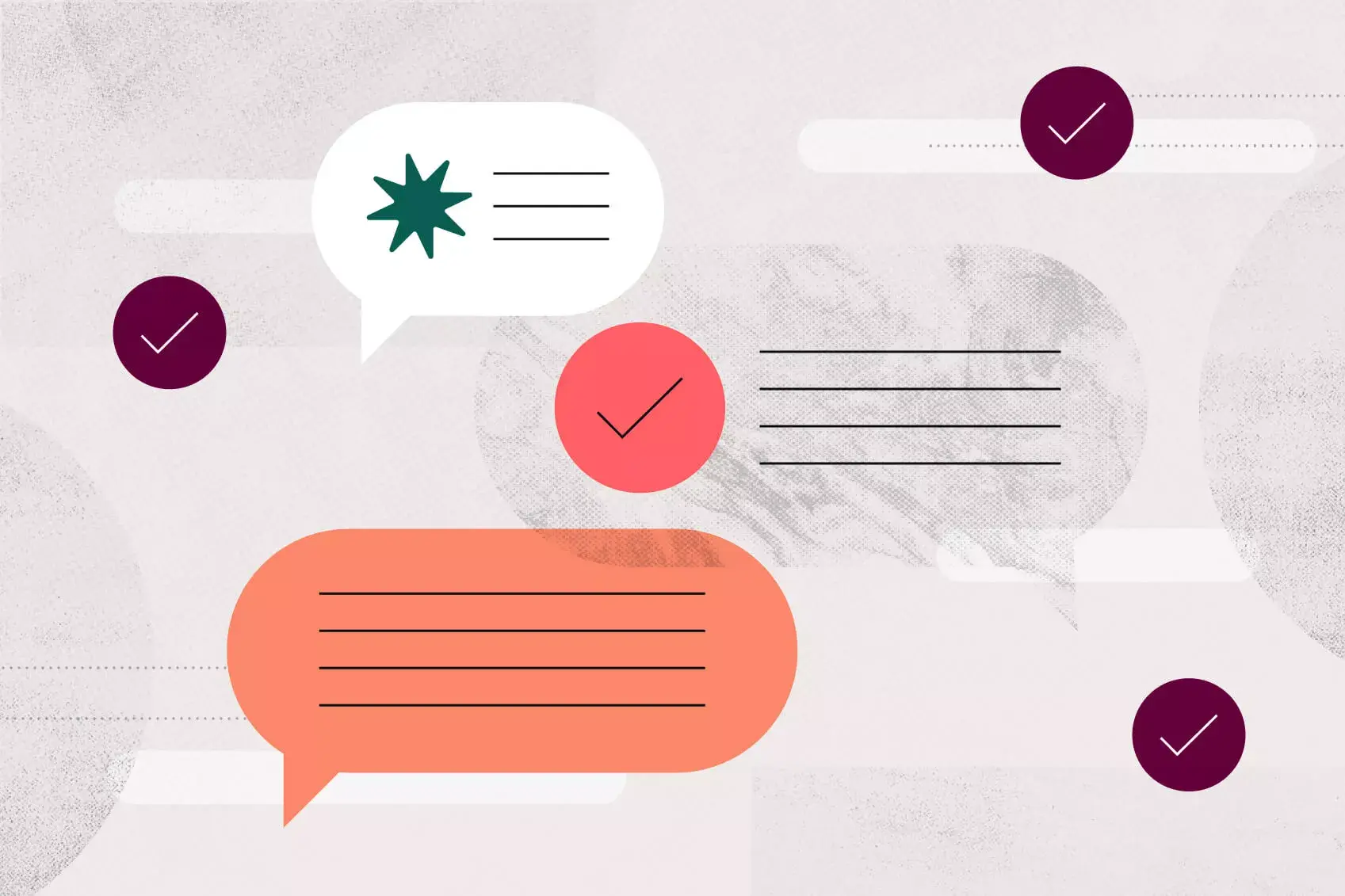
15 project management interview questions, answers, and tips

Unmanaged business goals don’t work. Here’s what does.

How Asana uses work management to drive product development
Everything that you need to know to start your own business. From business ideas to researching the competition.
Practical and real-world advice on how to run your business — from managing employees to keeping the books.
Our best expert advice on how to grow your business — from attracting new customers to keeping existing customers happy and having the capital to do it.
Entrepreneurs and industry leaders share their best advice on how to take your company to the next level.
- Business Ideas
- Human Resources
- Business Financing
- Growth Studio
- Ask the Board
Looking for your local chamber?
Interested in partnering with us?
Run » technology, the future of project management software for small business.
Explore emerging trends and product updates that help teams better manage resources and tasks while improving collaboration.

Whether rolling out new products or opening a second location, leaders need top-level and granular views of resources and risks. Project management platforms bring teams together and provide actionable insights. The latest innovations in project management software leverage artificial intelligence (AI), machine learning (ML), and automation, increasing system speed and improving small business efficiency.
We reviewed emerging trends and product updates from popular small business project management solutions, including Wrike, Trello, and Monday.com. Discover how new technologies impact your company and ways to use them to reduce project failure rates and cut costs.
Generative AI streamlines project tasks
Generative AI is a time saver, offering content recommendations, editing tips, and more. Indeed, small businesses use ChatGPT to generate metadata and social media posts. However, relying on ChatGPT for everything project-related is inefficient, which is why many project management platforms are rolling out integrated generative AI features.
With AI-assisted content generation tools, your staff can brainstorm new topics, summarize meeting briefs, and edit copy. Project managers use generative AI to change the tone of their content to appeal to stakeholders without a complete rewrite of the update provided to team members.
Here’s how project management tools are incorporating generative AI:
- Trello: Atlassian Intelligence capabilities help Trello users fix grammar, summarize content, and change tone. You can give a prompt to see suggestions or new ideas, or use AI to scan your content and find action items.
- Smartsheet: With Smartsheet , users can add image descriptions in the Brandfolder to ensure searchability with one click. Generative AI tools will translate, write about, and summarize data in your sheet. You can also enter a prompt to generate copy.
- Wrike: Businesses can create item descriptions or comments when drafting plans, writing project briefs, or brainstorming ideas. Wrike’s AI feature supports individual and brand voices. It also fixes spelling mistakes and translates content into different languages.
[ Read more: What's the Difference Between Traditional and Generative AI? ]
Technology enables faster views even with complex datasets
Powerful search functions and advanced technologies allow project management teams to find and retrieve information quickly. Whether switching between views, computing formulas, or searching for project updates, project management tools help small businesses do more in less time.
ClickUp recently debuted its universal search feature. It lets teams find files across all connected applications, from Dropbox to GitHub. Coming soon, users will have 10 times faster views, thanks to ClickUp’s RapidViews DB proprietary technology.
As of November, Smartsheet formulas run 10 times quicker than before. And Trello’s advanced search page added new filters. Users can now scan card descriptions and only see results for cards updated in the last 24 hours.
Project management solutions optimize collaboration features
Small business trends like the shift towards hybrid and remote teams affect project management. Yet, according to Wellingtone , a quarter of businesses don’t have the “right technology to enable team collaboration on informal projects, even though this makes up 20% of work time.” The future of project management software includes improvements to in-app communication and collaboration tools.
Look for product updates that give individuals a unified view of all communications, smart ways to share project statuses, and simplified interaction solutions. For instance, Nifty refactored team chat, improving performance and speed by over five times compared to the previous version. It also developed a central inbox. Users can see tasks, messages, and comments from all projects in one place.
ClickUp’s latest upgrade lets staff mention a co-worker in a comment right from their inbox, allowing them to share a private task or information without switching screens. Managers can use Asana’s AI-powered smart status feature to pull real-time data when generating status updates.
Employees can actually focus more on value-adding tasks and use the time to focus on strategic or more complex topics rather than dealing with repetitive, non-rewarding tasks.
Hari Doraisamy, Senior Director of Mission-Critical Support at SAP
Intelligent technologies let staff personalize their tools
Although projects are team efforts, every individual has a role. Traditionally, project management software offered different views for managers and employees but lacked options for users to customize their personal spaces. Today, vendors realize the importance of giving workers dynamic tools to manage their inboxes and tasks.
ClickUp provides a Personal List for users, allowing them to track items in a manner that suits them best. Smartsheet's forthcoming AI-based solution uses natural language processing (NLP) so leaders can quickly generate project or individual templates.
[ Read more: Small Businesses Tasks for AI ]
Automation plays a central role in small business project management
Automation technologies involving machine learning and generative AI are among small businesses' most valuable tools. For example, Asana’s smart workflows adjust over time to correspond to your company’s goals and best practices.
Stephen Xu, Head of the Project Management Office, Infrastructure Service BU, Alibaba Group, told Project Management Institute (PMI), “AI can offload project managers from hosting meetings, writing emails or recording the meeting minutes, etc . It means more time to do strategic thinking and high-level planning.”
Automation also improves worker experiences. According to PMI, Hari Doraisamy, Senior Director of Mission-Critical Support at SAP, said, “Employees can actually focus more on value-adding tasks and use the time to focus on strategic or more complex topics rather than dealing with repetitive, non-rewarding tasks.”
Project management software will provide advanced analytics
Business intelligence and analytics give small companies a competitive edge. A data-driven approach in project management lets leaders improve project outcomes and identify trends while reducing risks. Yet, Wellingtone found that 54% of project management professionals lack access to real-time key performance indicators (KPIs).
AI can develop insights from extensive datasets much quicker than manual computations. Consequently, 47% of project managers reported to PMI that “the activity most impacted by AI was analyzing data.” Predictive tools and real-time performance metrics enable small businesses to monitor projects and resources without manual intervention.
New and upcoming data analytics features include:
- Smartsheet: AI-powered data skill tools can analyze all information in a sheet. Managers type requests into the analyze data panel, and Smartsheet creates a live chart. You can add the chart to your dashboard and it will automatically update as data changes.
- Wrike: Any Wrike user can build customizable dashboards with next-gen Wrike Analytics. It has dozens of shortcuts and offers views of different projects and departments.
AI-enabled solutions enhance resource allocation and planning
Poor resource management is the third-largest project management challenge for organizations, according to Wellingtone. Moreover, only 29% of companies report mostly or always completing projects on time. Embracing project management software with AI-powered features helps small businesses realize higher return on investment (ROI) and meet project deadlines.
PMI found that AI innovators “delivered 61% of their projects on time” and “64% of their projects met or exceeded their original ROI estimates.” Meanwhile, AI laggards completed 47% within their deadlines and achieved their ROI for 52% of projects.
Look at how project management software solutions are leveraging technology to maximize project resources:
- Smartsheet’s early adopter program will offer a Workload Heatmap and Workload Schedule. These tools help managers see staffing levels and adjust them as needed.
- With Wrike Datahub, executives track all information from a single spot, including physical assets, digital files, and purchase requests. Leaders can create user attributes like professional skills, locations, and organizational relationships.
- Asana Intelligence features offer innovative planning tools with scenario planning based on resource allocations or timelines and intelligent workloads that consider historical and future capacity.
[ Read more: Smart Tips for Assigning Deadlines and Workloads to Your Employees ]
CO— aims to bring you inspiration from leading respected experts. However, before making any business decision, you should consult a professional who can advise you based on your individual situation.
CO—is committed to helping you start, run and grow your small business. Learn more about the benefits of small business membership in the U.S. Chamber of Commerce, here .

Subscribe to our newsletter, Midnight Oil
Expert business advice, news, and trends, delivered weekly
By signing up you agree to the CO— Privacy Policy. You can opt out anytime.
For more tech tips
The impact of ai on business phone systems, salon software options for beauty shops, the future of medical office software: trends and predictions.
By continuing on our website, you agree to our use of cookies for statistical and personalisation purposes. Know More
Welcome to CO—
Designed for business owners, CO— is a site that connects like minds and delivers actionable insights for next-level growth.
U.S. Chamber of Commerce 1615 H Street, NW Washington, DC 20062
Social links
Looking for local chamber, stay in touch.
- Contact sales
Start free trial
Notion Gantt Chart: Key Features, Pros and Cons

Notion is work management software that helps teams from across industries such as product development, engineering or marketing to facilitate team communication, manage tasks and create simple project timelines.
While Notion has project management features, is there a Notion Gantt chart? We’ll get to that in a moment. Gantt charts are essential project planning and scheduling tools that can manage and track resources and costs.
Does Notion Have a Gantt Chart?
The short answer is no, Notion doesn’t have a Gantt chart . However, you can use Notion’s task list and project timeline to create a Gantt chart. Additionally, Notion has other basic project management features such as project calendars, kanban boards and sprint boards to help you manage your team’s workload.
But even building a Notion Gantt chart isn’t ideal. A Notion Gantt chart doesn’t have the robust features that project managers, teams and stakeholders expect from their Gantt charts. After doing all the work to create a Notion Gantt chart only to find out how limited it is will be frustrating.
If you need a Gantt chart software for managing projects that has all the powerful features you need from a Gantt chart, use ProjectManager instead. ProjectManager’s Gantt charts have planning, scheduling and tracking features that Notion’s Gantt chart doesn’t, including the ability to link all four types of task dependencies. Users can also filter for the critical path and set a baseline to track project variance in real time. On top of that, it offers you other project management tools like timesheets, workload management charts, real-time project dashboards and much more. Get started with ProjectManager today for free.
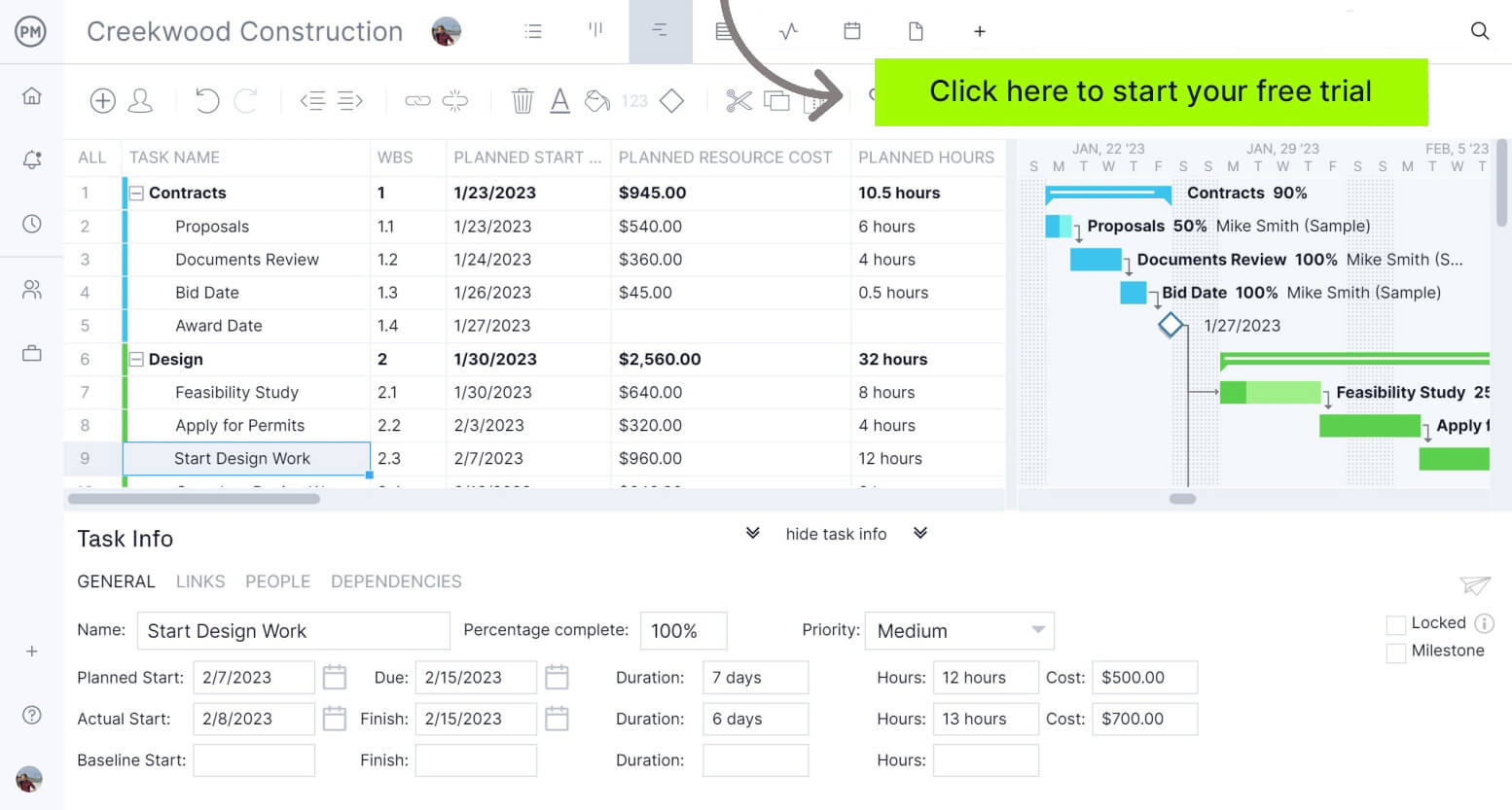
What Can a Notion Gantt Chart Be Used For?
Even though Notion Gantt charts have some drawbacks that make them a limited tool for project management, they can still be used for many purposes, like these examples.
- Making a product roadmap that shows the various stages of product development
- Creating a basic project timeline to estimate the total duration of your projects
- Assigning work to your team members and monitoring their performance
- Planning, scheduling and tracking short-term projects
Let’s review the key features of a Notion Gantt chart to better understand its capabilities and limitations when it comes to managing projects.
Notion Gantt Chart Key Features
A Notion Gantt chart allows you to create a project schedule , assign tasks to your team members and track their progress, which makes it useful for implementing action plans for your organization. Here’s a quick overview of its key features.
- Task dependencies: Notion Gantt charts can only identify finish-to-start task dependencies. Identifying task dependencies is important when creating an accurate and realistic project schedule. However, Notion can’t link start-to-finish, start-to-start or finish-to-finish, which can cause issues when executing projects.
- Percentage of completion: Notion Gantt charts show the percentage of completion for each task in the visual project timeline.
- Task prioritization: You can use a Notion Gantt chart to set a priority level for all project tasks.
Notion Gantt Chart Example
Let’s now take a look at a Notion Gantt chart example. This particular example is a roadmap template that shows the activities across product areas over the upcoming months. To start, let’s look at Notion’s project timeline tool. As you can see in the image below, it shows project task names, their due dates, duration, percentage of completion and arrows to indicate task dependencies.
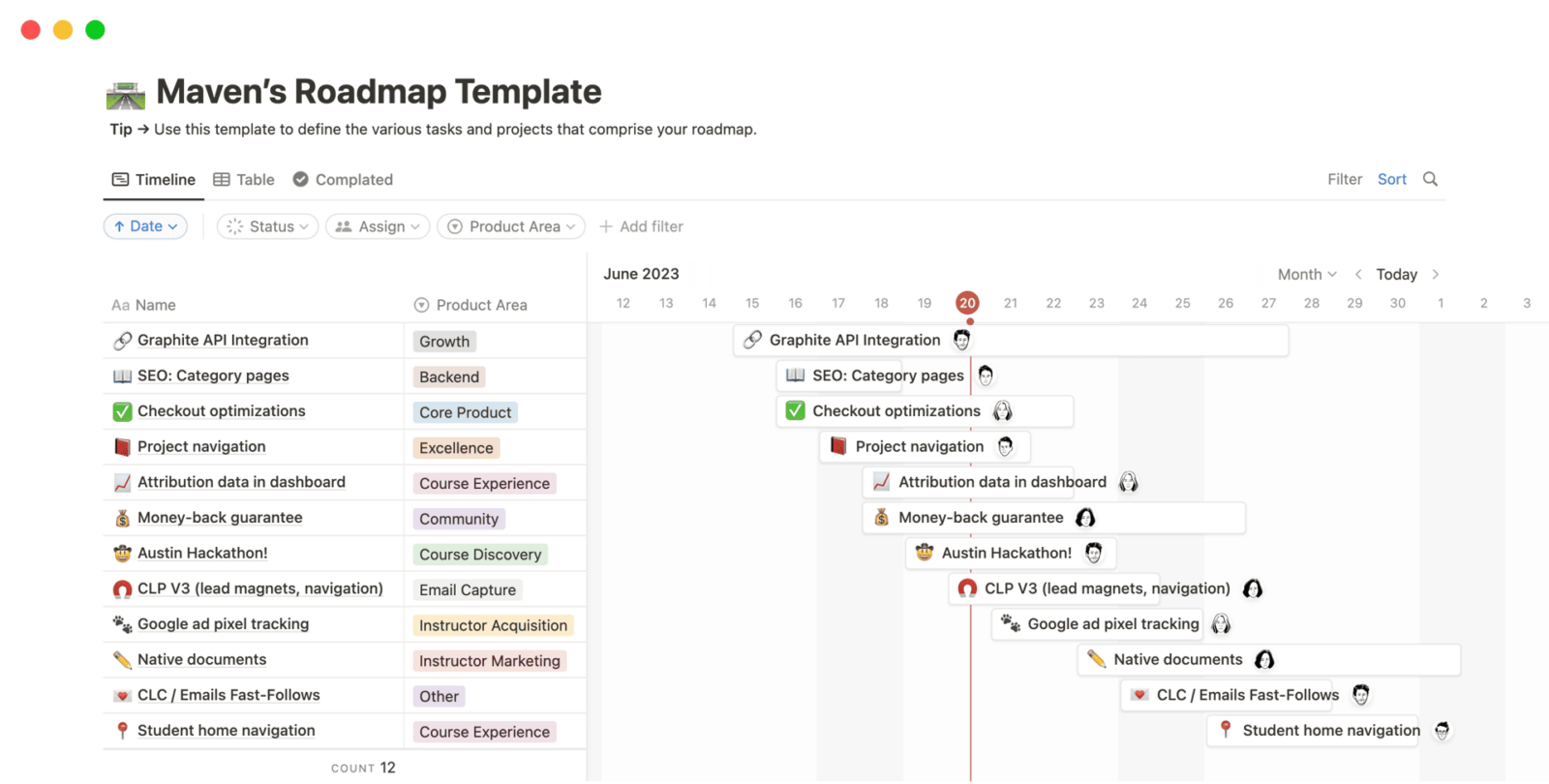
By clicking these project timeline bars, you can see additional information for each task, such as their priority level, status, and subtasks. Now, let’s review the other half of a Notion Gantt chart. By default, Notion’s task lists show your task names, status, assignee, due date and priority, but you can add other columns.
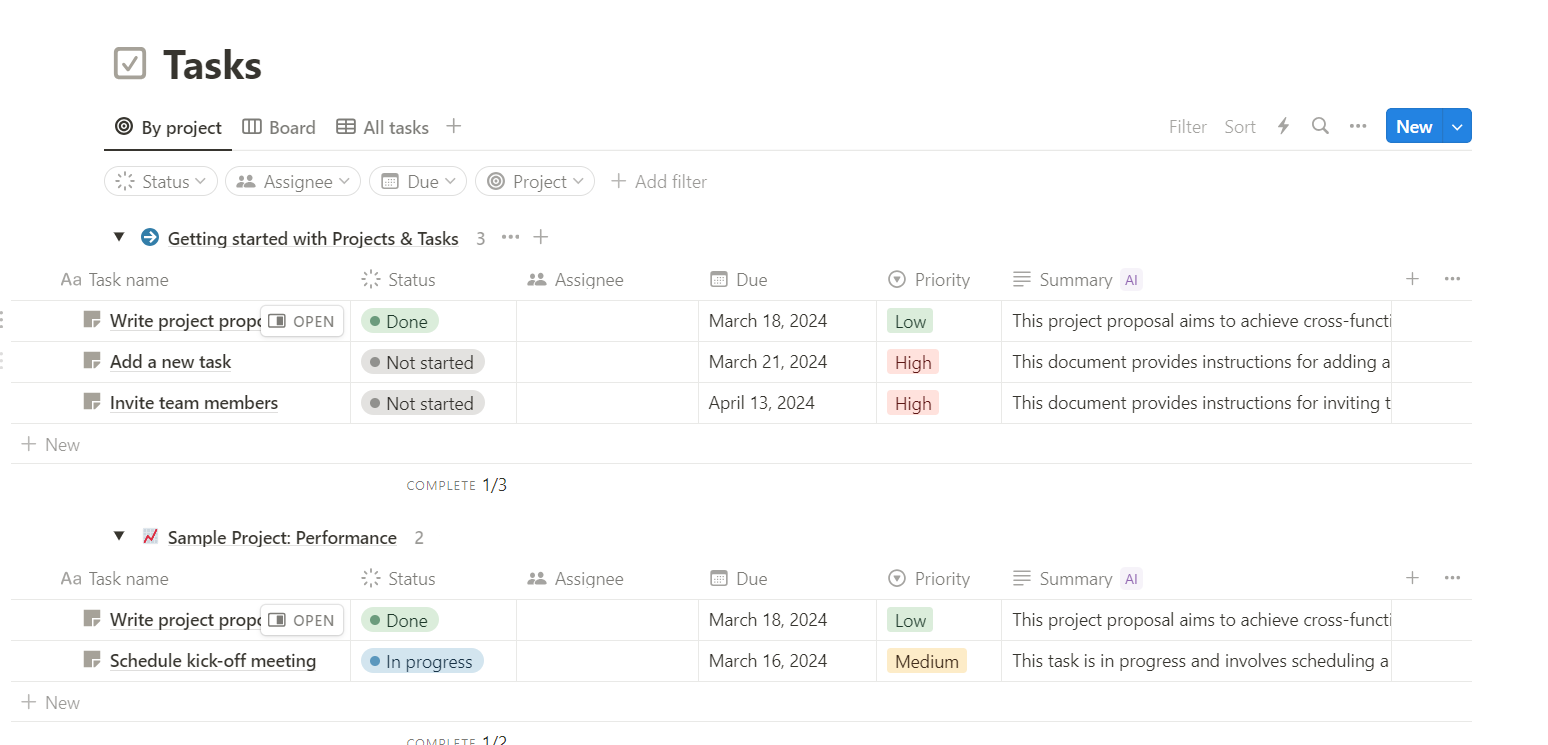
Cons of a Notion Gantt Chart
A Notion Gantt chart can be used for making basic project schedules but lacks the advanced project management features needed for managing all areas of a project . Here are some of them.
- Resource management: A Notion Gantt chart has no resource management features, which is one of the main disadvantages. While tasks can be assigned to team members, a Notion Gantt chart doesn’t allow for the allocation of any other type of resources to project tasks or track resource utilization as the project is executed.
- Cost tracking: Similarly, Notion Gantt charts don’t have any cost management capabilities. This means it only tracks the percentage of completion of tasks but won’t be able to track the costs of resources such as people, materials and equipment.
- Database-dependent Gantt chart: The process of making a Gantt chart in Notion requires the creation of a dataset, which is then automatically turned into a Gantt chart by the tool. While it may facilitate the process, it generates a Gantt chart with limited functionality, which makes Notion feel more like a data visualization tool rather than a project management software.
- Critical path method (CPM): A Notion Gantt chart doesn’t have critical path analysis features which are very important for project scheduling. The critical path of a project is the longest sequence of tasks that need to be delivered on time, or else project completion will be delayed. Having a Gantt chart with CPM features will help you better understand what tasks need to be prioritized to complete your projects on time.
The Best Notion Gantt Chart Alternative
As explained, Notion has project timelines and task lists that can be used to emulate the experience of using a Gantt chart. For example, these tools allow you to assign tasks to your team members or create basic project schedules, but shouldn’t be used for planning or managing the execution of projects due to their lack of advanced project management features such as cost, resource or risk tracking.
ProjectManager offers a best-in-class Gantt chart that allows users to set a baseline, find the critical path and oversee resources in one place. Use it to track all four types of dependencies, set priorities and tag team members to collaborate in real time. No matter where you’re working, it’s easy to share files and documents to keep your project moving. Try it free for 30 days.
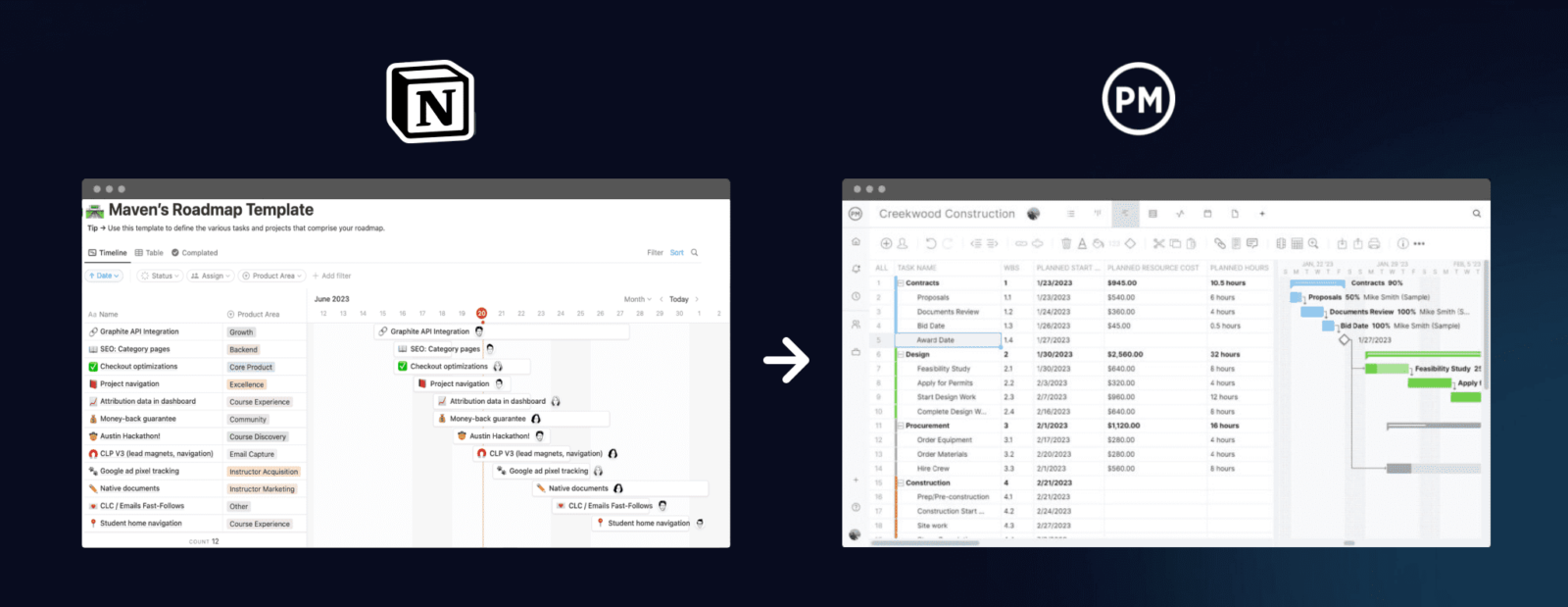
Let’s look into some other reasons why you should use ProjectManager for your Gantt charts instead.
Manage Resources and Monitor Project Costs
ProjectManager’s Gantt chart view allows you to allocate project resources for all your project tasks, estimate their costs and then compare your project cost estimates with the actual resource utilization and costs of your project. Besides this built-in resource management feature, ProjectManager’s Gantt chart automatically syncs with real-time dashboards, timesheets and workload management charts so you can accurately track project costs and monitor how project resources are spent.
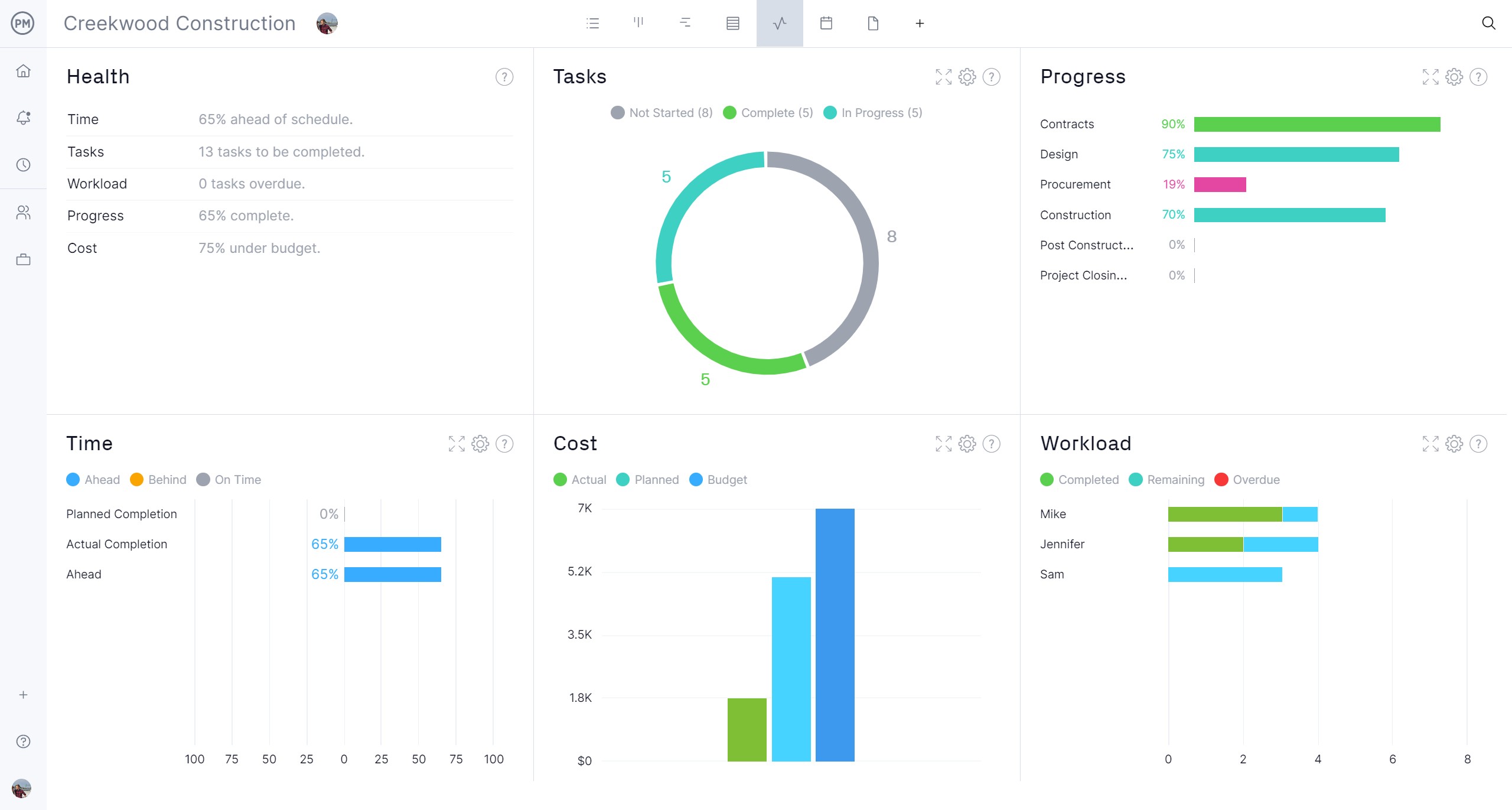
Multiple Project Management Views
Gantt charts are just one of the project management views that ProjectManager offers. You can also manage your projects using kanban boards , project calendars and task lists to schedule projects and manage your team’s workload. These tools can help you view your projects from different perspectives and allow your teams to work with different project management methodologies and styles such as waterfall or agile.
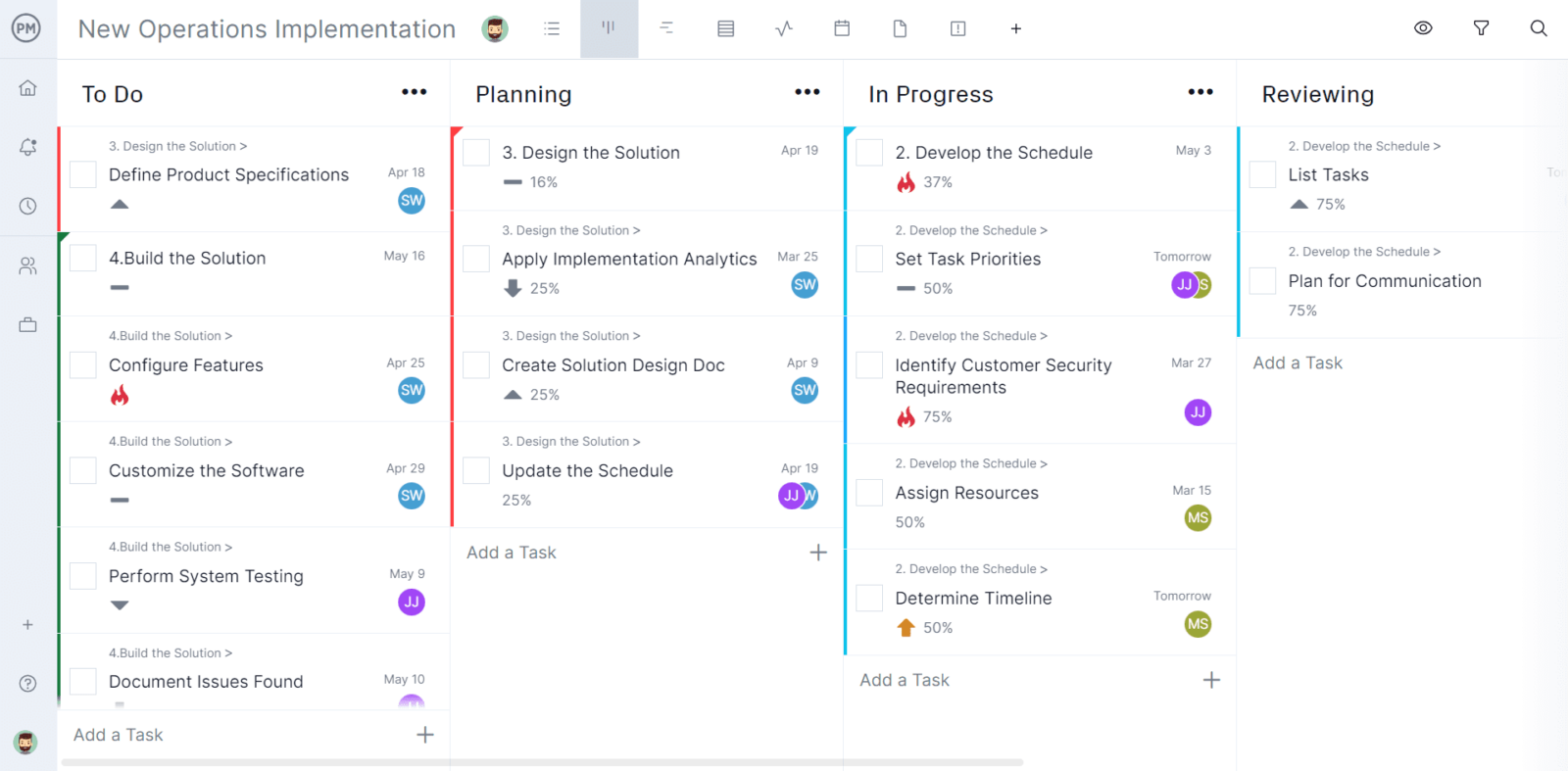
How to Edit a Notion Gantt Chart With ProjectManager
If you’re using Notion, but want a Gantt chart that manages all aspects of a project, then download the data from Notion’s project timelines and task lists as CSV files and import them into ProjectManager. Now you can use all of ProjectManager’s advanced project management features. Simply start a free trial of ProjectManage r and follow these steps.
1. Use the Import Button on the Gantt Chart
Once you’ve downloaded the CSV files for your Notion Gantt chart, log into ProjectManager and go to the Gantt chart view. Then click on the import button, as shown in the image below.
2. Select the CSV File You Want to Import
As soon as you click the import button, a pop-up will appear. Now click “Select File” and import your CSV file.
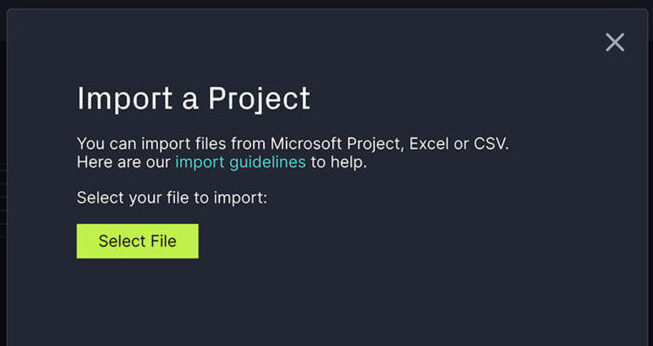
3. Choose the CSV File Import Options
You may import the information from your CSV files into ProjectManager to create a new project or add tasks to an existing project.
4. Select the Data to Populate the Gantt Chart
Select what data to import from the CSV files and display on your Gantt chart. Fortunately, you can visualize all the information from your Notion timelines and task lists using ProjectManager’s Gantt chart and track many other aspects of your project such as resource utilization , costs and the critical path activities of your project.
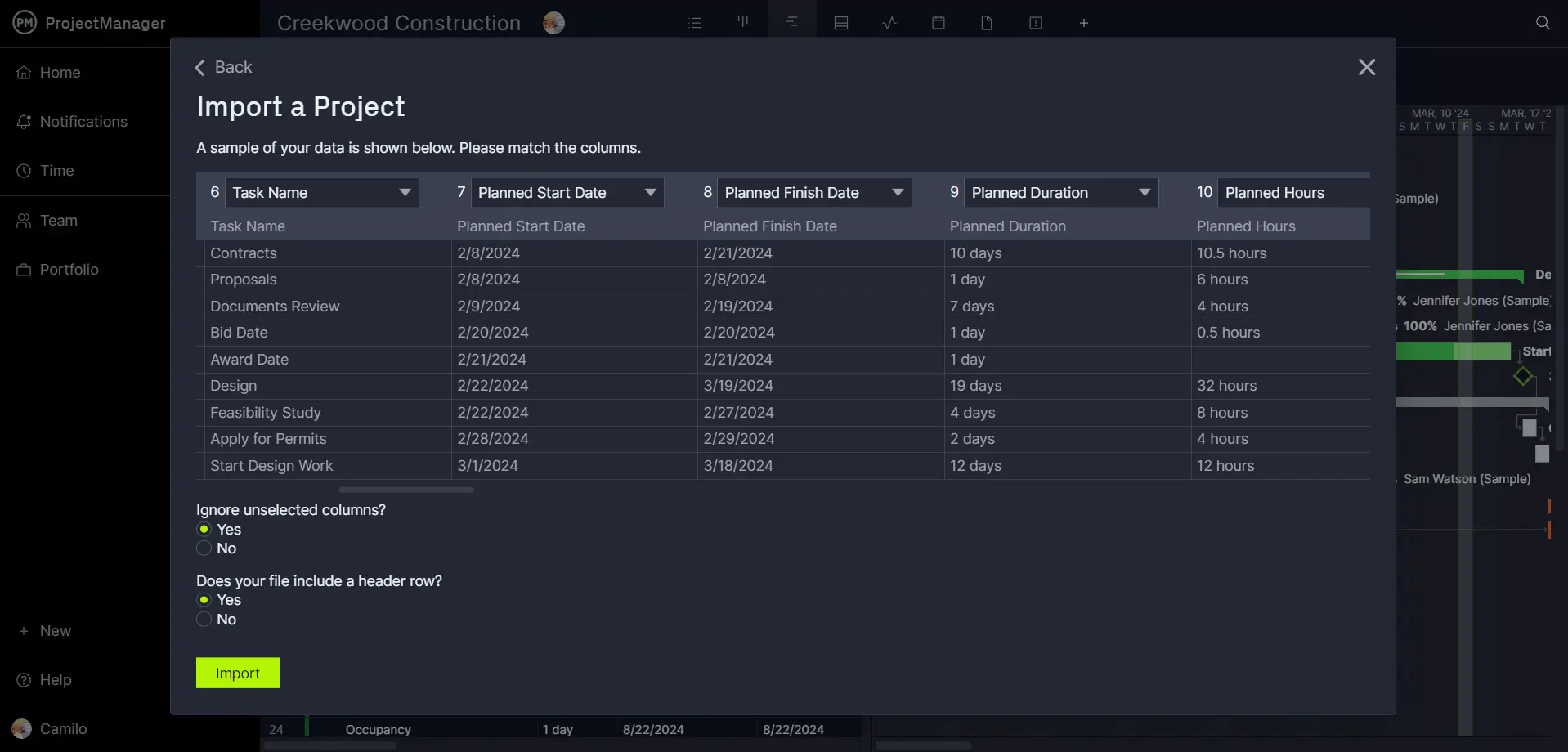
5. Your Notion Gantt Chart Is Ready to Be Edited in ProjectManager
If you see a new window that says “Success,” that means you’ve successfully imported the Notion Gantt chart CSV file you can continue to edit your Gantt chart in ProjectManager .
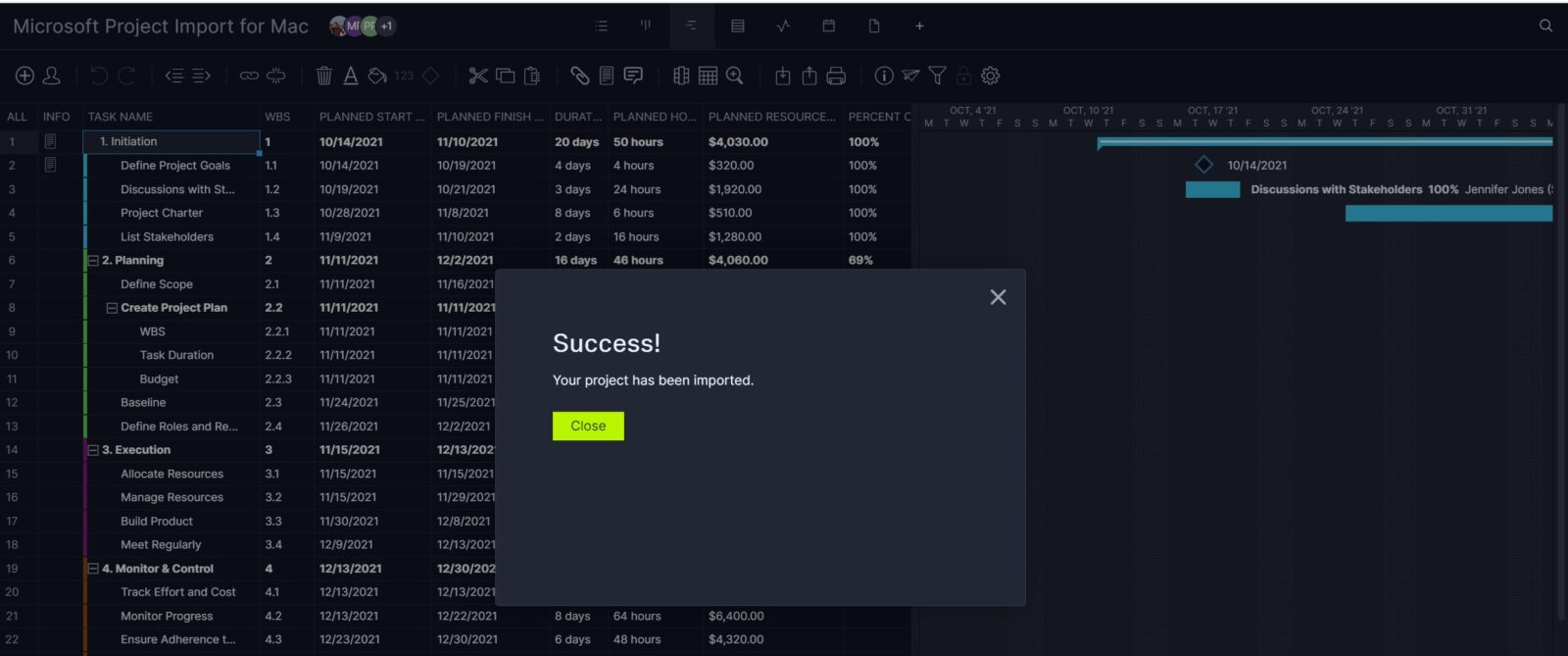
Pros of a Notion Gantt Chart
While a Notion Gantt chart has many limitations for managing projects, there are some benefits to using the software’s timeline feature.
- View projects easily
- Identify the degree of completion
- See the status of the work
- Find out who owns the work
- Link finish-to-start dependencies
However, as we noted, the limitations of the Notion Gantt chart far outweigh the benefits. Notion’s Gantt chart isn’t a true Gantt chart and has minimal capabilities that most project managers won’t find sufficient. If you’re looking for a best-in-class Gantt chart that has all the in-depth features you need to plan and manage your project, try ProjectManager.
Related Gantt Chart Content
We’ve created dozens of blogs, templates and guides to help you make Gantt charts for planning, scheduling and tracking your projects . Here are some Gantt chart-related pages that you might find useful.
- Best Gantt chart Software: Free & Paid Alternatives
- Gantt Chart Template for Excel
- Gantt Chart vs. Kanban Board: Pros, Cons, Similarities & Differences
- Gantt Chart vs. PERT Chart vs. Network Diagram: What Are the Differences?
ProjectManager is online project and portfolio management software that connects teams in the office, out in the field and anywhere in between. They can share files, comment at the task level and stay up to date with email and in-app notifications. Join teams at Avis, Nestle and Siemens who are using our tool to deliver successful projects. Get started with ProjectManager today for free.

Deliver your projects on time and under budget
Start planning your projects.
- Using Procurement
Using Sourcing Negotiations with Project Management Project Plans
A strategic sourcing initiative can contain multiple stages from spend analysis to contract award to contract creation. Many organizations manage these stages as a project with numerous project team members, tasks and deliverables.
Project management is often necessary to coordinate and execute on sourcing initiatives including managing tasks, allocating resources, and reporting on actual savings. Managing sourcing initiatives often requires coordination among various stakeholders, including category managers, project managers, and suppliers.
You can associate a negotiation created in Oracle Sourcing with the project plan created in Oracle Project Management. You can also associate a project task to a specific event in the negotiation life cycle, so when the negotiation event occurs, it automatically completes the project task. When the negotiation event occurs, the project task progress is updated to complete automatically.
You have the flexibility to associate a project task to multiple negotiations and also associate a negotiation to multiple project tasks.You must associate a negotiation at the project task level. Associating a negotiation at the project task level gives you the flexibility to link a single project plan to multiple negotiations or a single negotiation to multiple project plans, but it also associates the progress of a project task to a specific sourcing event that can occur in the negotiation life cycle.
Associate Negotiations with Oracle Fusion Project Management Project Plans
You can create the association between a negotiation and a project plan in two ways. You can create and associate the negotiation while you're defining the project tasks. Otherwise, you can create and associate project tasks when you define your negotiation. You must be a project manager to create a project plan.
Manage Project Task Progress
Project tasks can be associated to negotiation events that occur throughout the life cycle of a negotiation, and you can view a task's status while in Sourcing. You can only see the tasks associated with the negotiation when you view task from the context of the negotiation. When you associate a project task to a negotiation, you can optionally select a Task Completion Event for that association. This enables you to associate a project task's progress to negotiation events that occur in the life cycle of a negotiation. When the event occurs the project task progress is updated to complete automatically. These task completion negotiation events are predefined and they're of 2 types - Manual and Automatic. When a task is tied to an automatic event, the task progress is automatically updated when the negotiation event occurs. When a task is tied to a manual event, then you need to manually perform the complete task action in Sourcing to mark the event as complete.
Note the following points:
You can remove existing tasks tied to task completion events only if the existing tasks aren't completed, which means percent complete isn't 100%. But you can always remove existing project tasks that aren't tied to any task completion events.
If you amend a negotiation, then all the project tasks that aren't yet completed and pointing to the old negotiation automatically point to the new amendment. If a project task is completed, then it's not updated, and it still points to the old negotiation.
Any changes to project plan tasks in an amendment aren't displayed on the Review Changes page.
No project plan information is carried over if a negotiation is duplicated or used to create a template.

IMAGES
VIDEO
COMMENTS
Task management is a critical aspect of project management that involves: Identifying the tasks necessary to fulfill project goals: Break down project objectives into smaller, more manageable activities that can be assigned to individual team members. Ensure each task is clear, specific, and achievable, with a well-defined purpose and deadline.
In project management, a task is a work item or activity with a specific purpose related to the larger goal. It's a necessary step on the road towards project completion. For example, it could be something as complex as a mobile app bug fix. Or it could be something as simple as photocopying the latest brochure for distribution.
Task management is a process where a project manager identifies, monitors and progresses the work that needs to be done during the day. In terms of project management, task management is how the workflow is efficiently organized. It's task-oriented, detailed and part of the larger scheduling of a project.
Project management software gives teams greater visibility into what their colleagues are working on, what deadlines are set, how individual tasks fit into the overall project process, and more. All of this contributes to the greatest benefit of project management software: better and easier project collaboration.
Task management involves managing and tracking individual tasks, whereas project management involves the management of an entire project composed of many individual tasks. Task management is a narrower approach to team management, focusing on the granular level versus the big picture, as is the case with project management.
Task Management is a fundamental component of project management, involving the prioritization, and execution of tasks to achieve specific objectives within a project. It involves managing a task through its life cycle, encompassing planning, testing, tracking, and reporting. Task management helps teams and individuals to complete their work ...
WBS is a visual project management technique that typically uses workflow management software or Kanban boards to manage the dependencies and tasks of a project. WBS is great for defining a ...
Project management software, on the other hand, is meant to coordinate projects, and usually provide all the features that a task management software offers. These project management tools are all about collaboration , coordination, and project planning.
A project is a series of structured tasks, activities, and deliverables that are carefully executed to achieve a desired outcome. They are temporary efforts to create value through unique products, services and processes. ... Project management has always existed as an informal practice. But it didn't emerge as a distinct profession until the ...
What is task management? Task management is the process of effectively and efficiently tracking, managing, and executing the life cycle of a task or many tasks within a project, from inception to execution. The purpose of task management is to improve the decision-making, communication, efficiency, and effectiveness of a task or project.
Project Management Software helps teams organize all project essentials in one place, while streamlining and simplifying the project management process overall. At every phase of the project lifecycle, project management software supports teams' ability to assign tasks, manage deadlines, view task dependencies, track team progress against ...
A task in project management is a specific piece of work that contributes to the overall success of the project. It is a unit of work that has a well-defined purpose, a specific outcome, and a deadline for completion. A task can range in size and complexity, and it can take anywhere from a few minutes to several months to complete.
Project managers exist to fill this need, keep a team on task and ensure the project meets the needs of all stakeholders. This designation could be a subset of responsibilities—or an official ...
However, as a project manager, your role would be the center to hold the entire project together. Ensuring enough manpower and resources, and conveying task details to individual team members are all roles of a project manager. 2. Keeping the team close-knit. Focus on building a team that 'works together'.
A task is a single unit of work — a single step in a multi-step project. A task is accomplished by a set deadline and must contribute towards work-related objectives. Just as project management is the coordination of individual tasks, a task can be further broken down into subtasks, which should also have clear start and end dates for completion.
Check and correct project performance. Get a bird's-eye view with five project views and custom labels for each task. Spot blockers, report on progress, and keep work running smoothly. Features. Project viewsCustom fieldsTime tracking.
Project manager software is a centralized hub for everything project-related, including plans, tasks, and resources. This simplifies outlining projects, distributing tasks, and tracking deadlines. Everyone stays in the loop, reducing mix-ups and enhancing teamwork. Project management software also improves how teams communicate.
Task management focuses specifically on the tasks that need to be completed in order to move the project forward. An easy way to remember the difference is that task management focuses on the here and now, completing the work in front of you. Project management requires more forward thinking and planning. 5 benefits of task management for teams 1.
Very simply, a task is a unit of activity that must be completed in order to execute a project. All such defined tasks have to be finished for the project to be completed. Tasks can be big or small. They could be done by one person or by a team. They can be complex, containing sub-tasks, or they could be individual actions.
Task identification in project management helps to differentiate various components of a project. Helps to identify the work that is required to be completed by a deadline. Implements a best-practice workflow. Creates a series of interactive steps. Uses a project task tracker to track progress on a day-to-day basis.
Project tracking software is a helpful tool for modern task management. It lets teams monitor all the moving pieces of an initiative, from overall task progression to subtasks and dependencies. In addition, reporting functionality helps teams measure progress and establish a clear baseline for project success.
Here's a quick overview of the 5 project management phases: Phase 1 - Initiation Phase 2 - Planning Phase 3 - Execution Phase 4 - Monitoring/Controlling Phase 5 - Closure. This project lifecycle phase involves defining the project idea and deliverable (s), creating a business case, listing stakeholders, and drafting the project charter.
Project management software is a digital platform/tool that businesses or individuals use to plan projects, allocate and track project resources, schedule project timelines and tasks, assign tasks ...
Embracing project management software with AI-powered features helps small businesses realize higher return on investment (ROI) and meet project deadlines. PMI found that AI innovators "delivered 61% of their projects on time" and "64% of their projects met or exceeded their original ROI estimates.". Meanwhile, AI laggards completed 47% ...
Multiple Project Management Views. Gantt charts are just one of the project management views that ProjectManager offers. You can also manage your projects using kanban boards, project calendars and task lists to schedule projects and manage your team's workload.These tools can help you view your projects from different perspectives and allow your teams to work with different project ...
Many organizations manage these stages as a project with numerous project team members, tasks and deliverables. Project management is often necessary to coordinate and execute on sourcing initiatives including managing tasks, allocating resources, and reporting on actual savings. Managing sourcing initiatives often requires coordination among ...
Project management features (28%): Without the core project management features, a macOS or iOS app would be worthless. So, we took task management, user permissions, basic project views and more ...